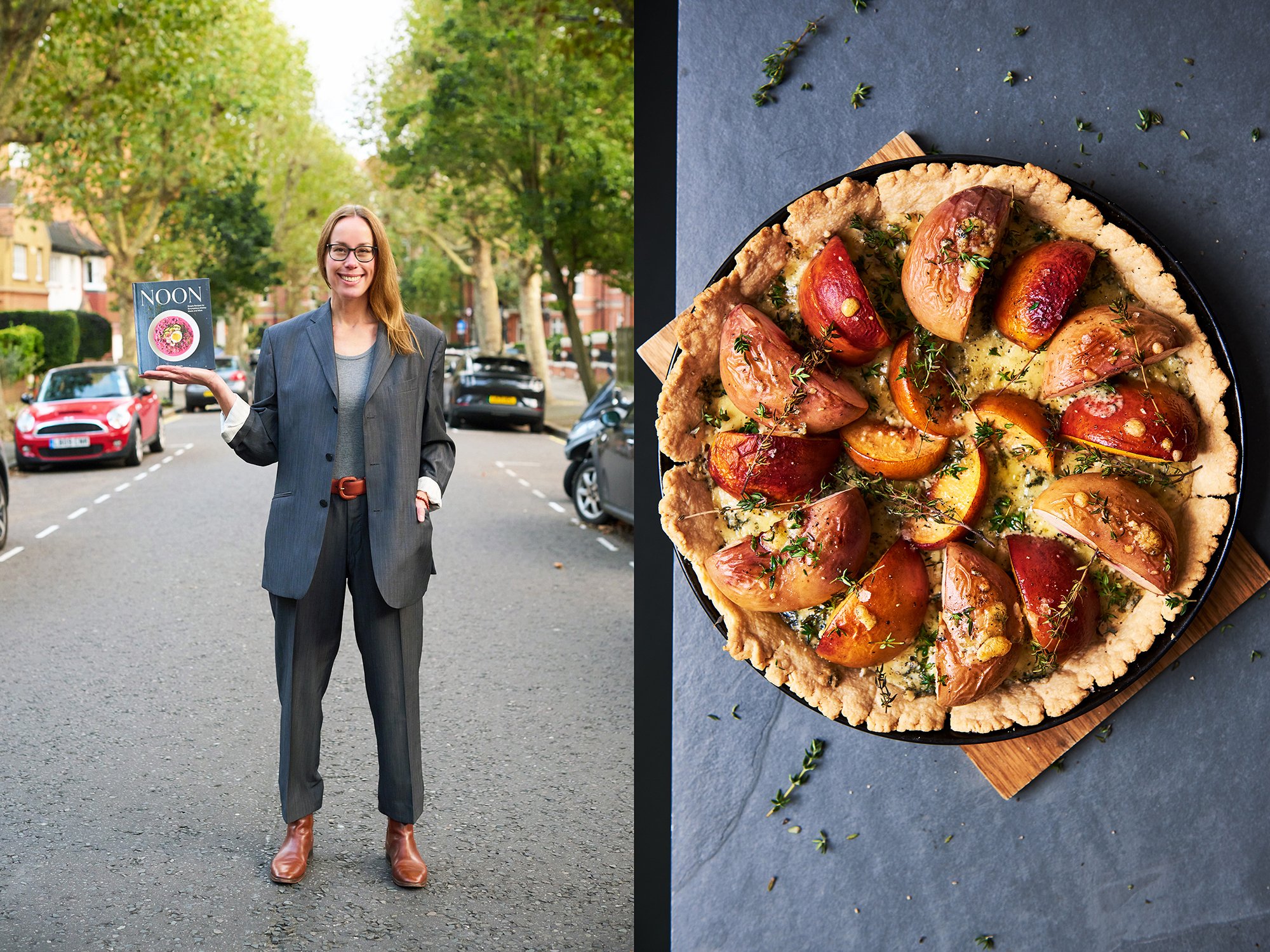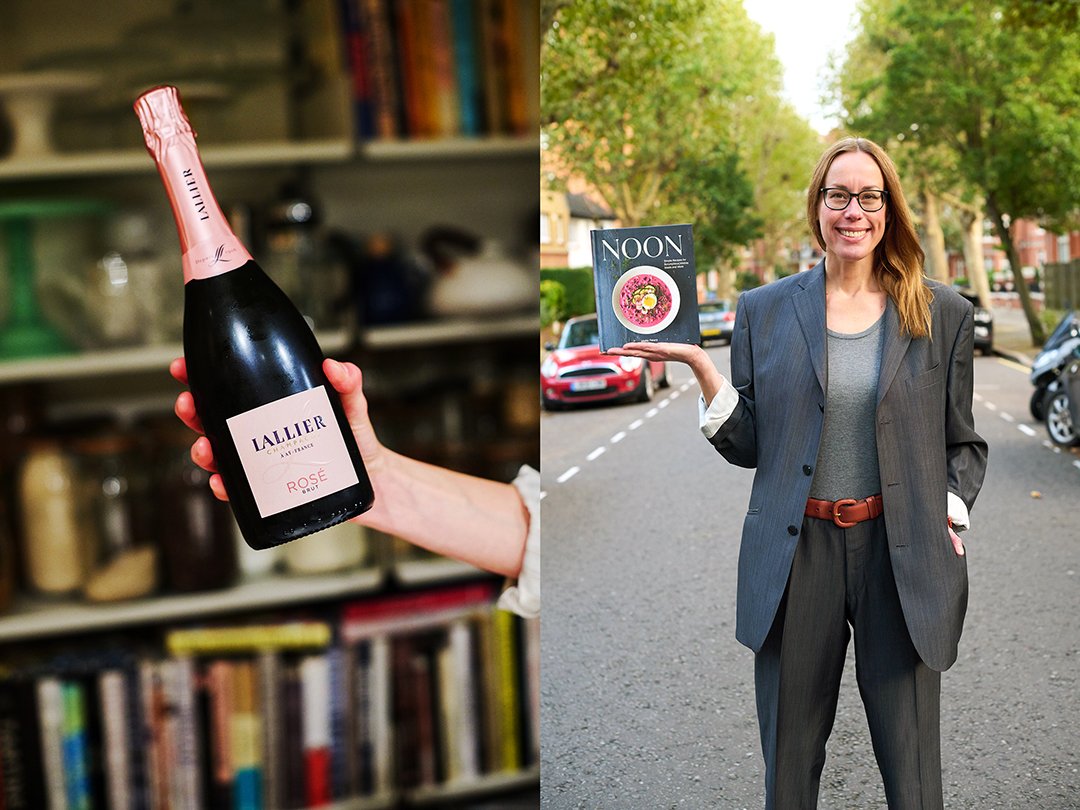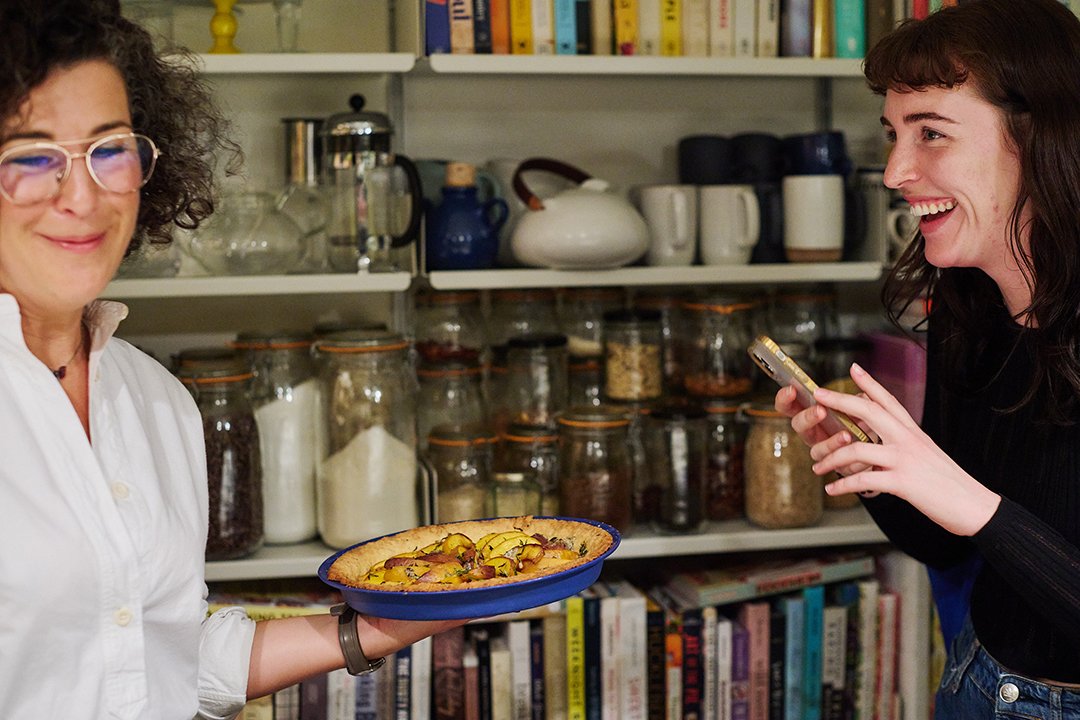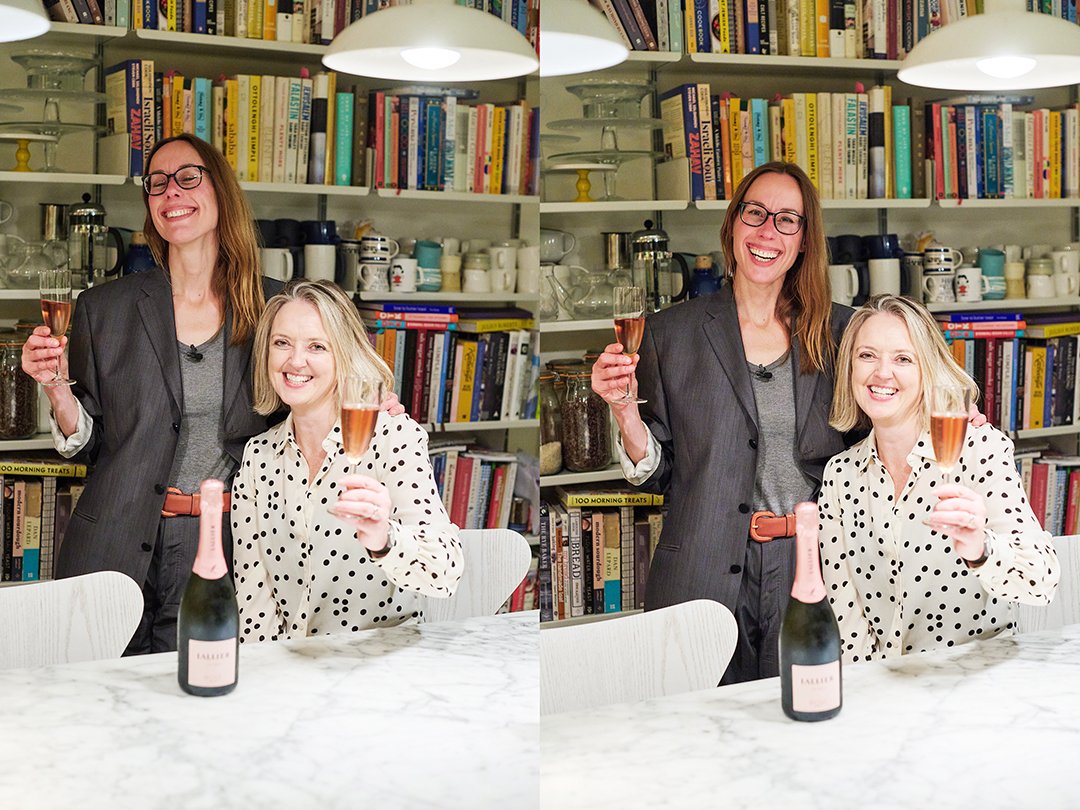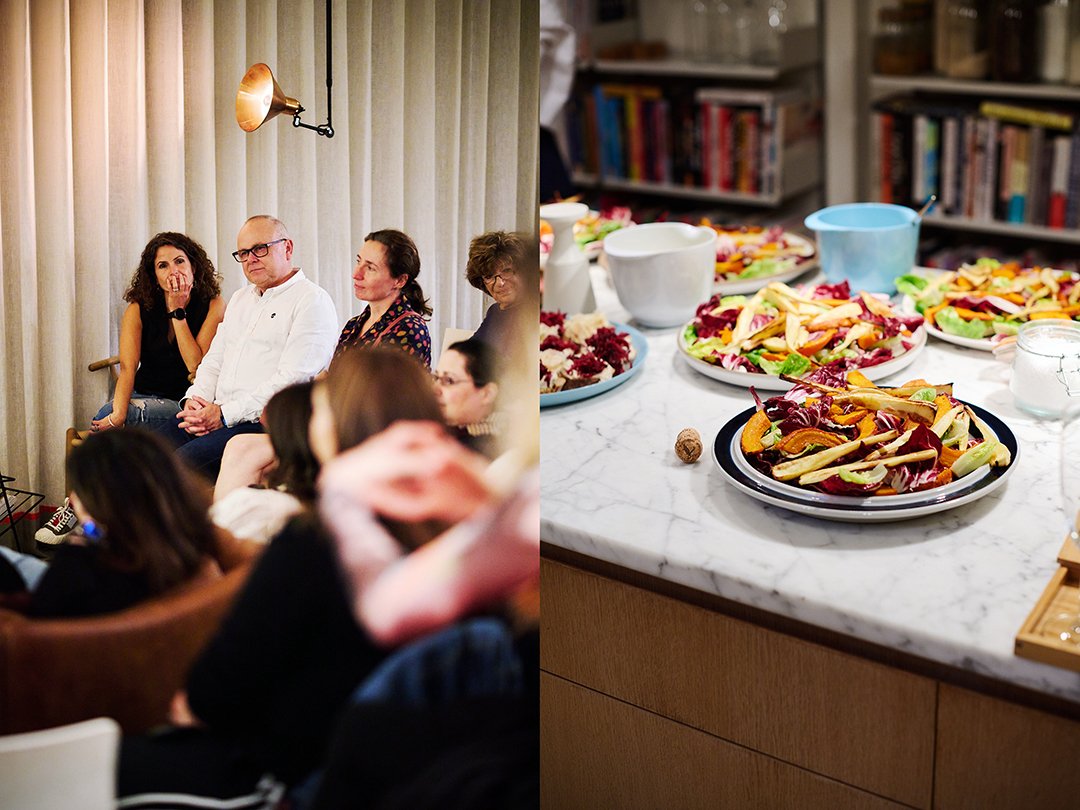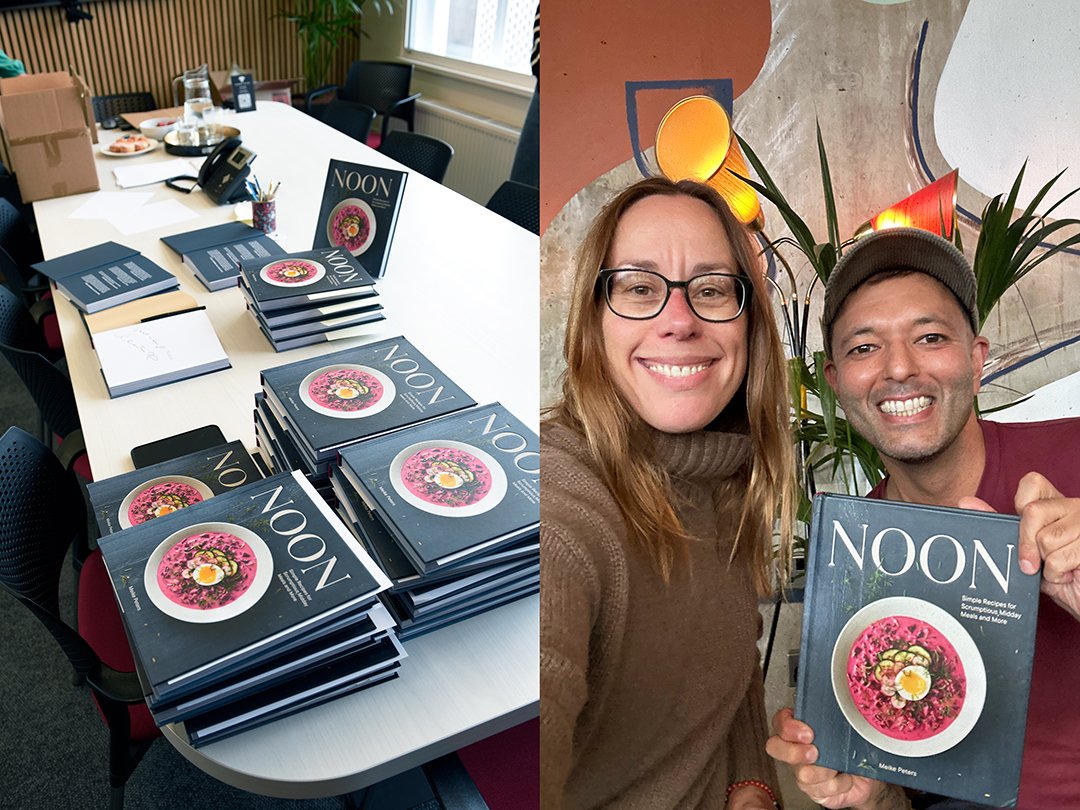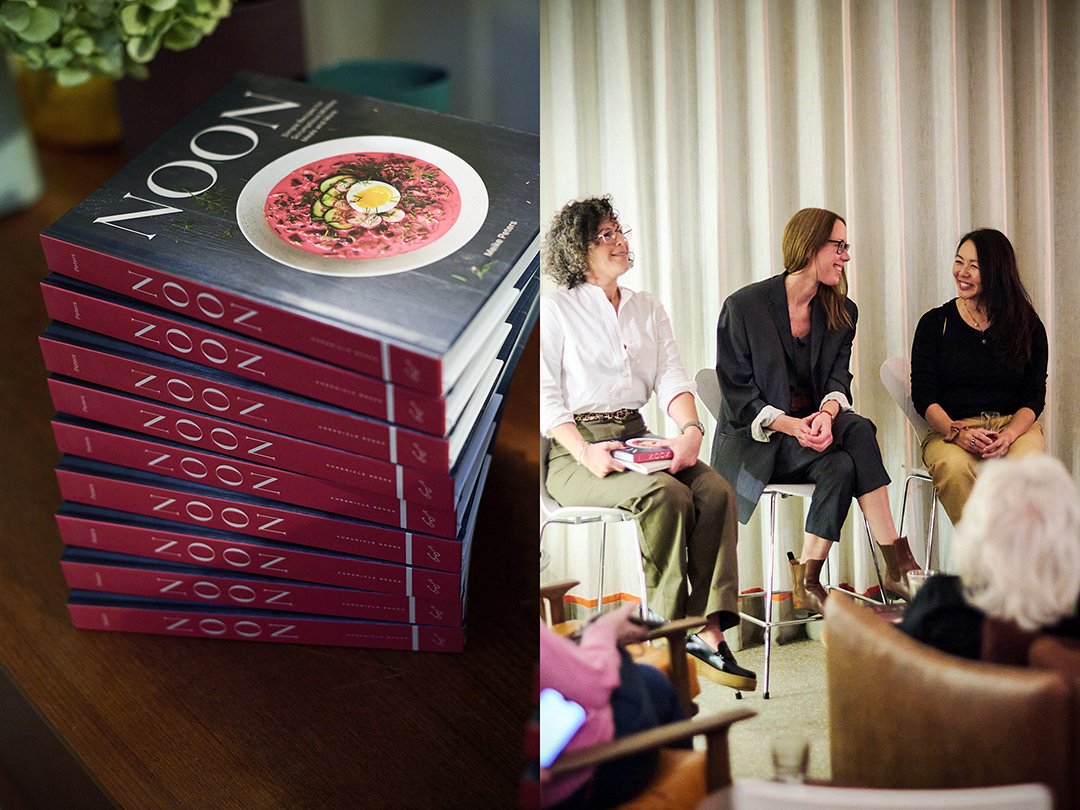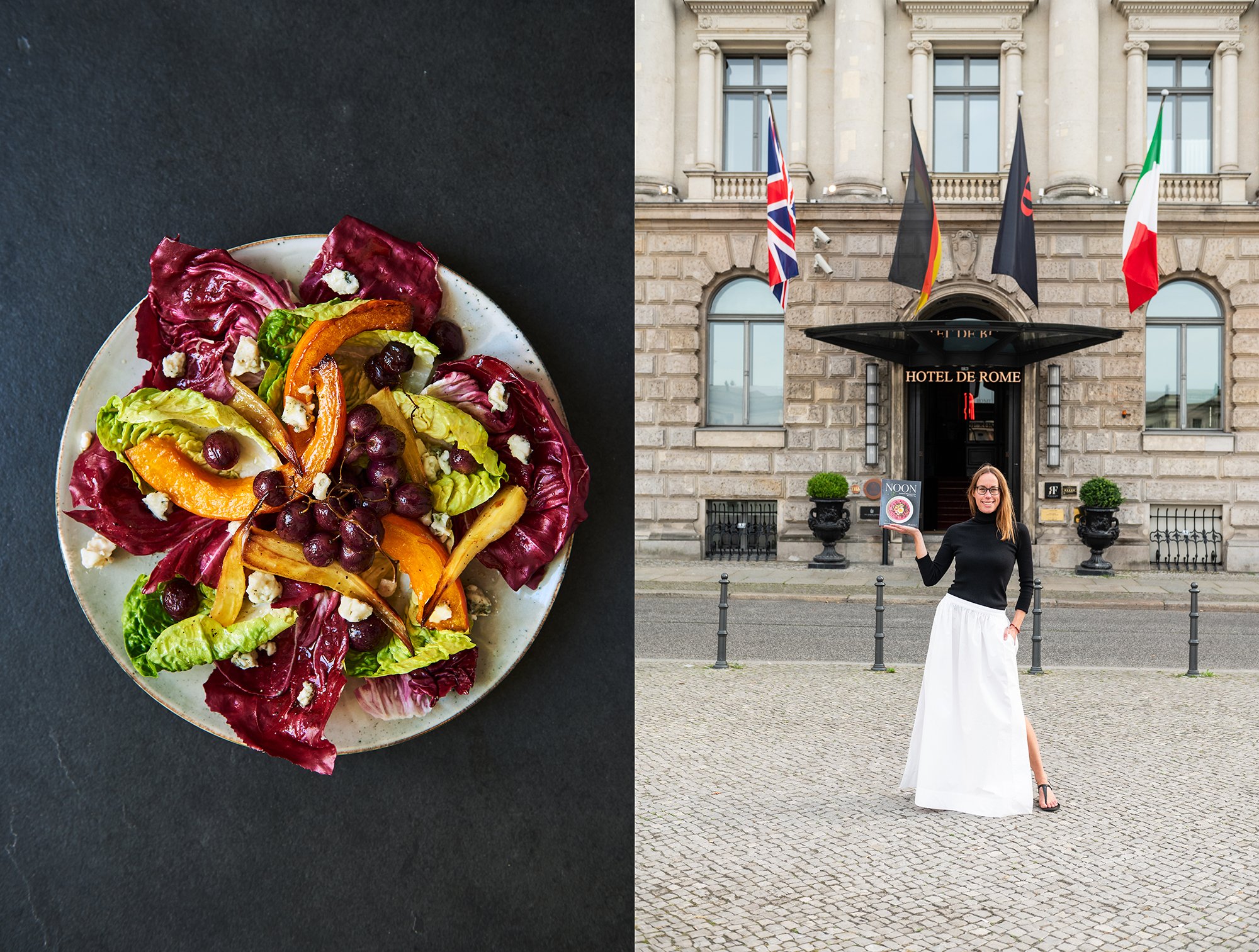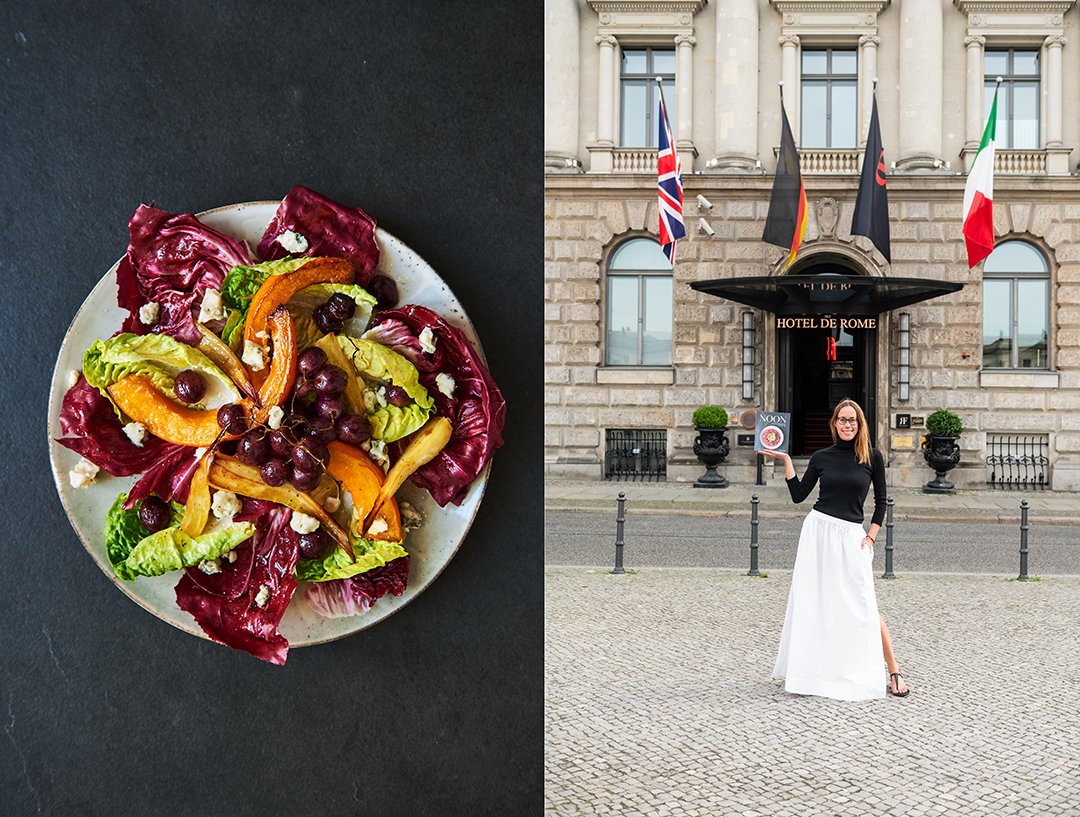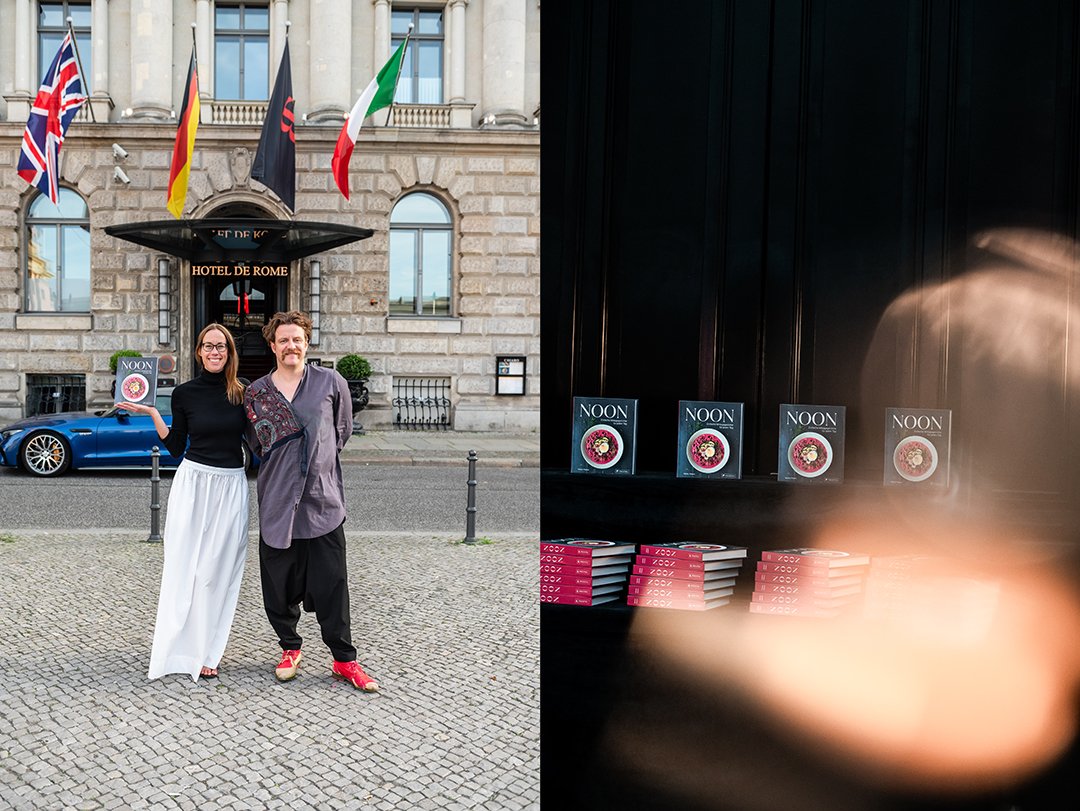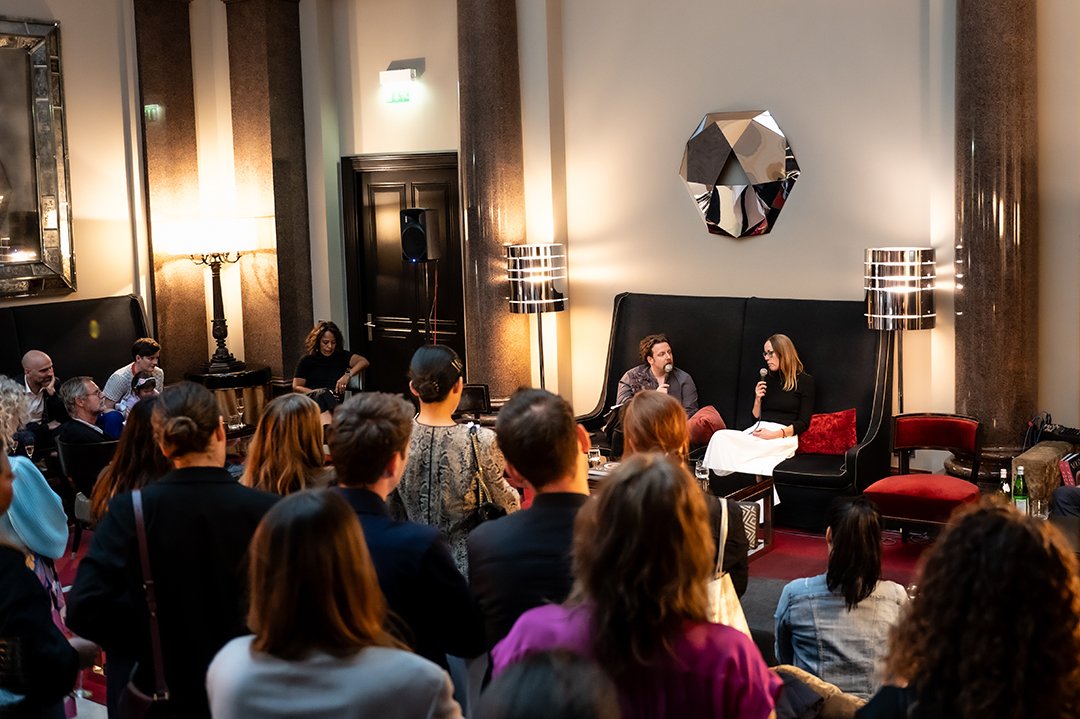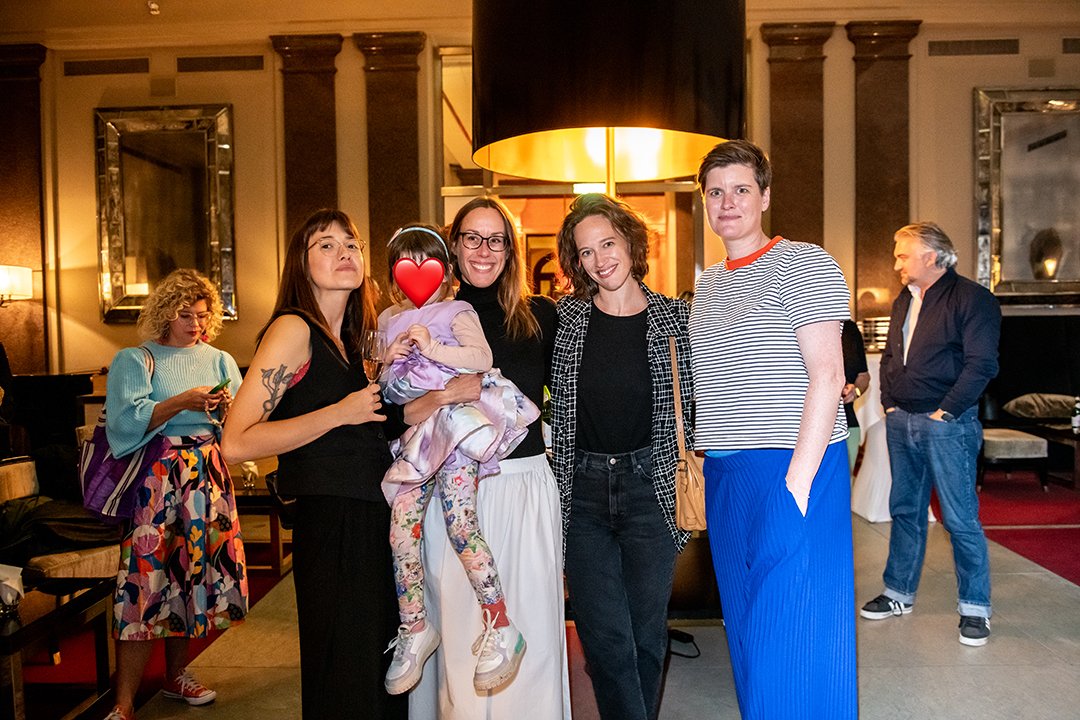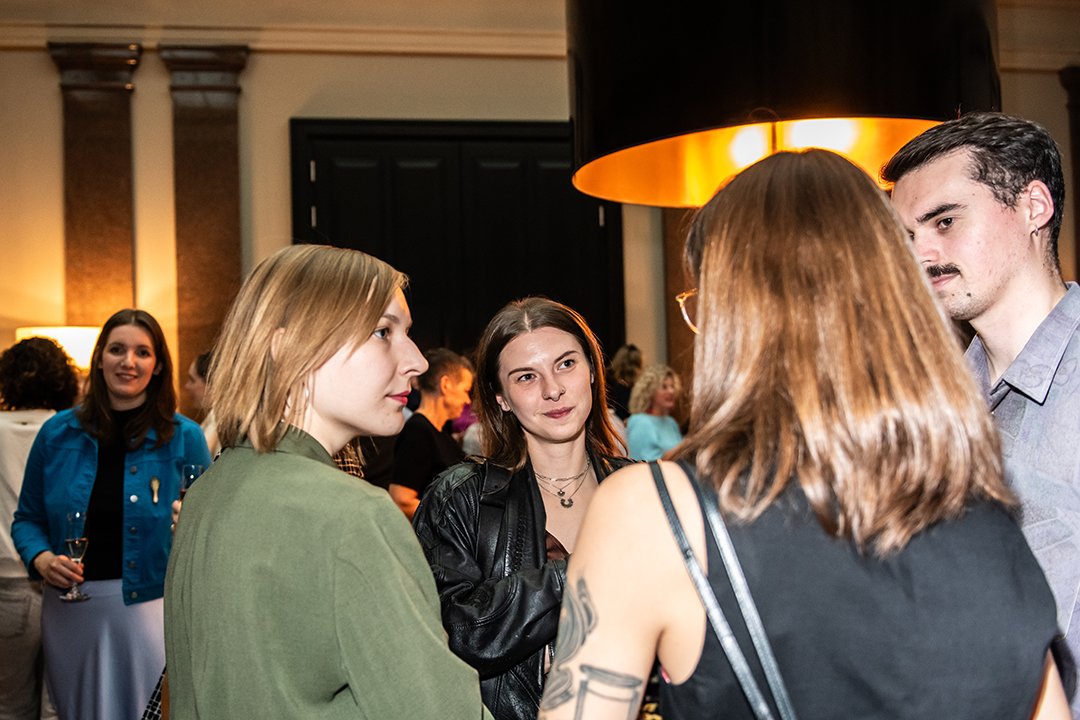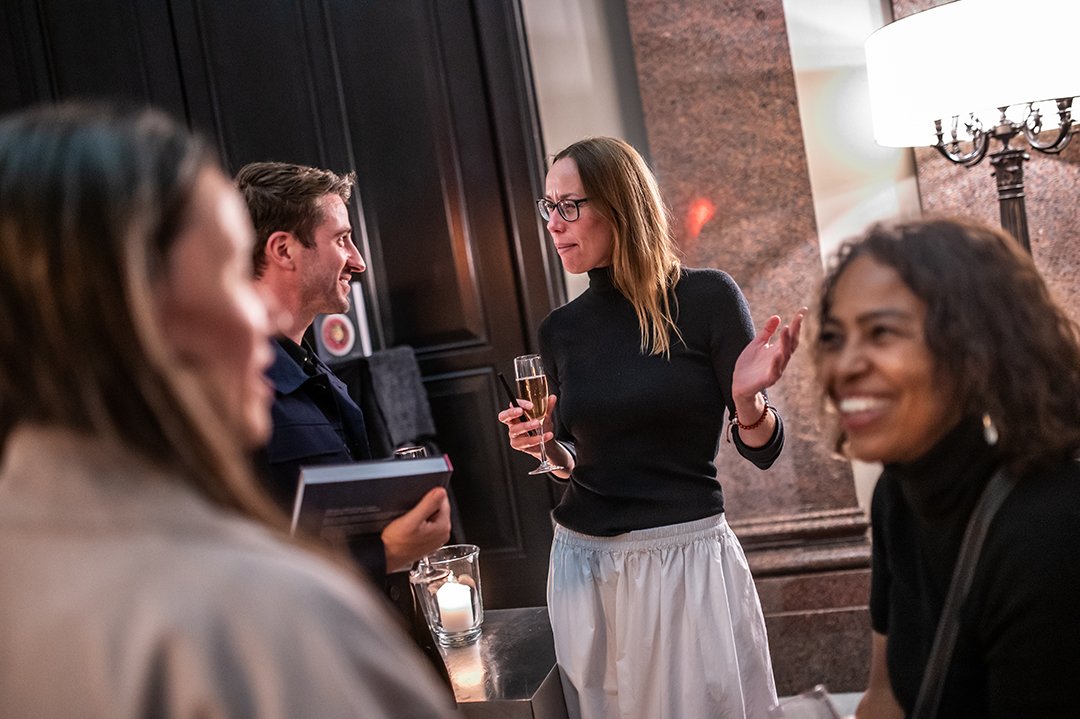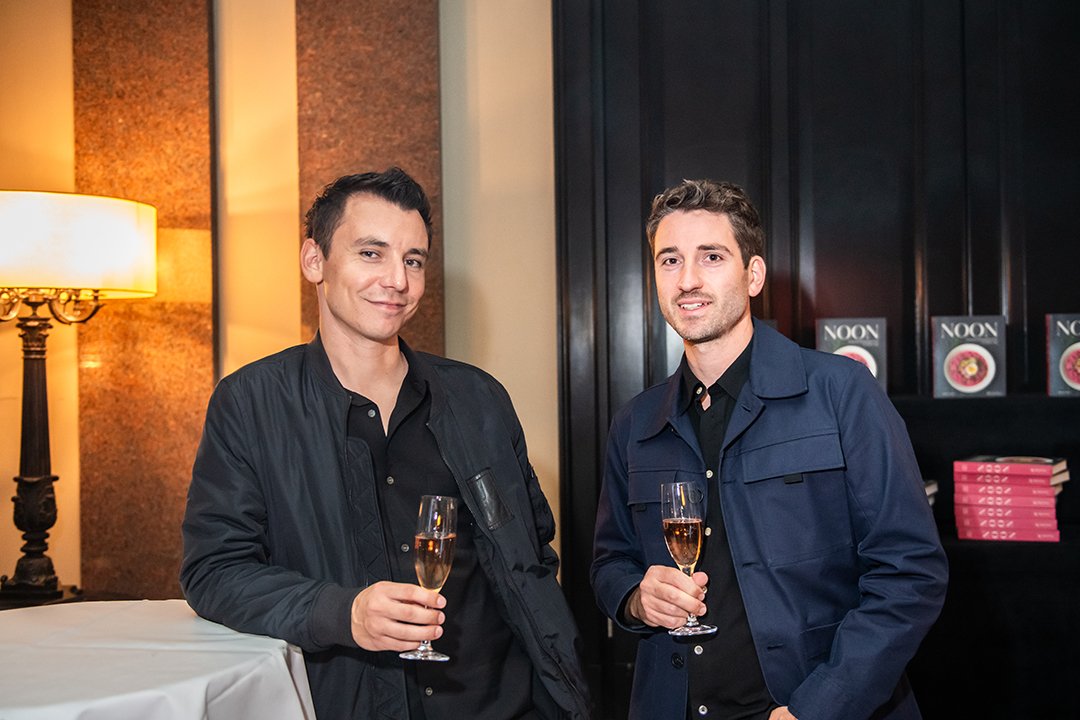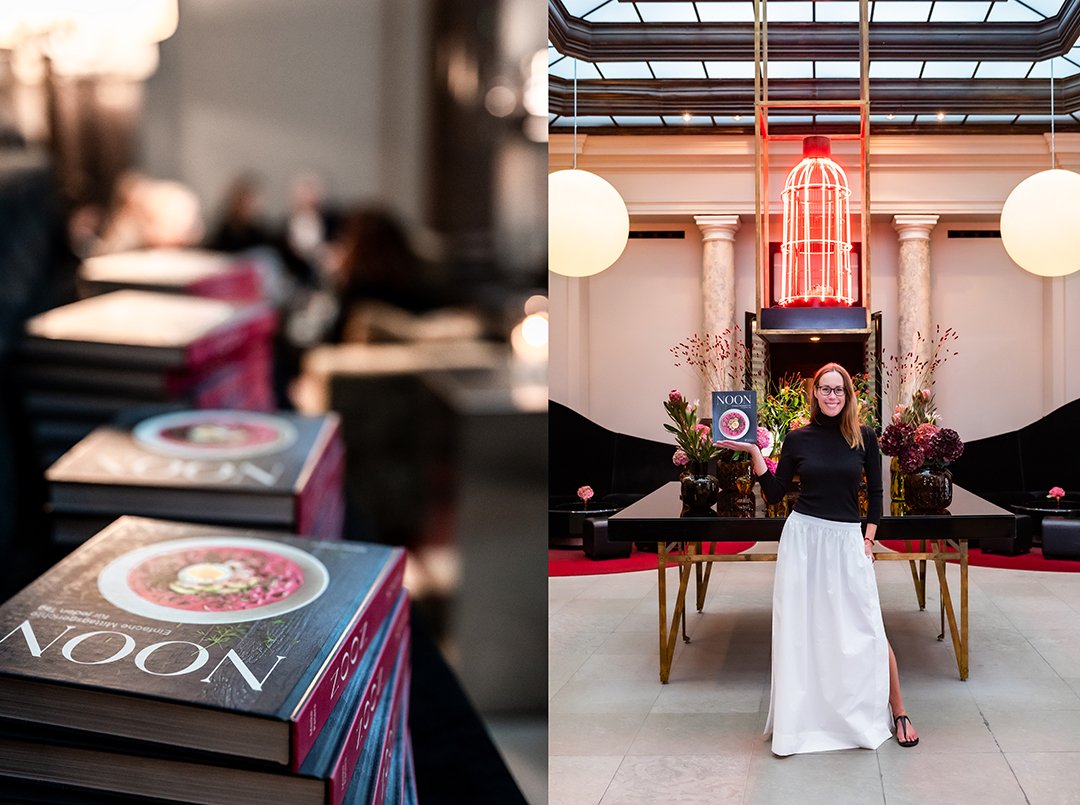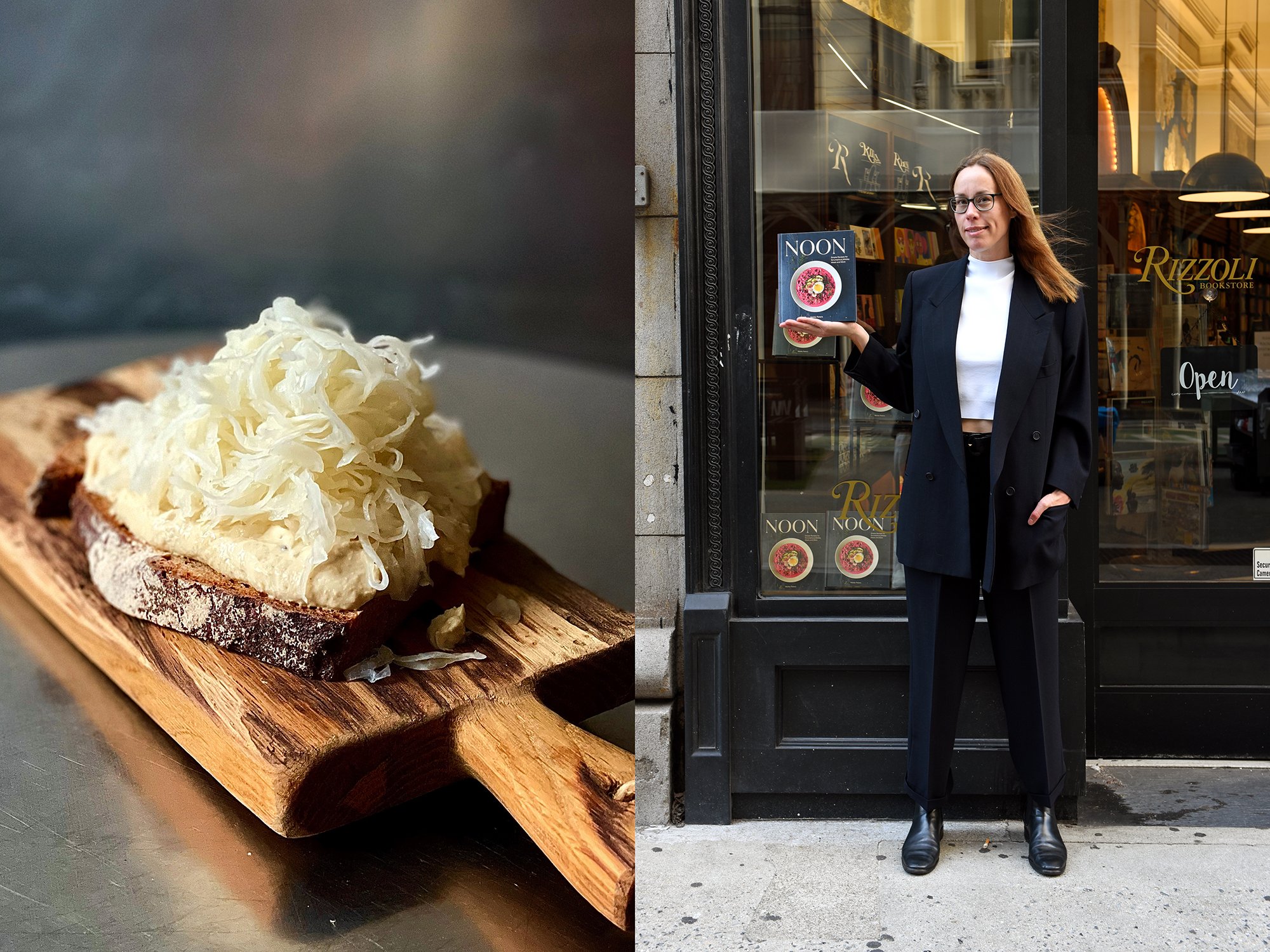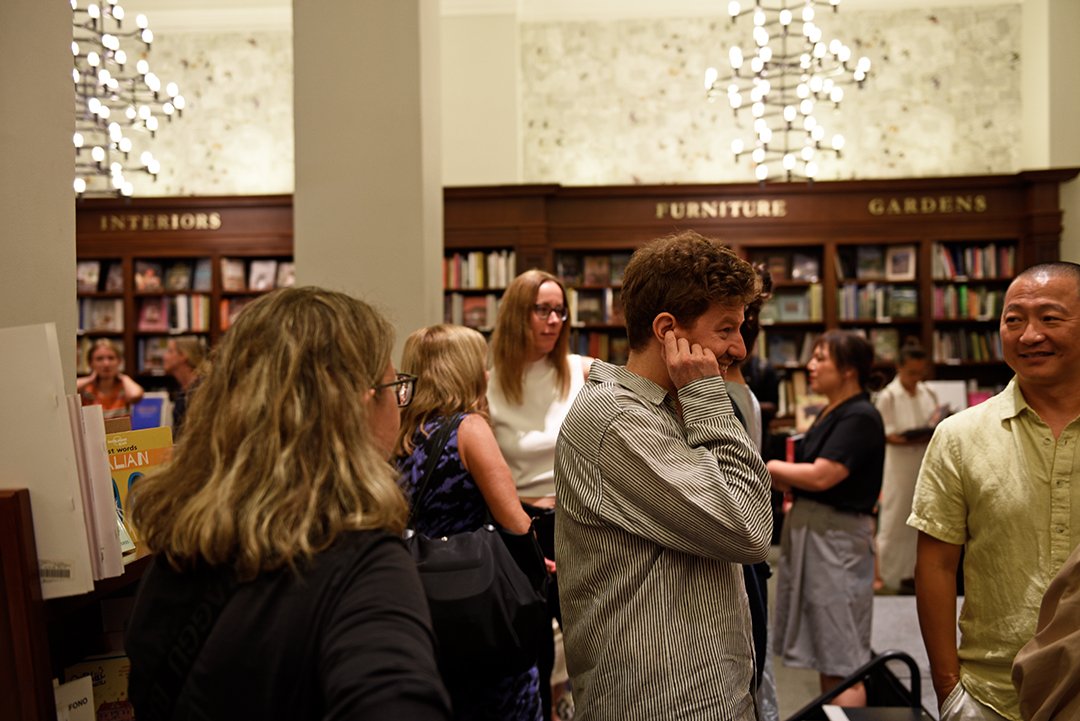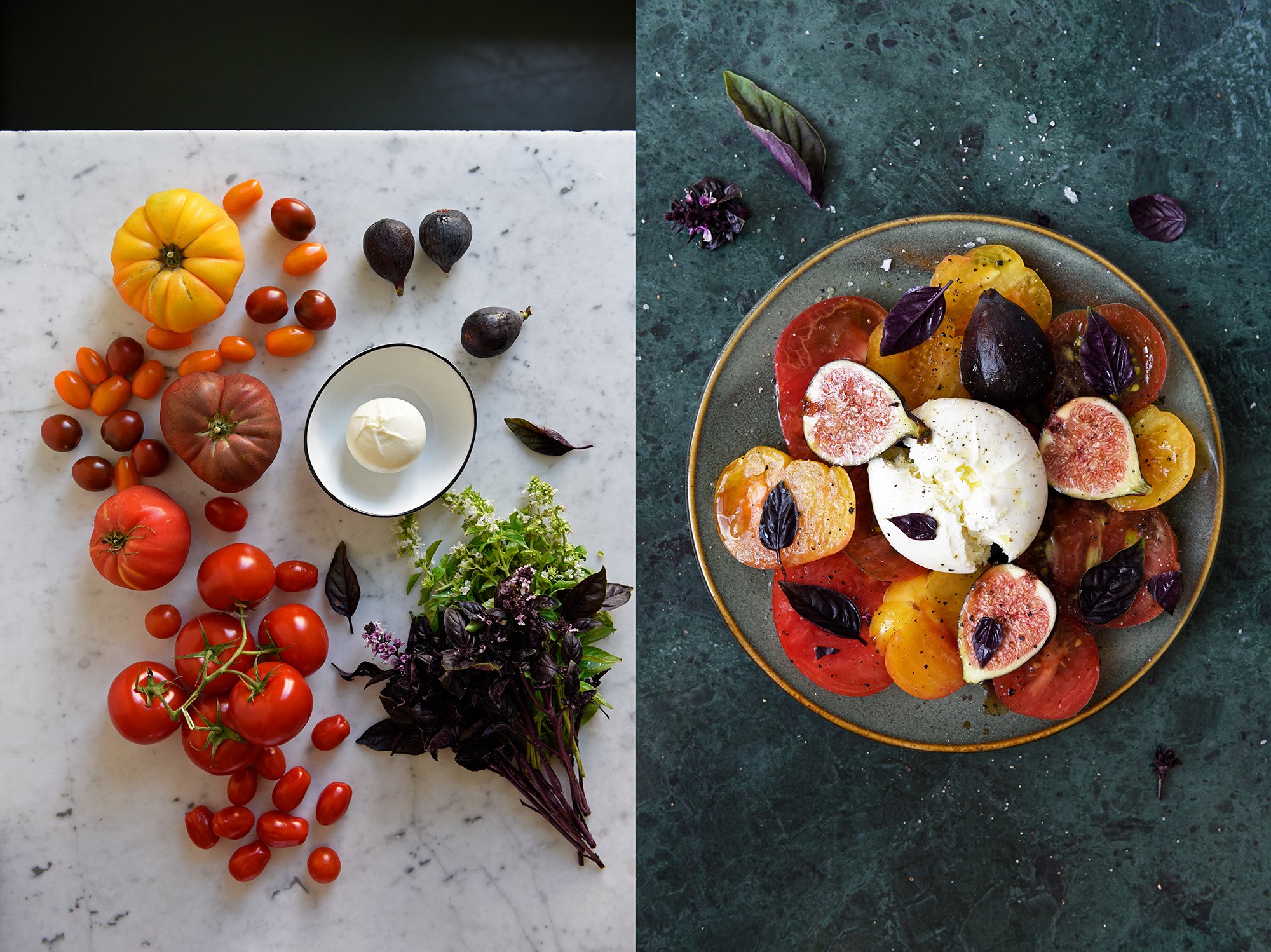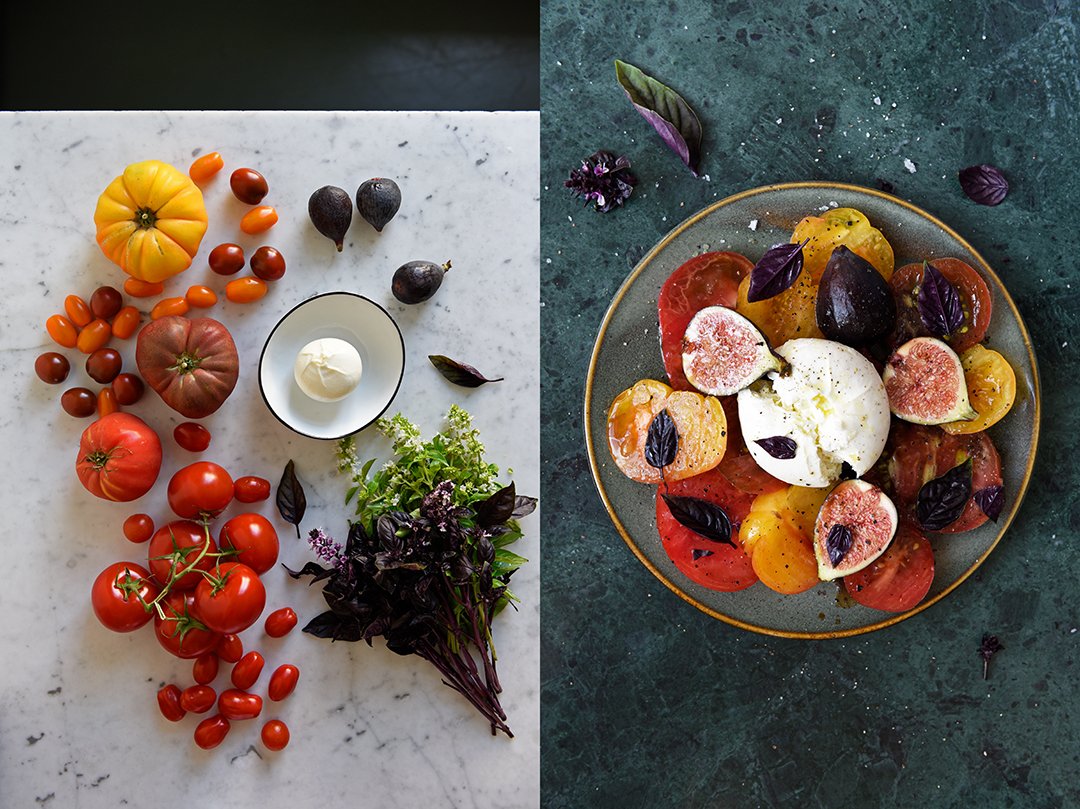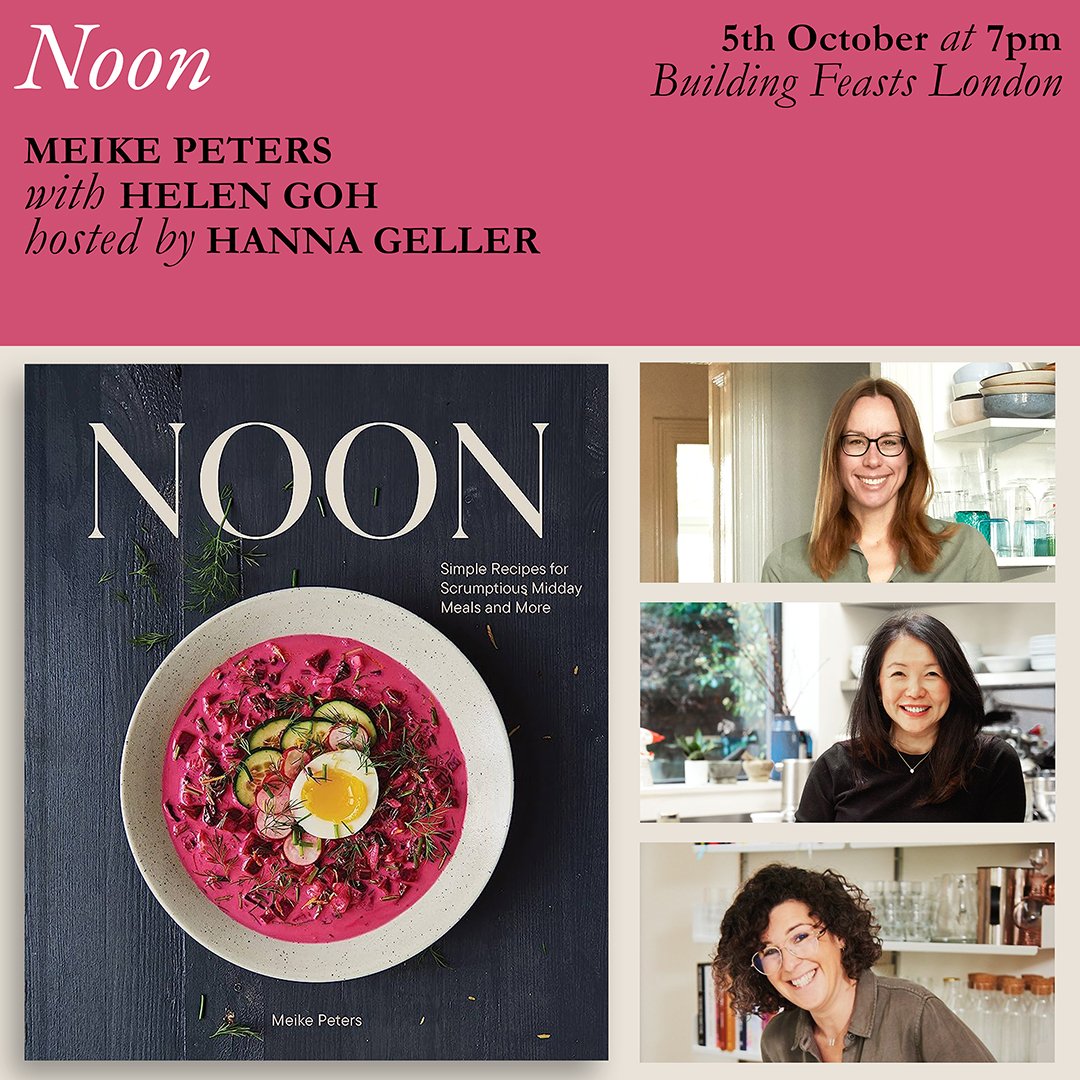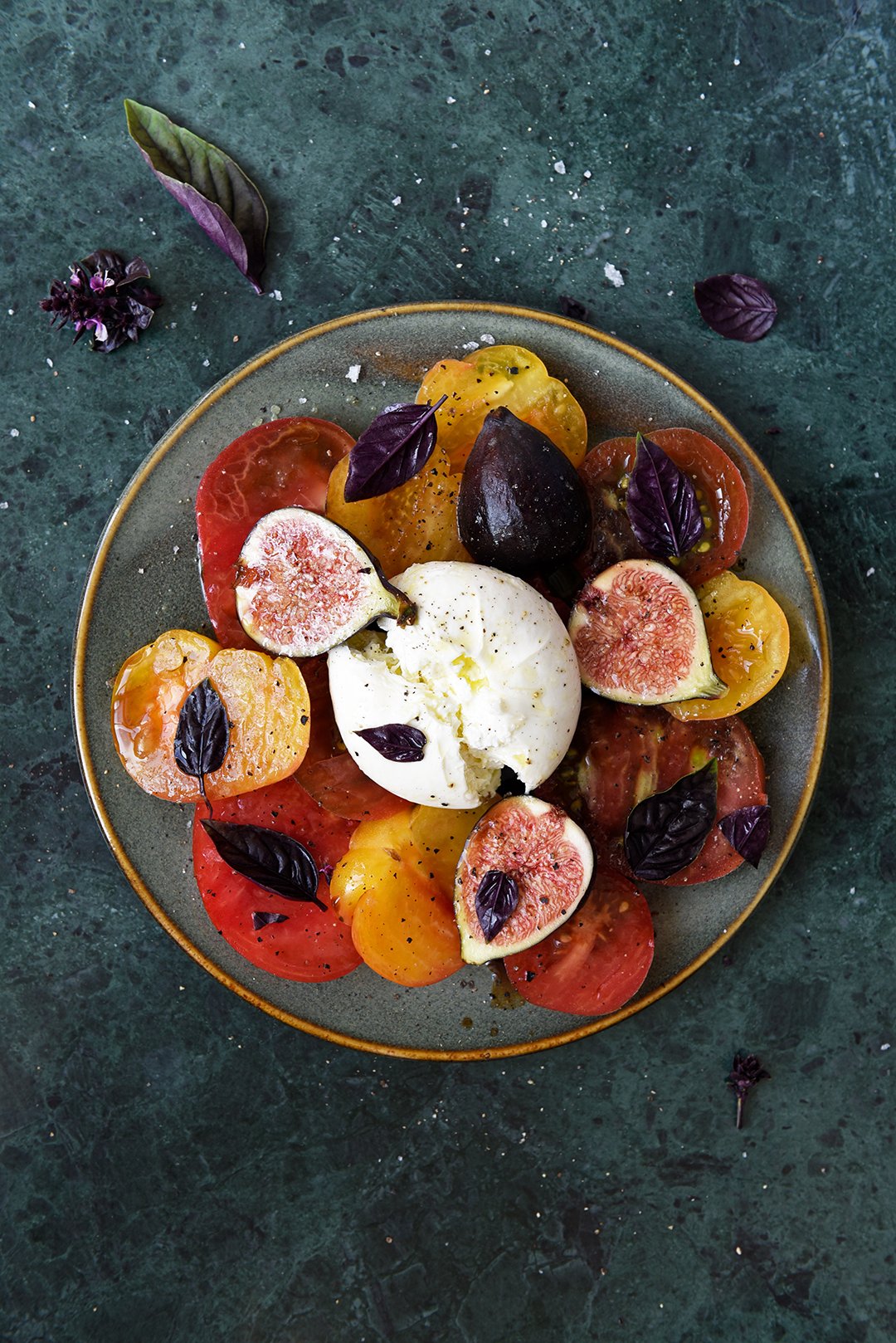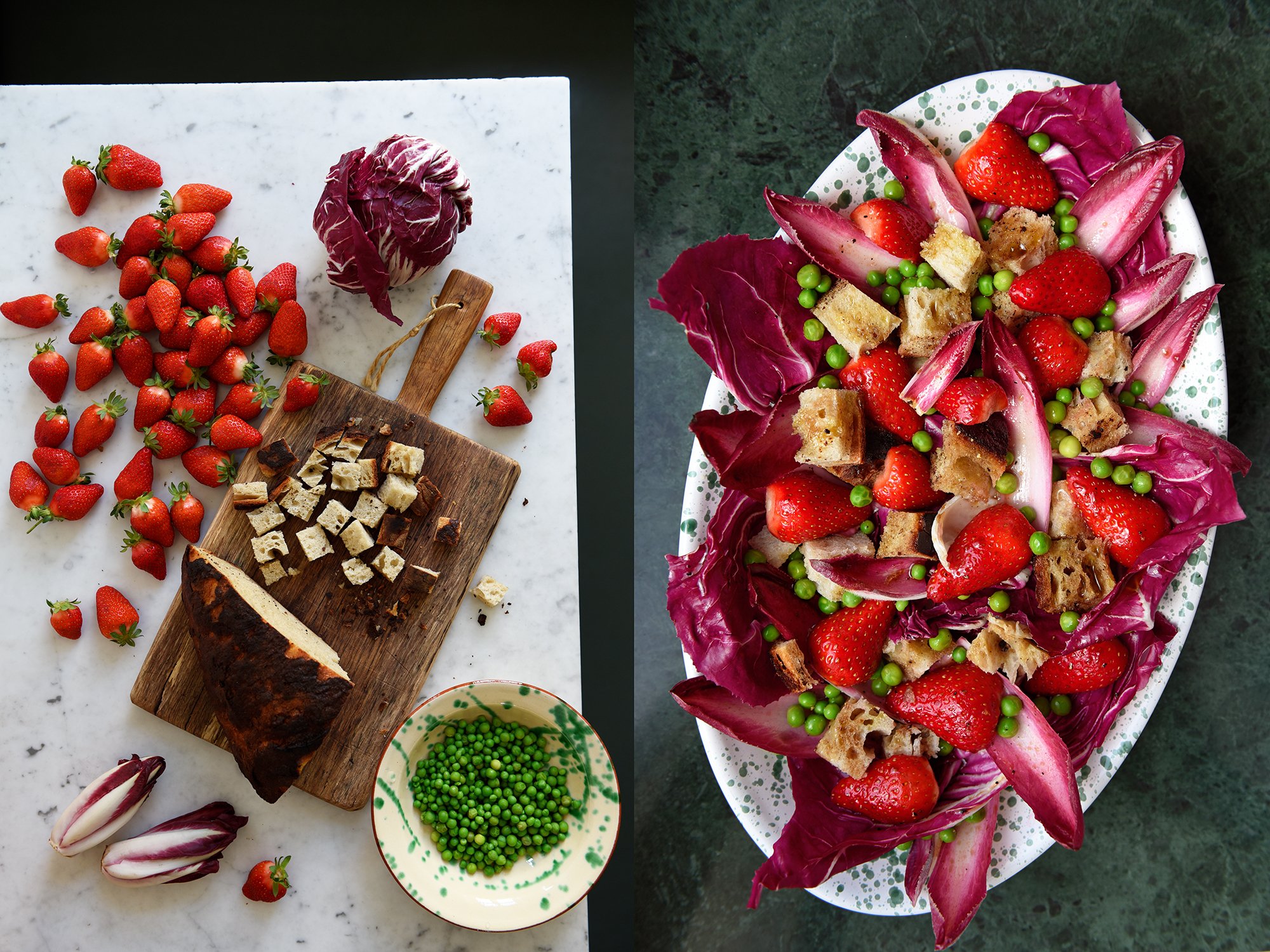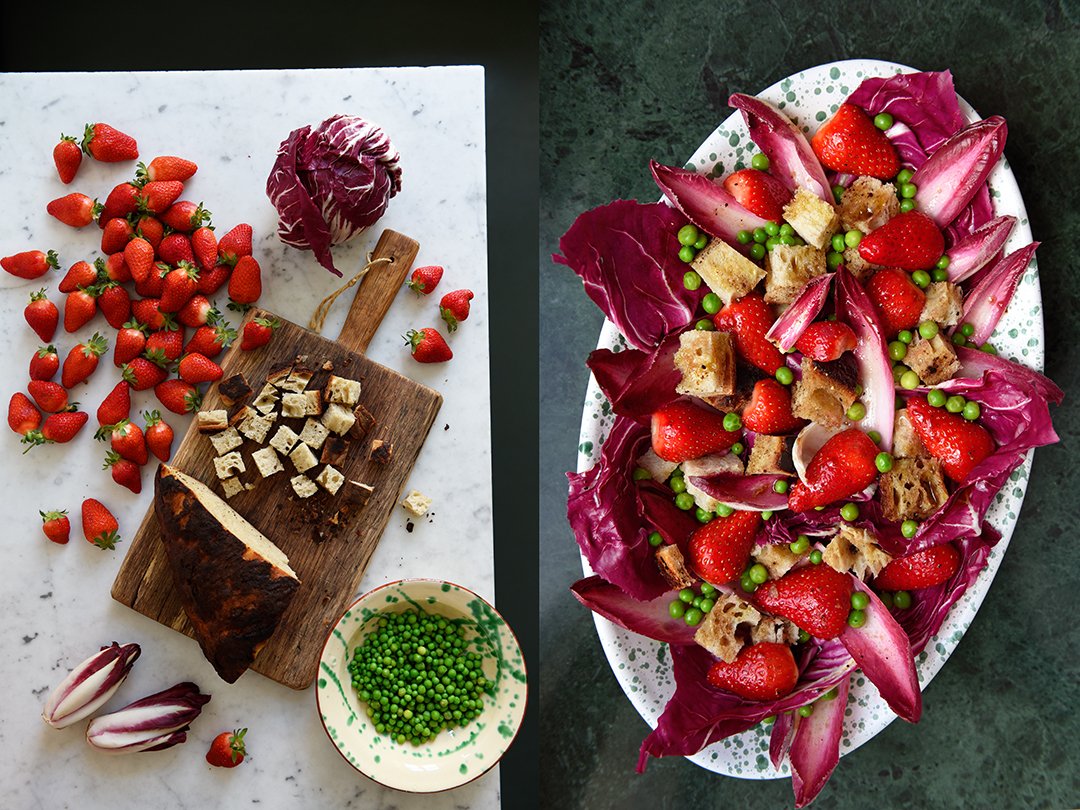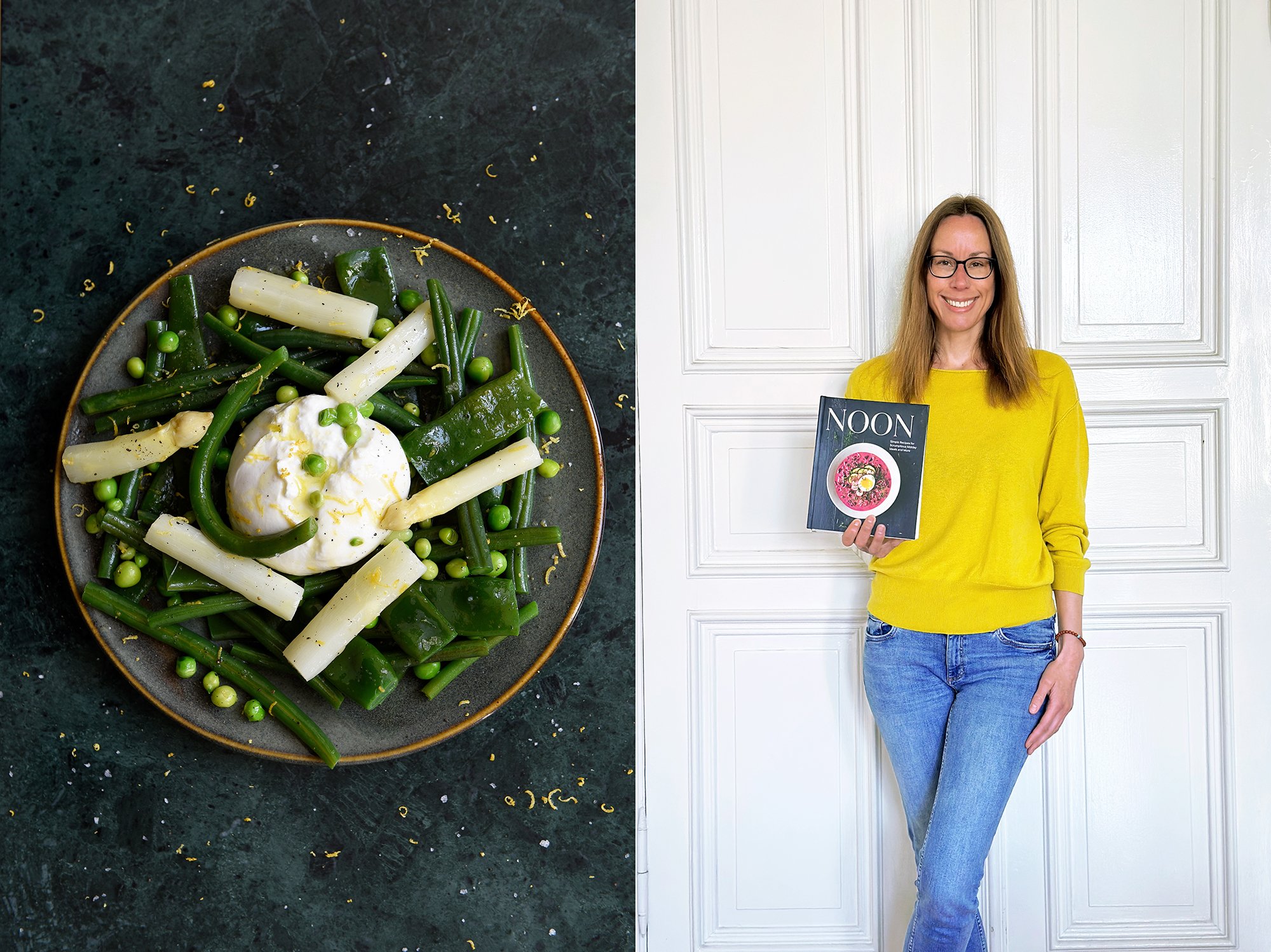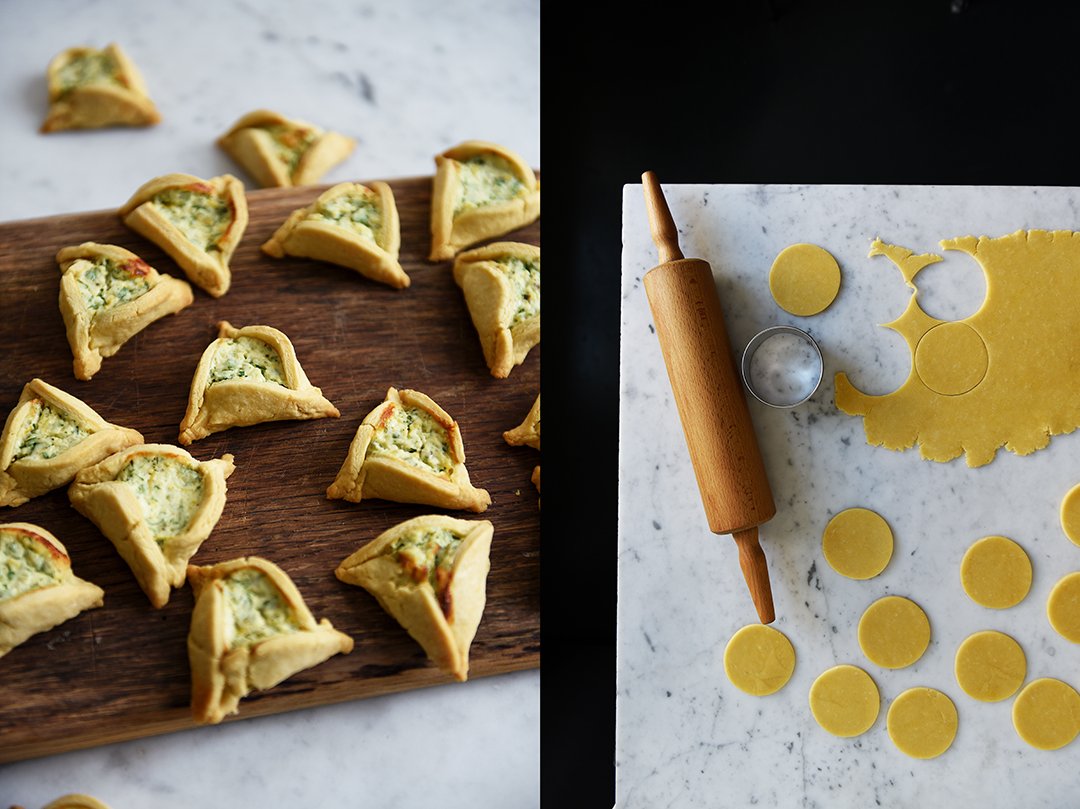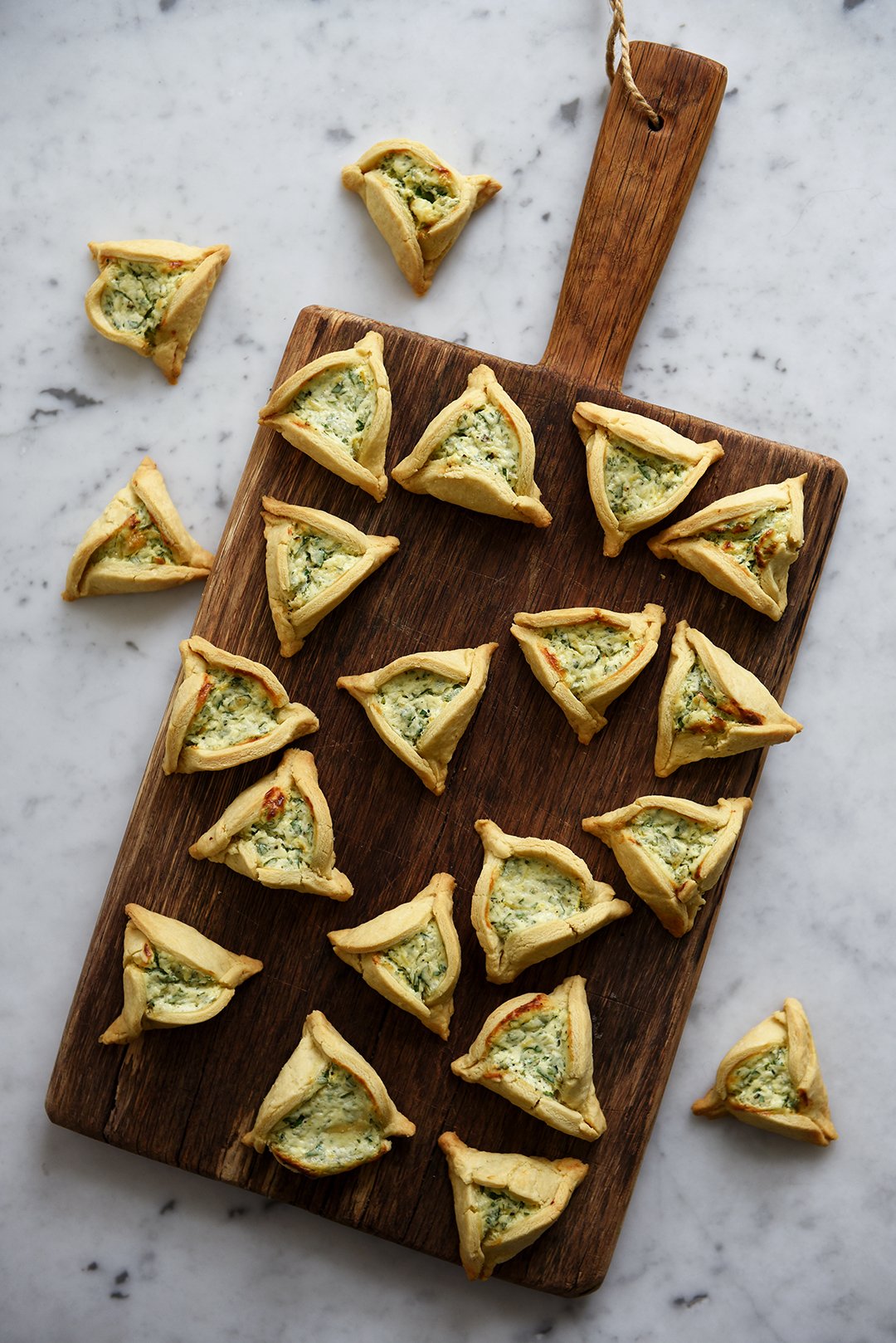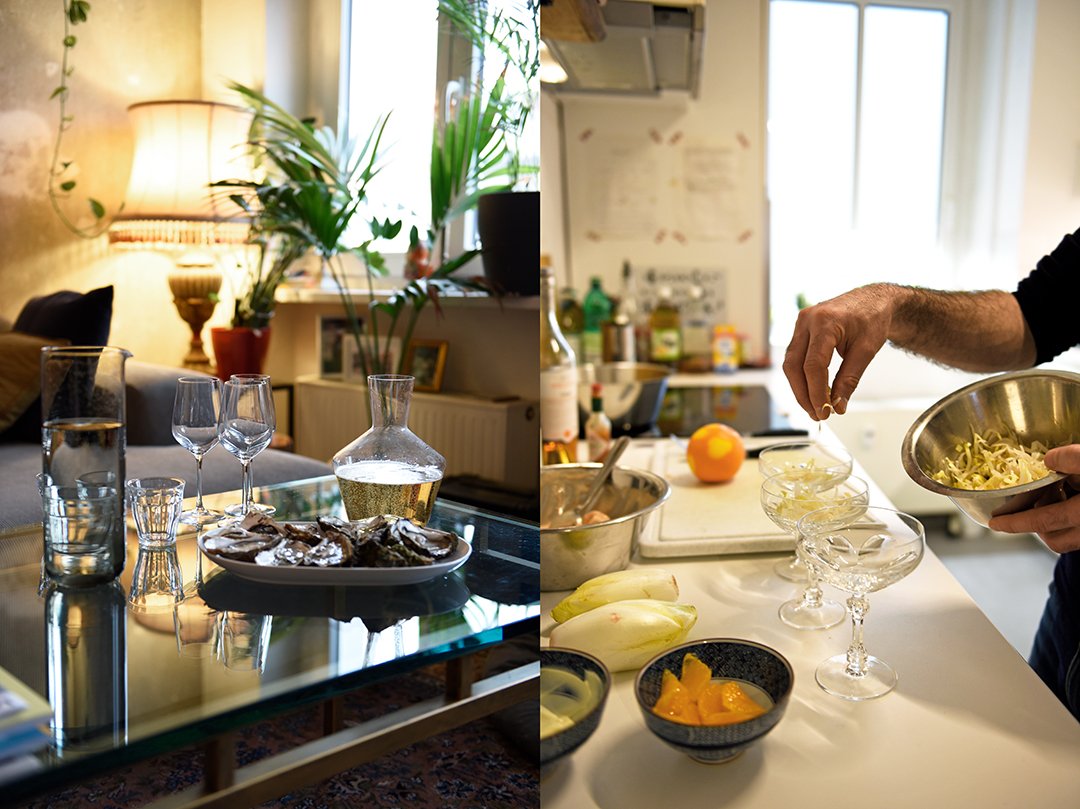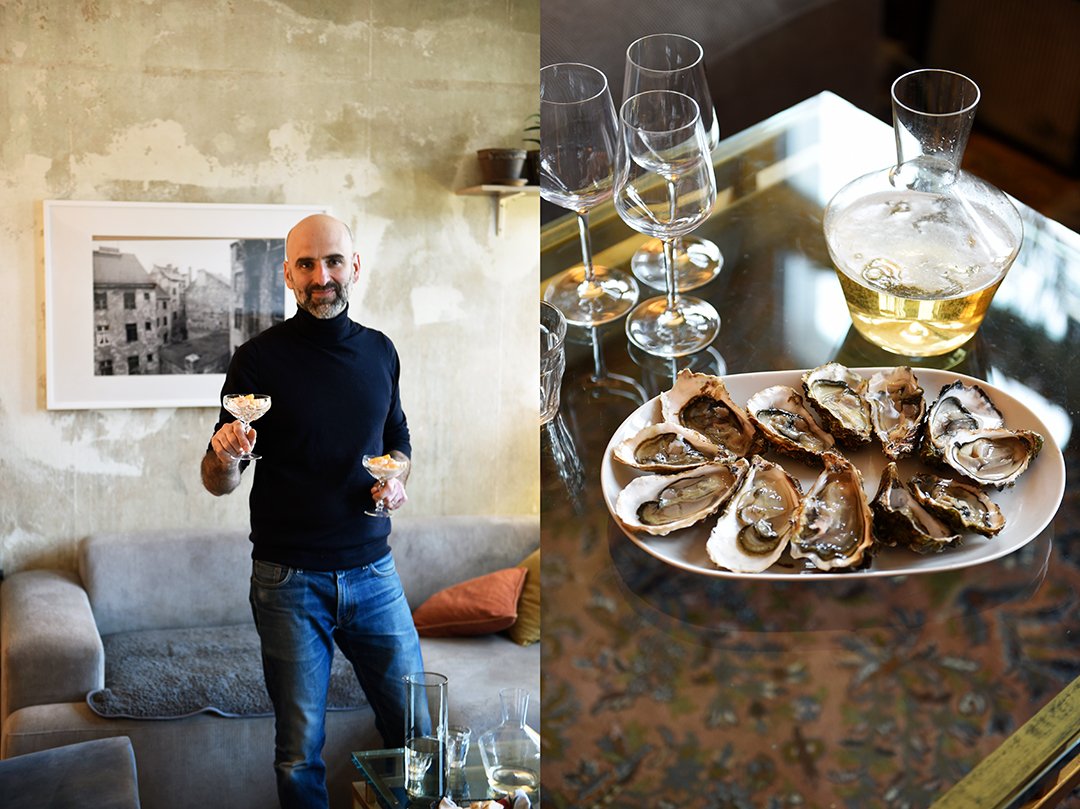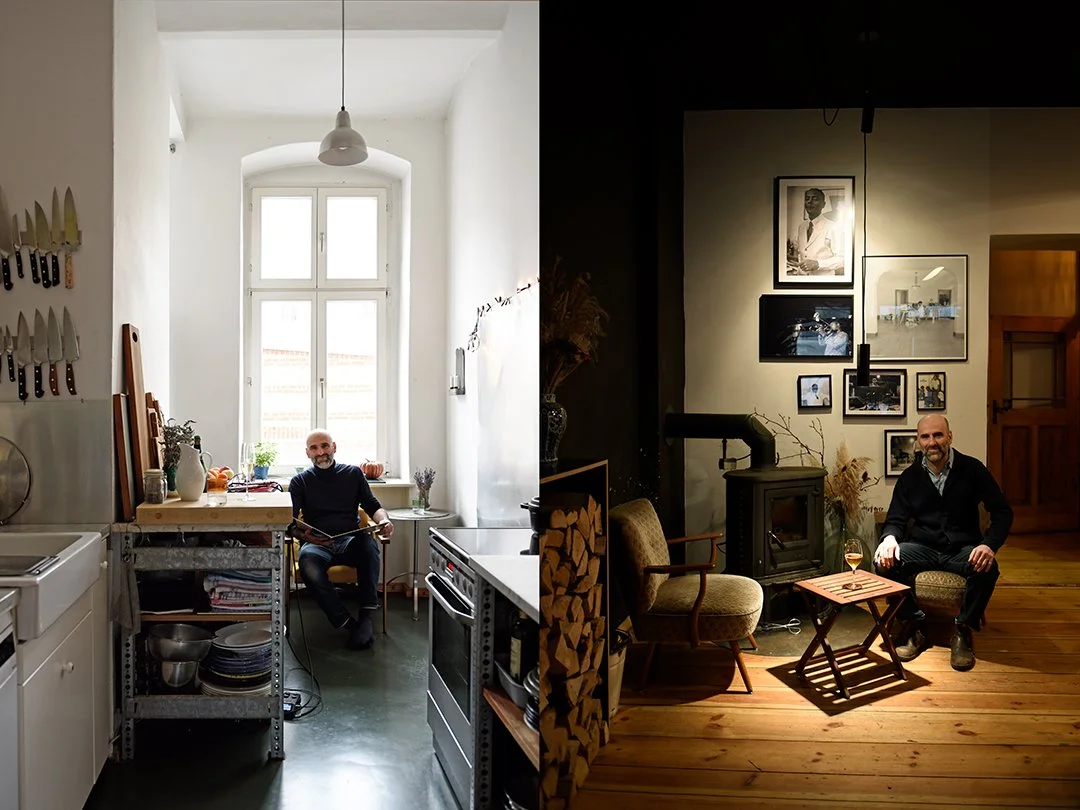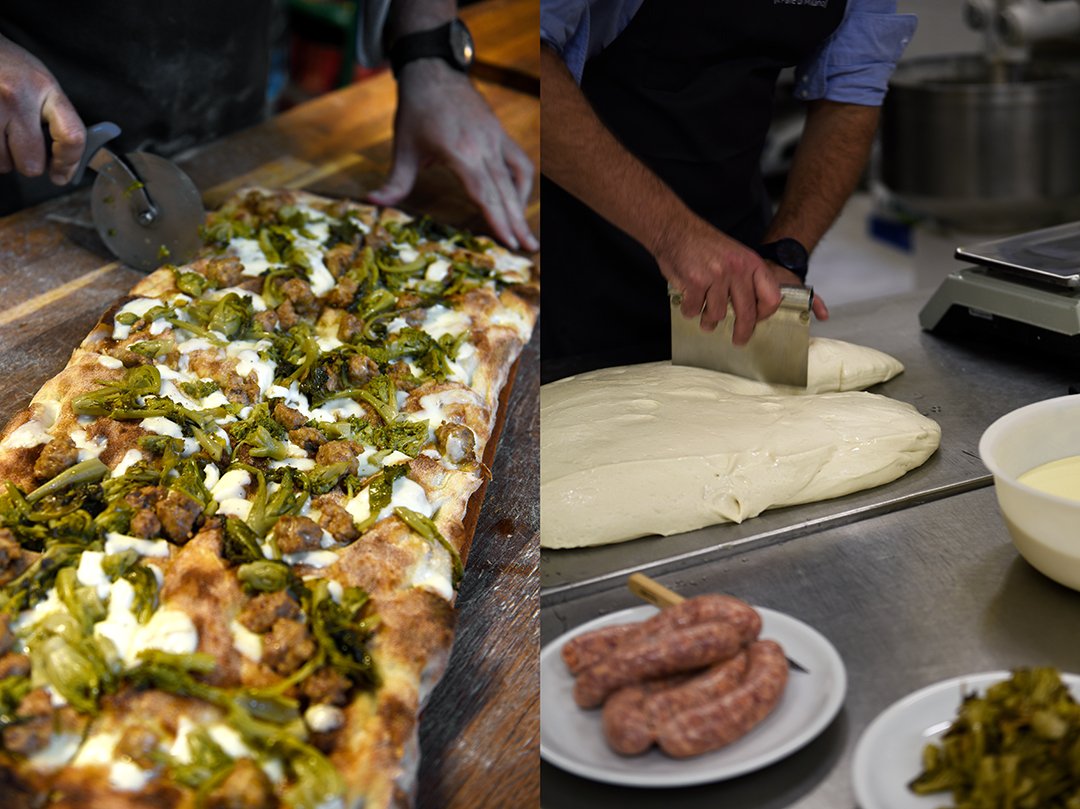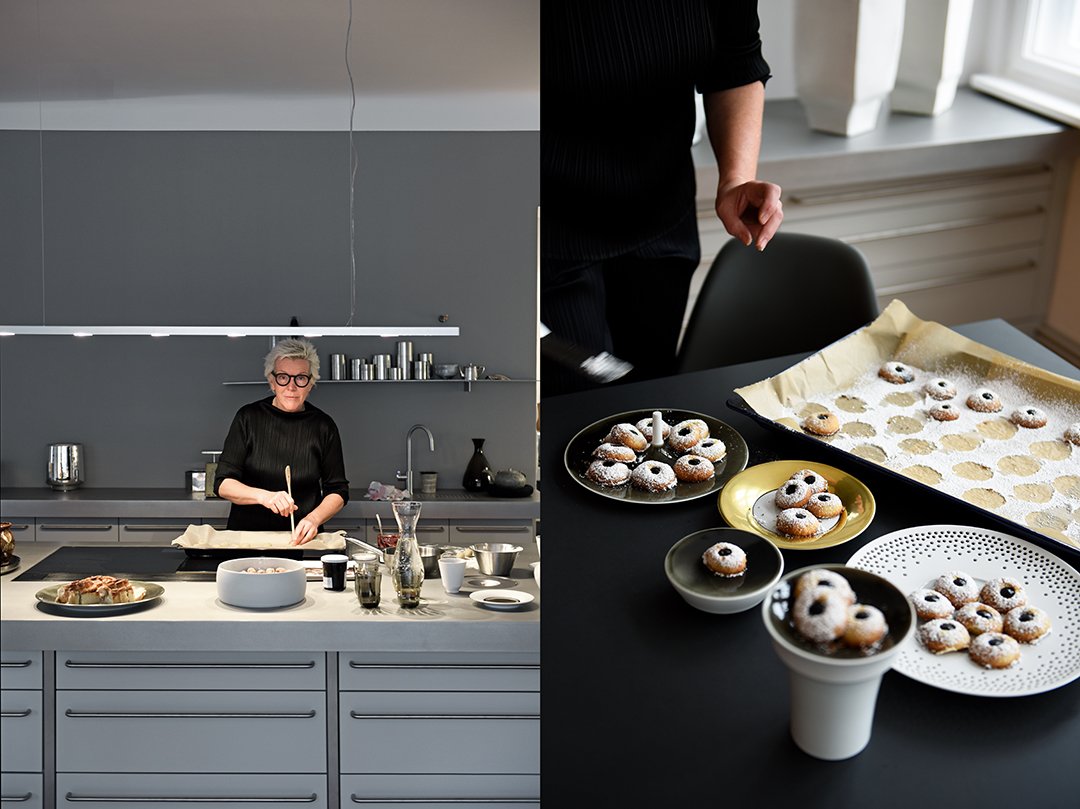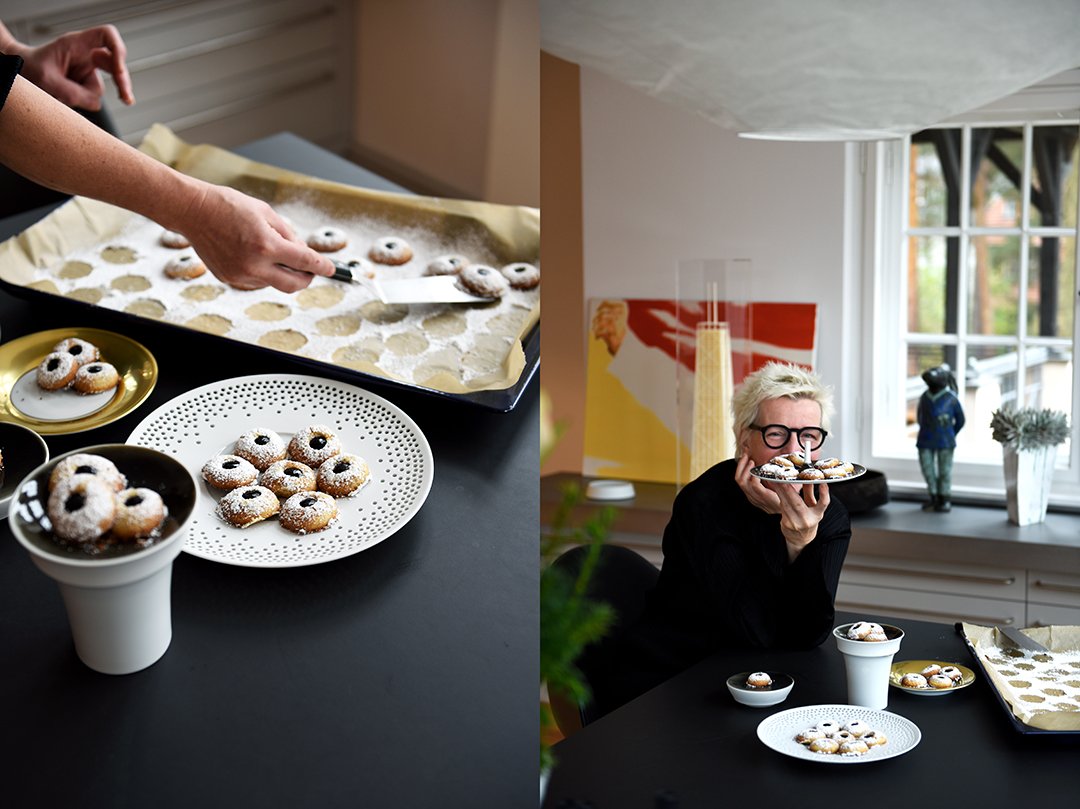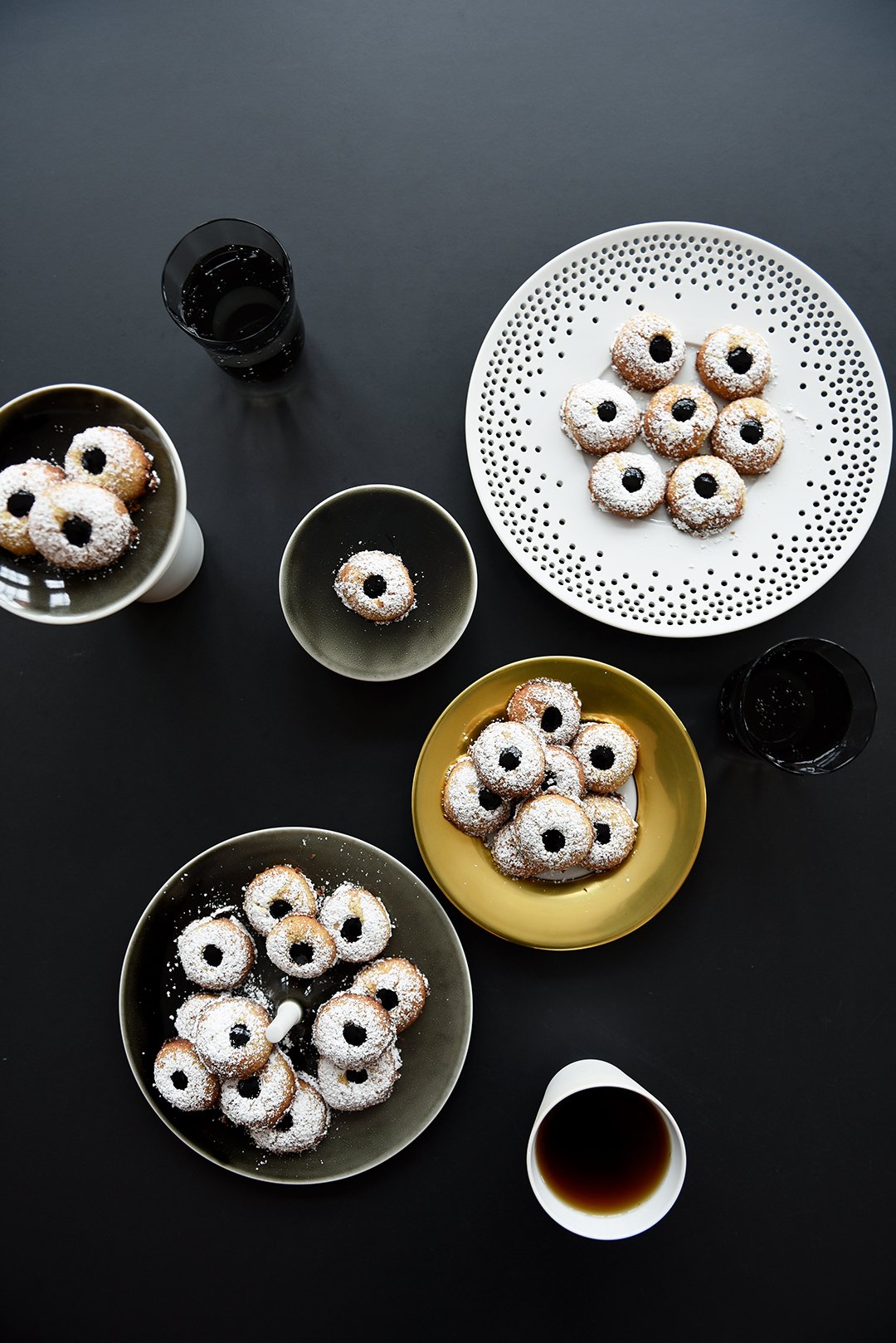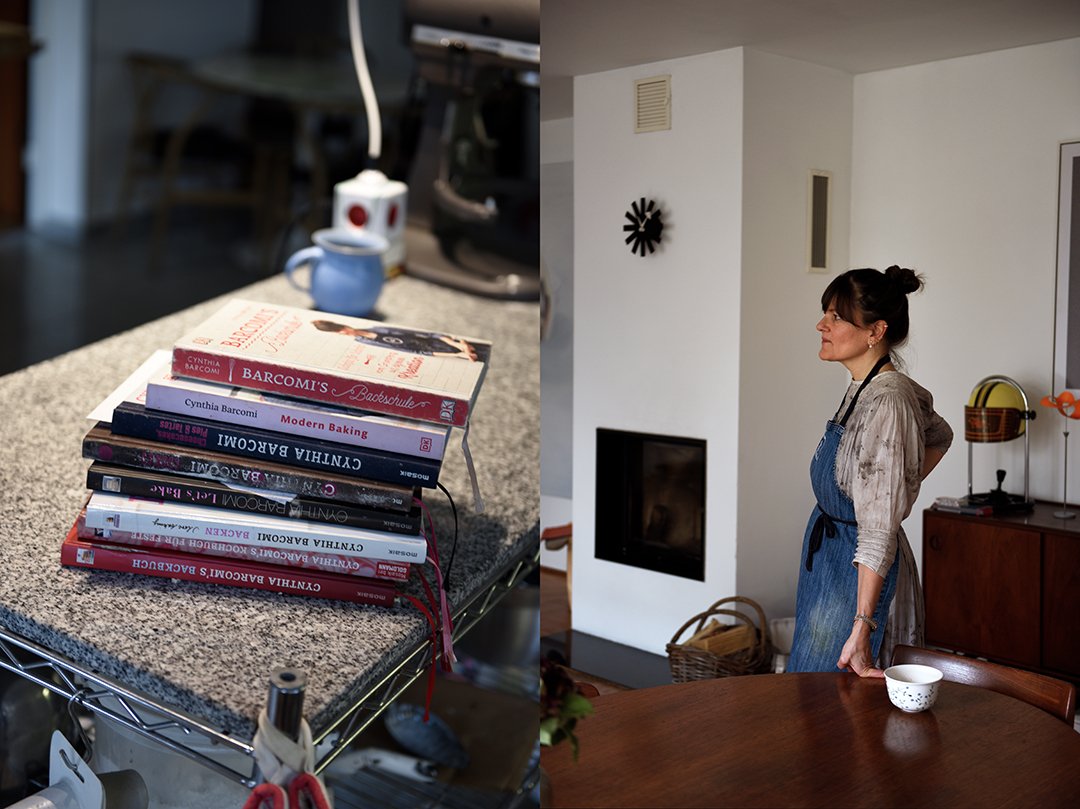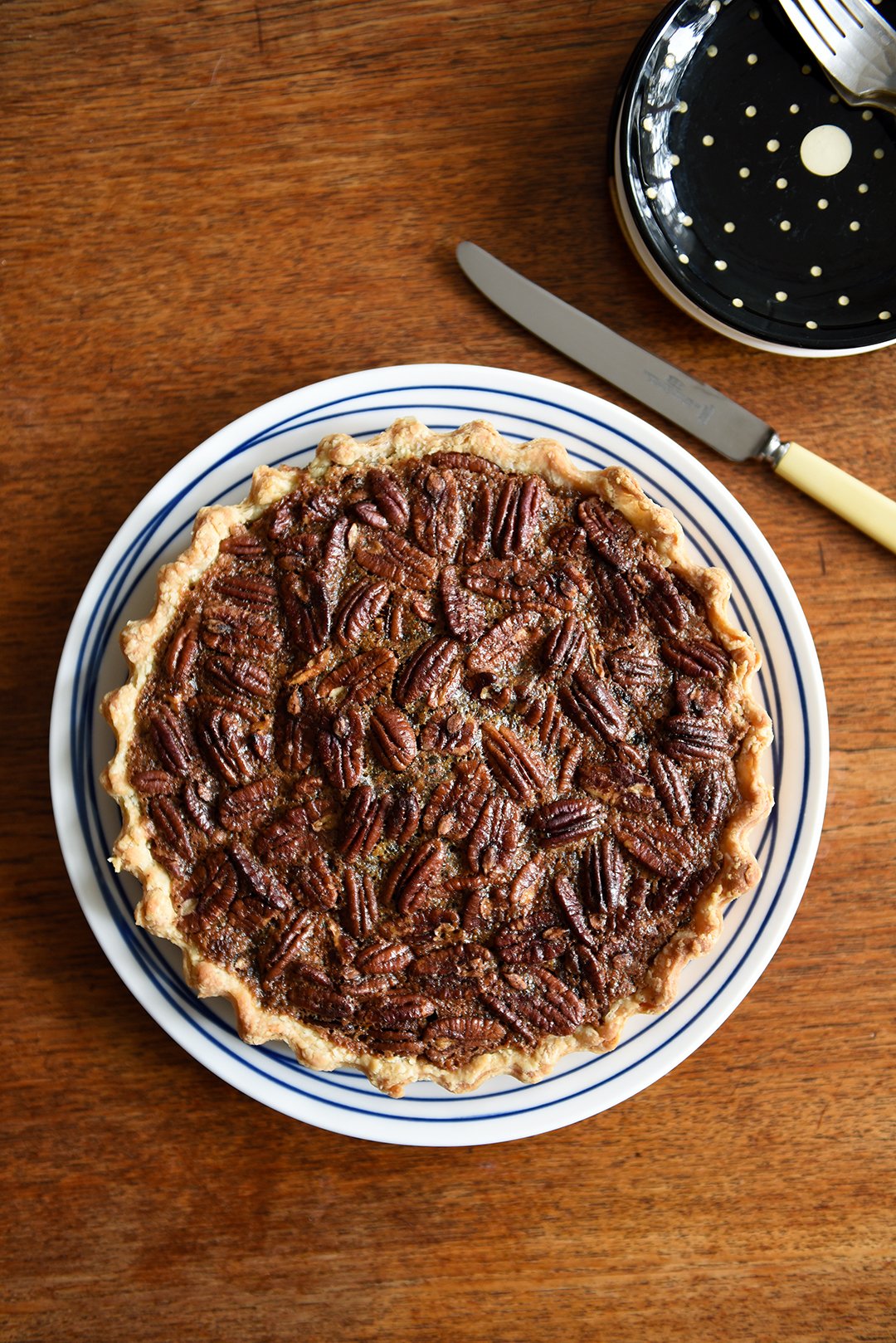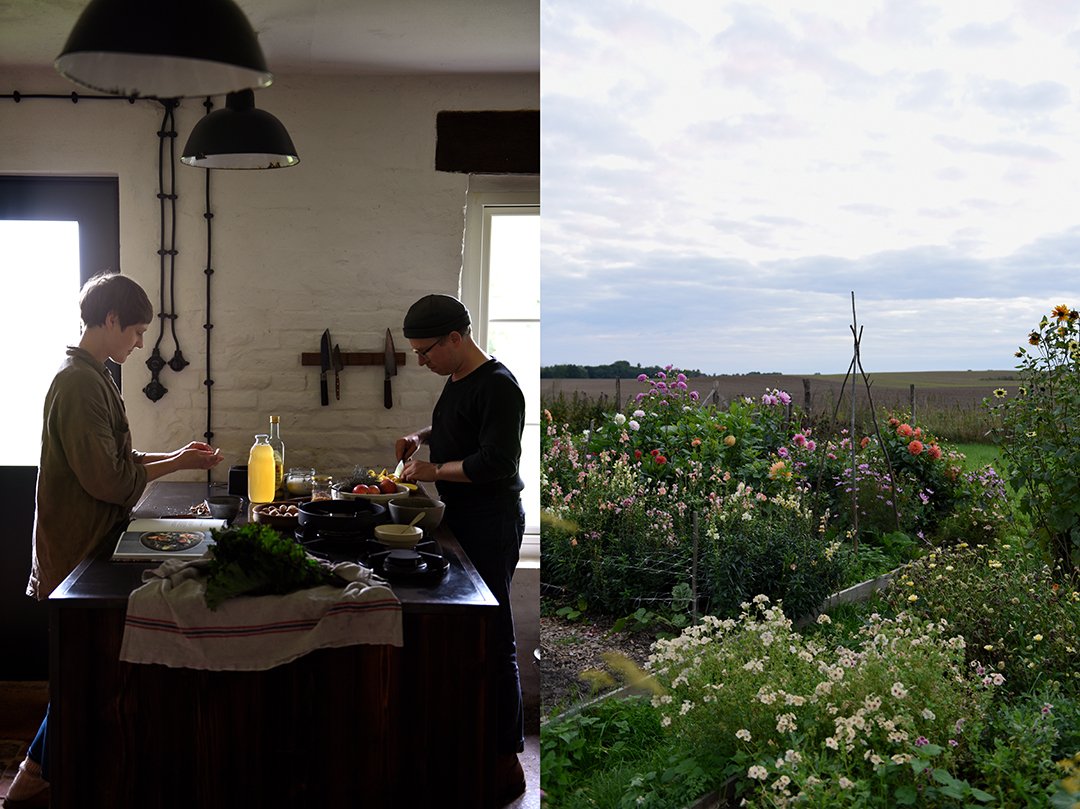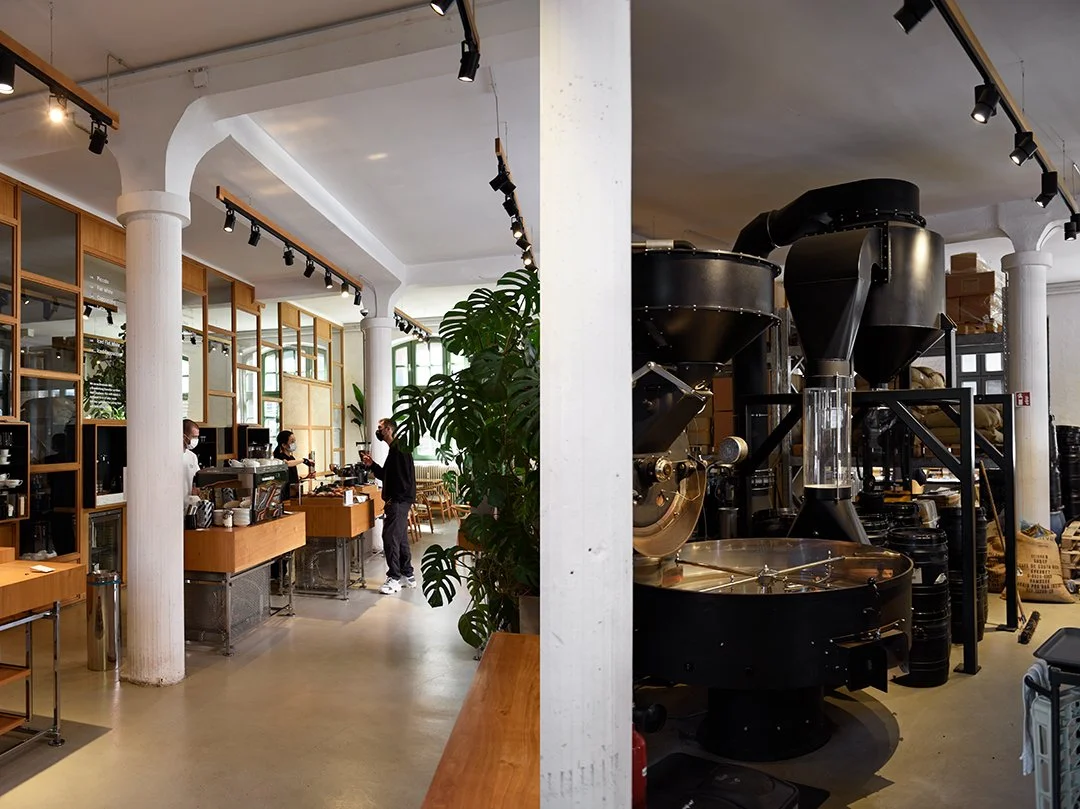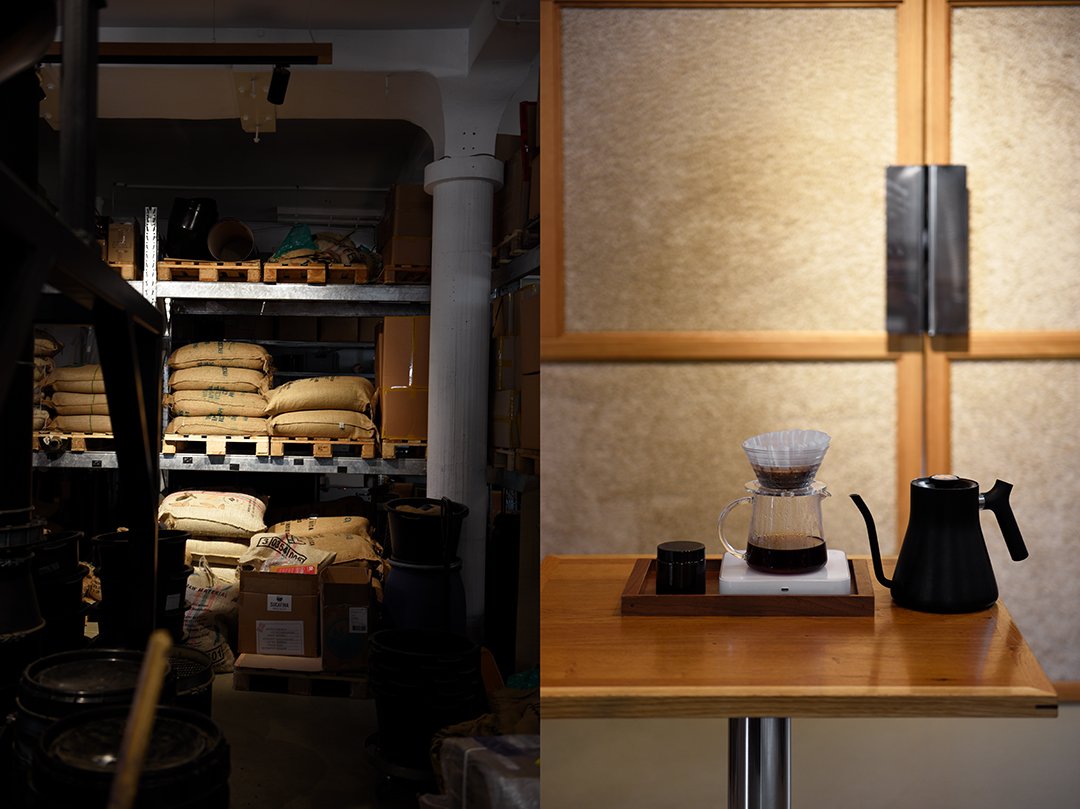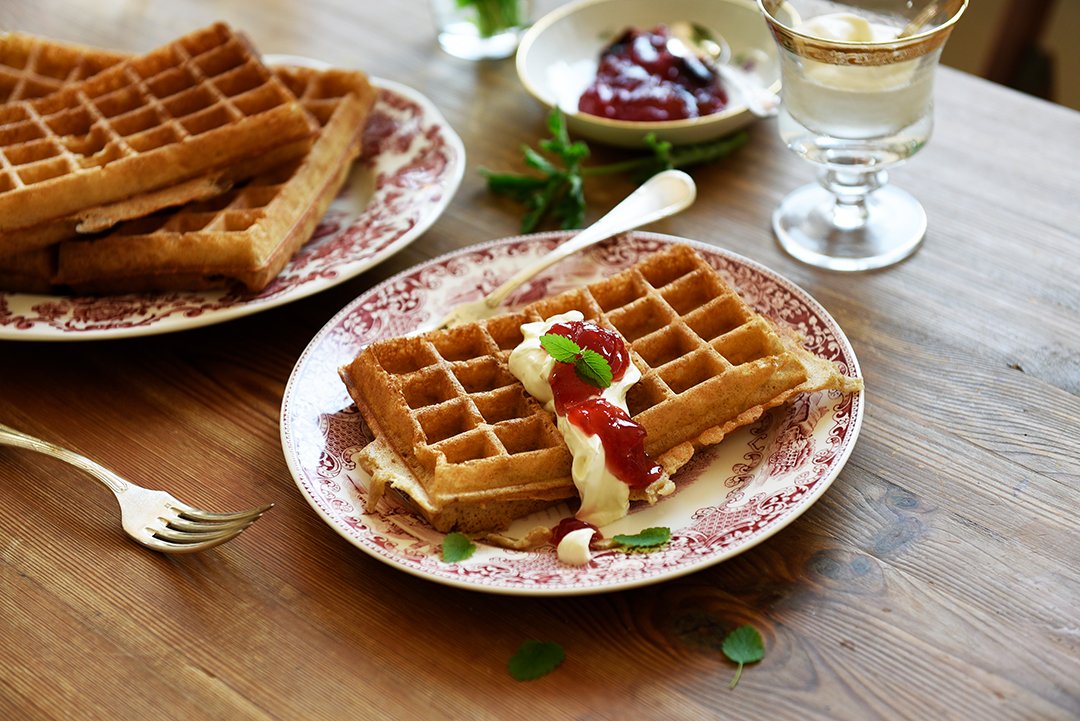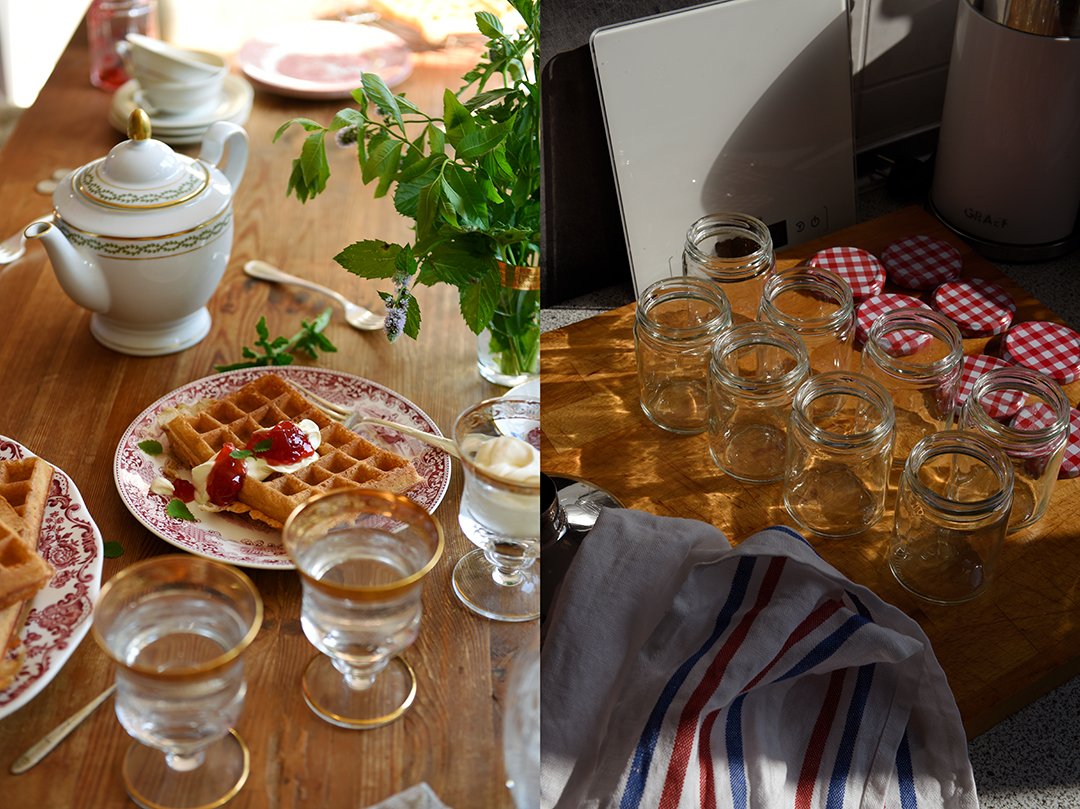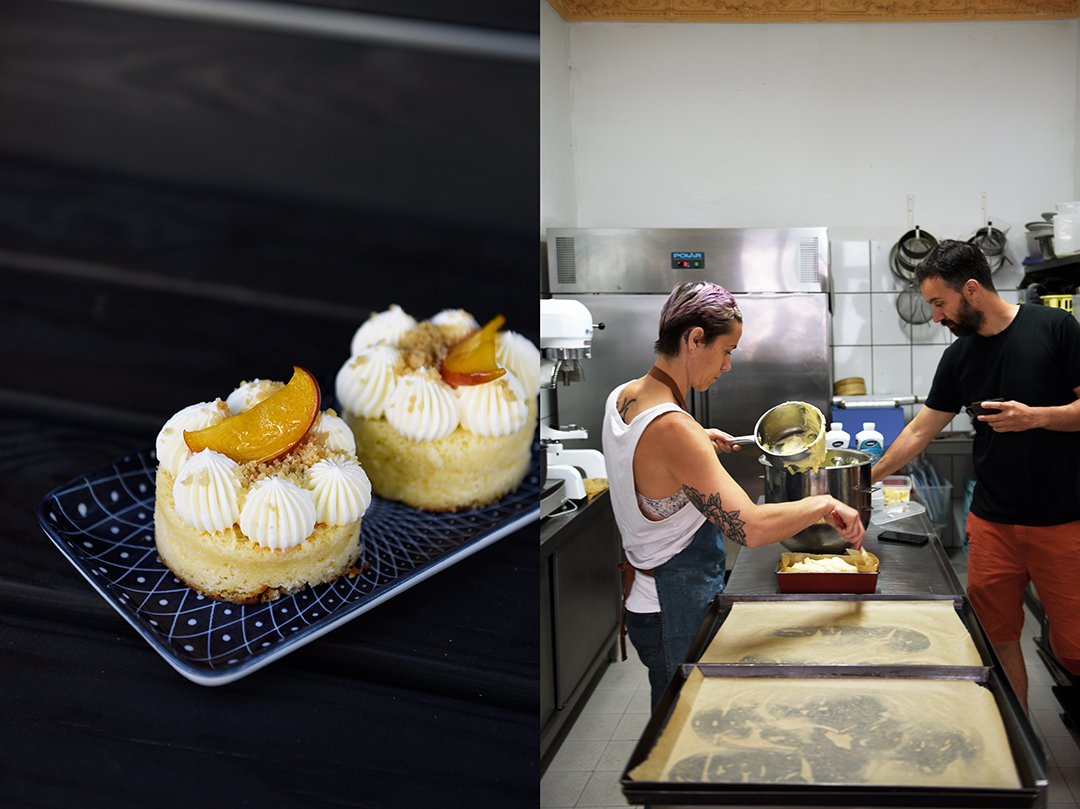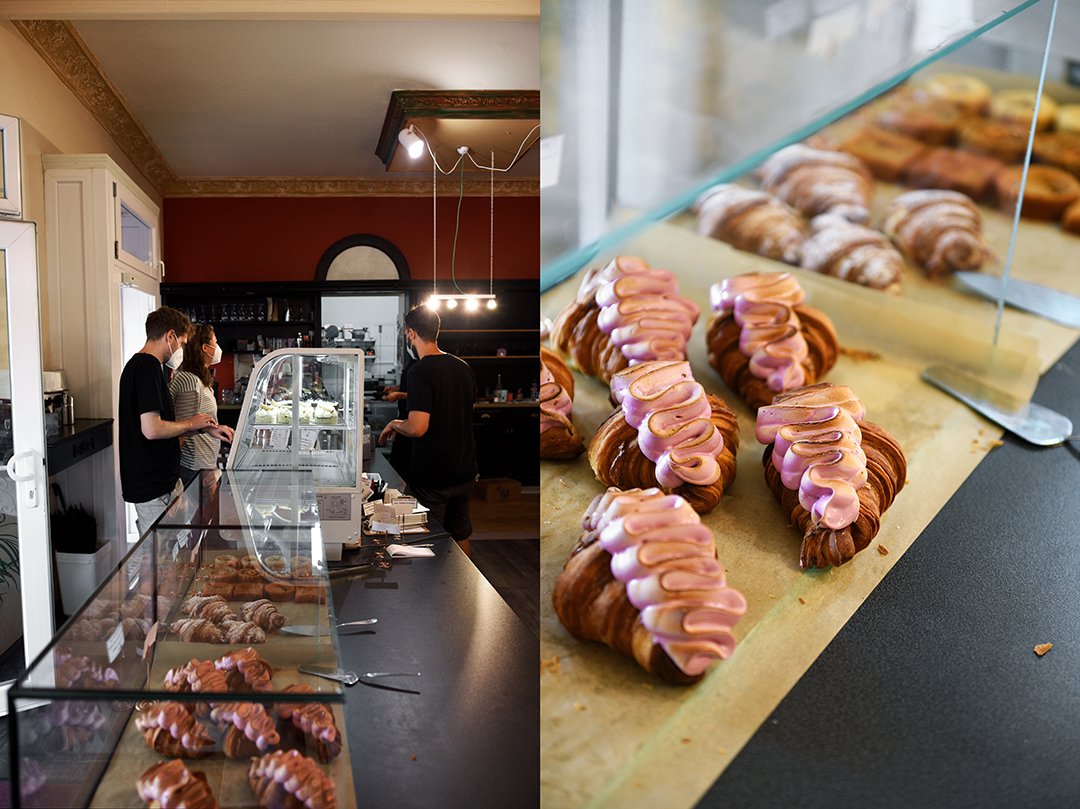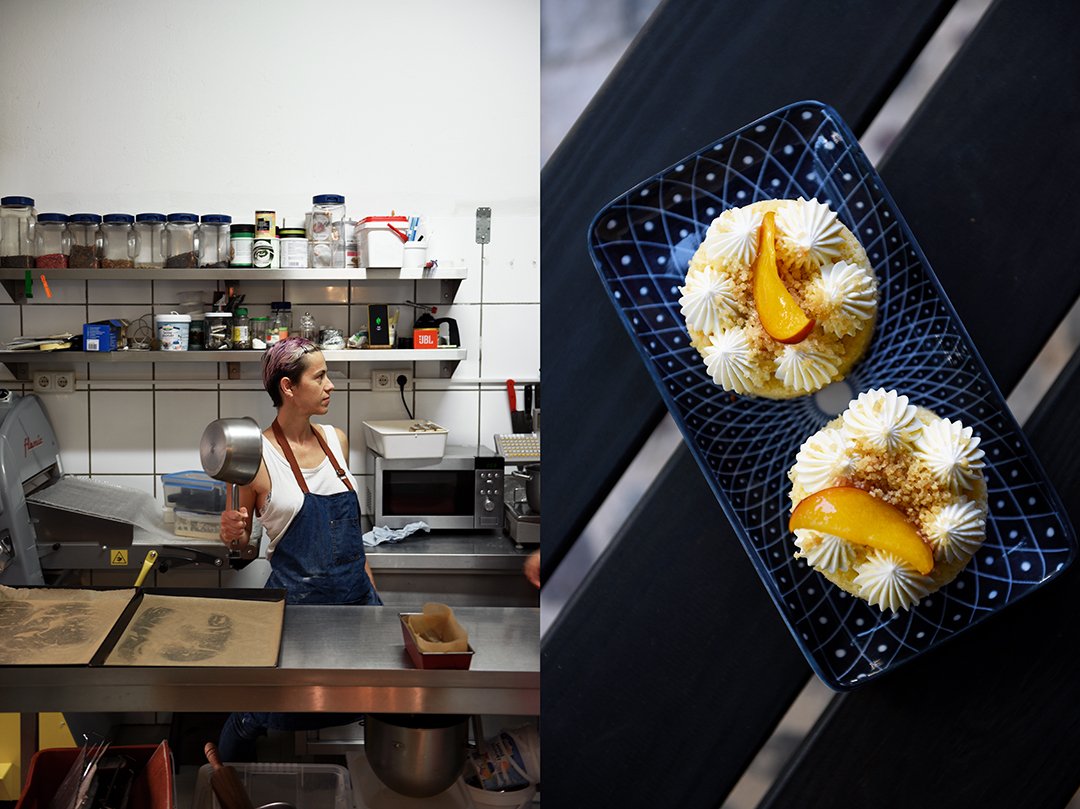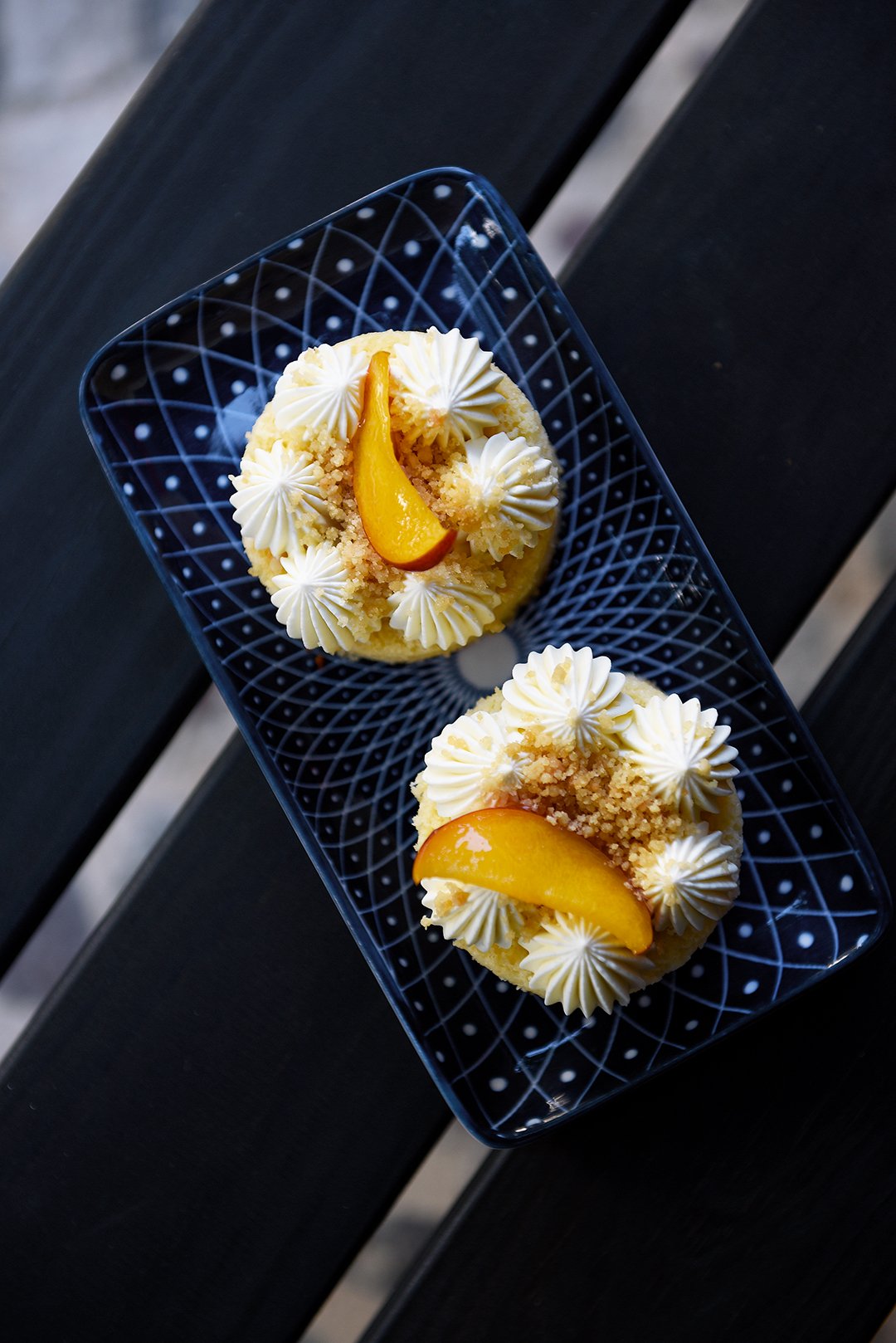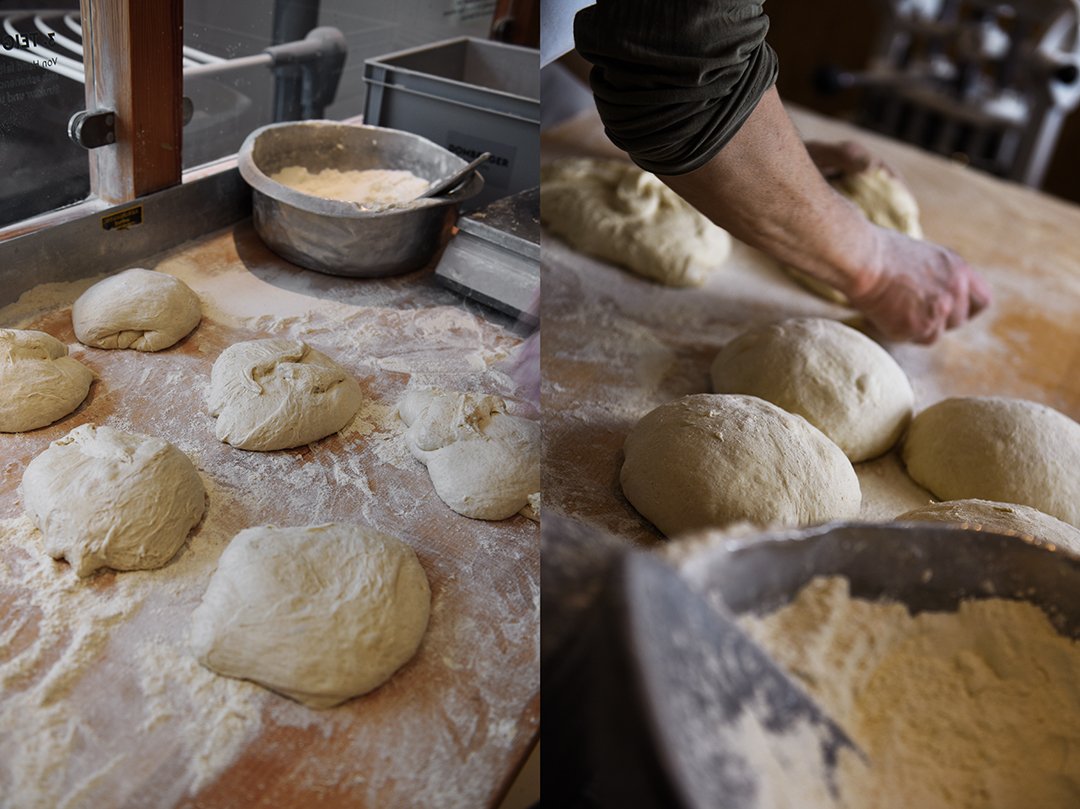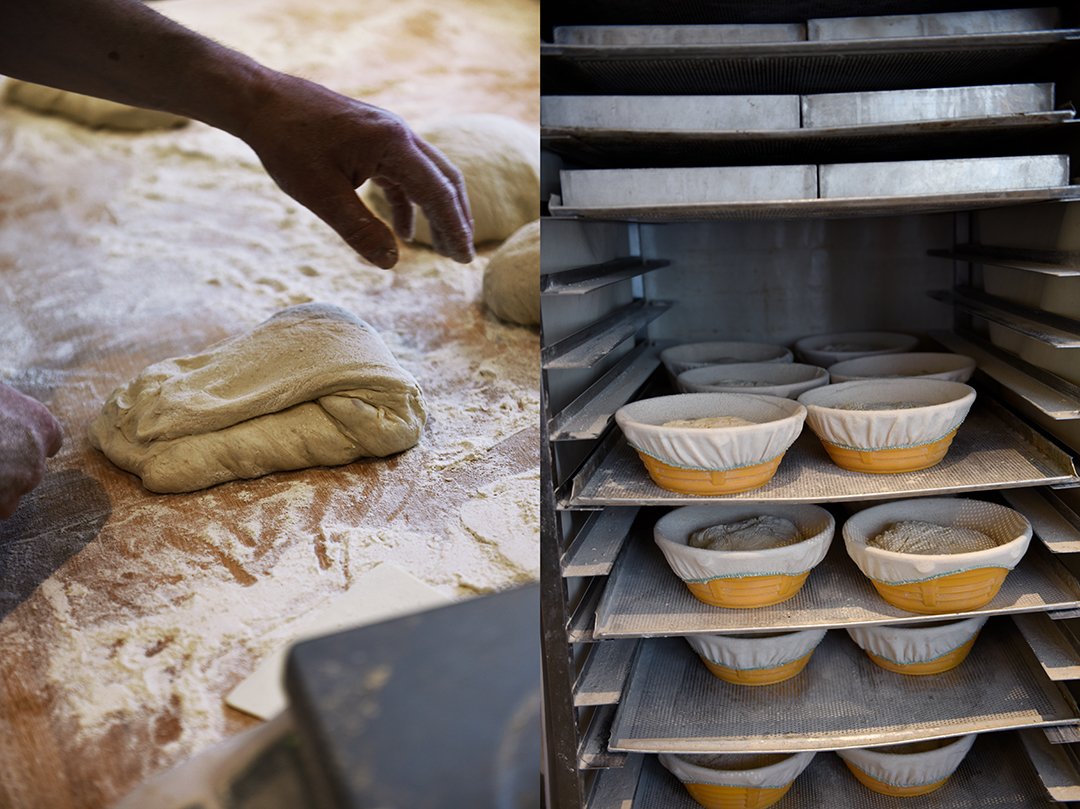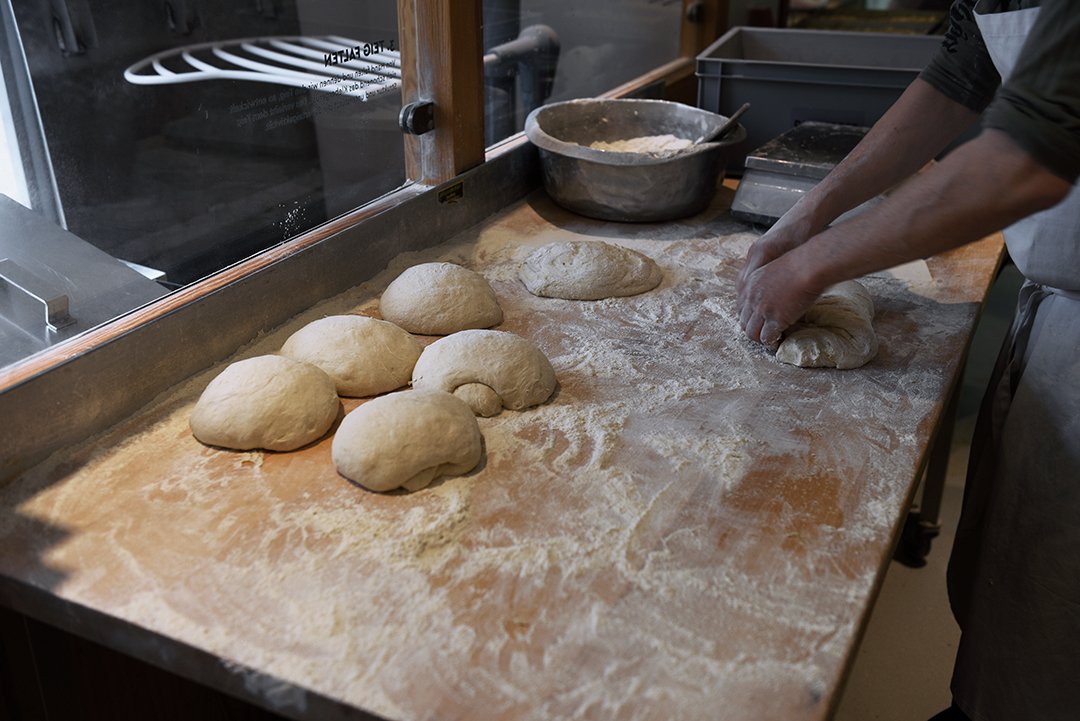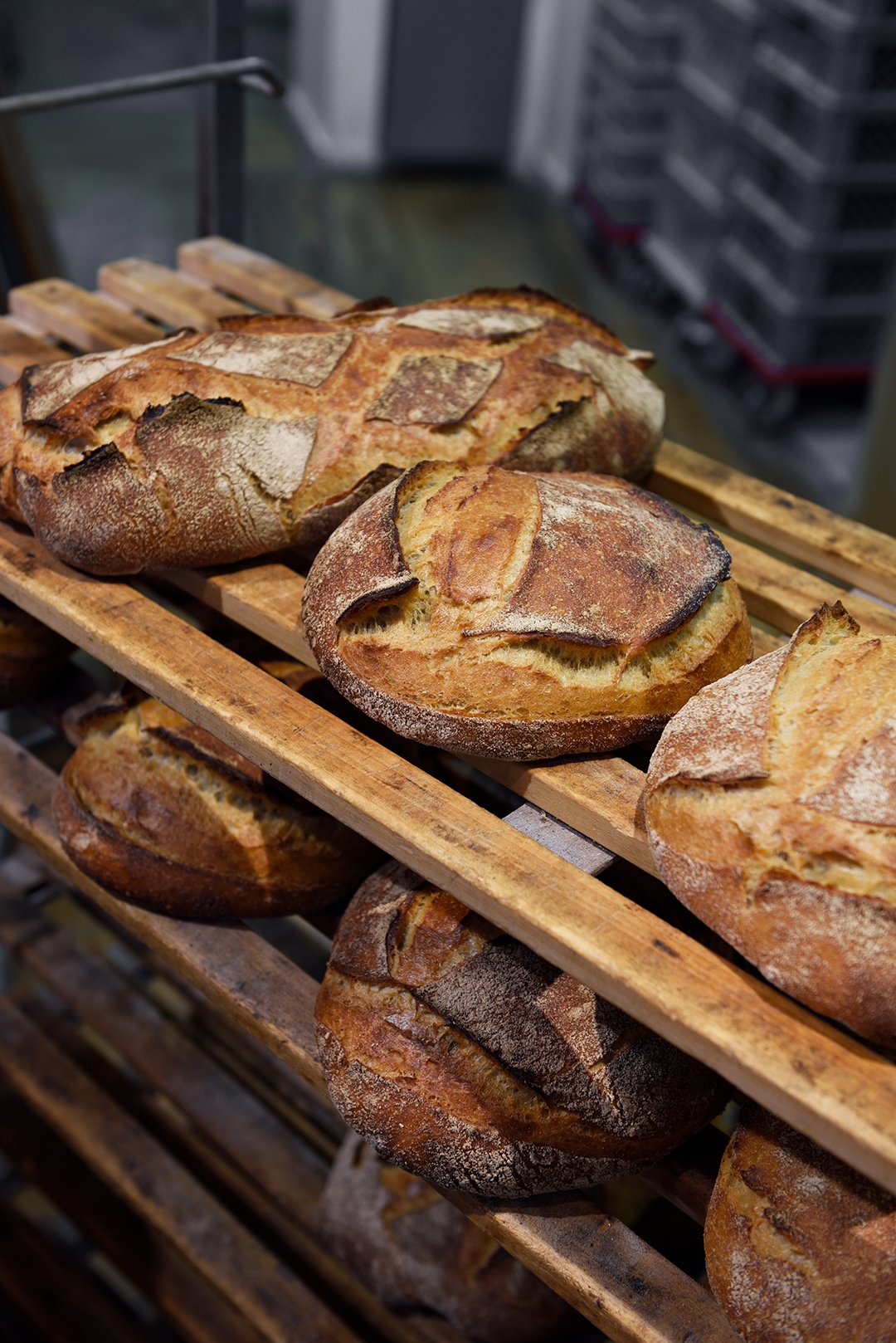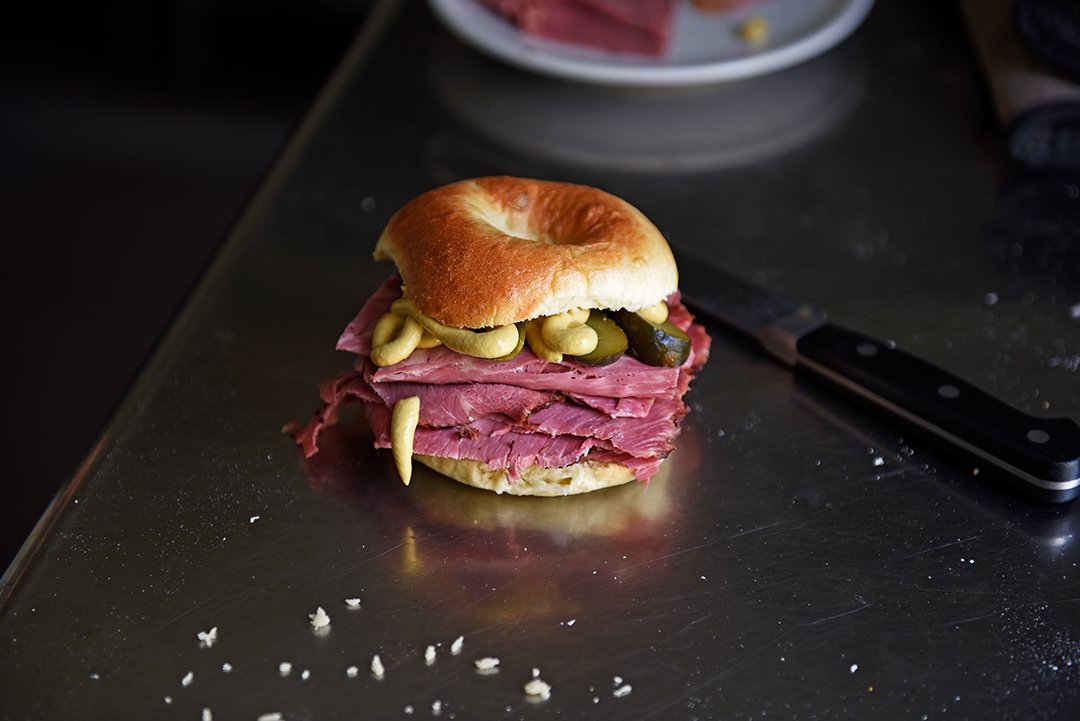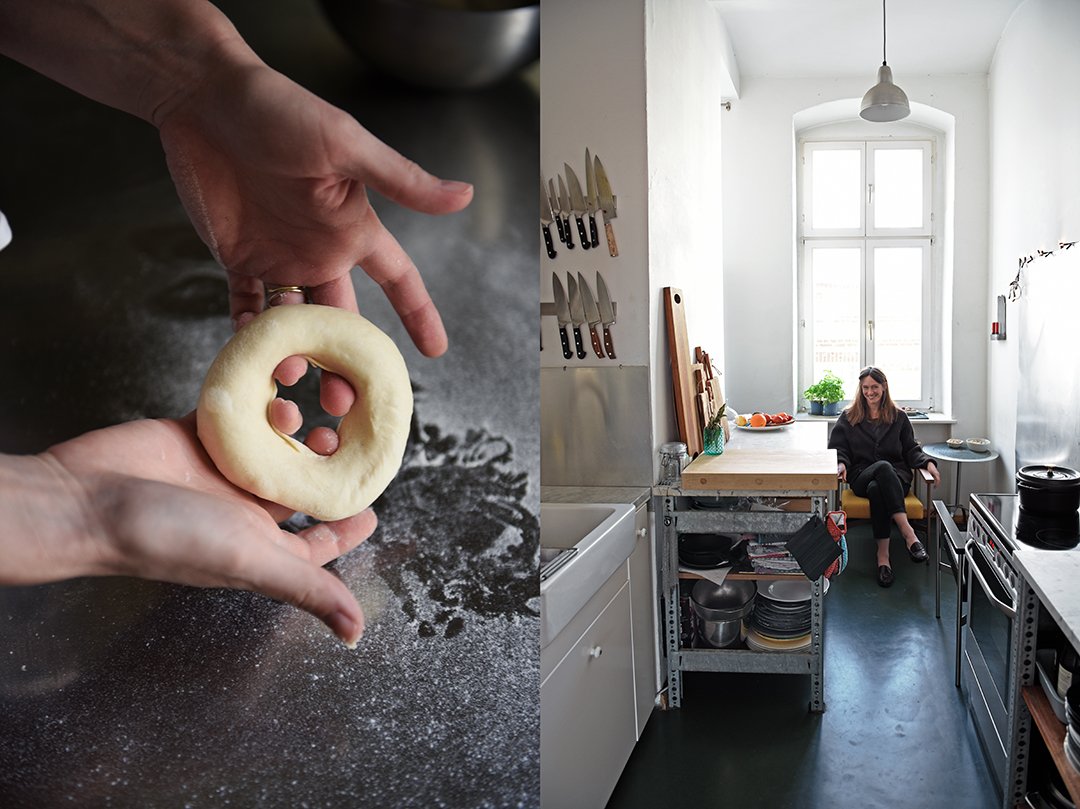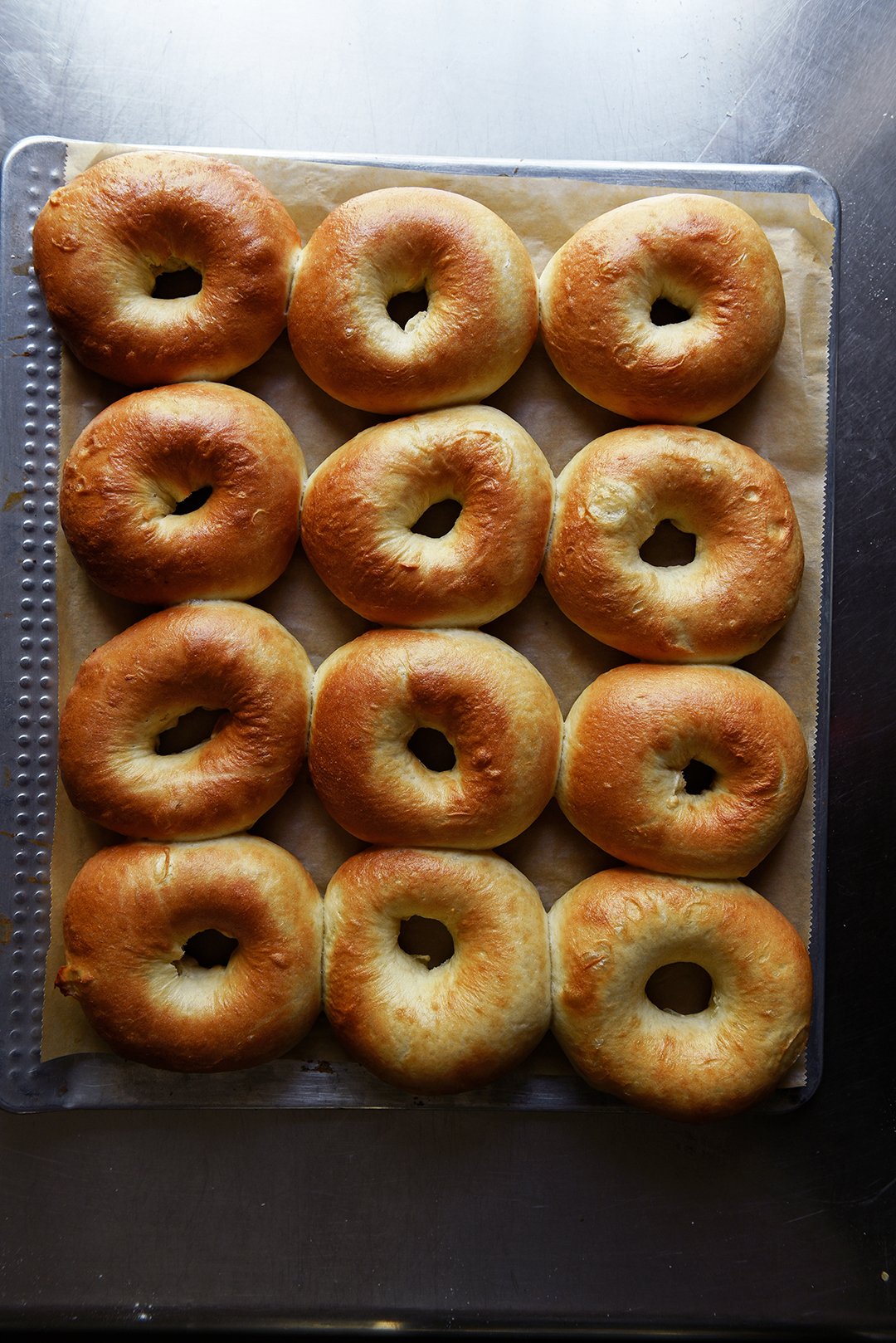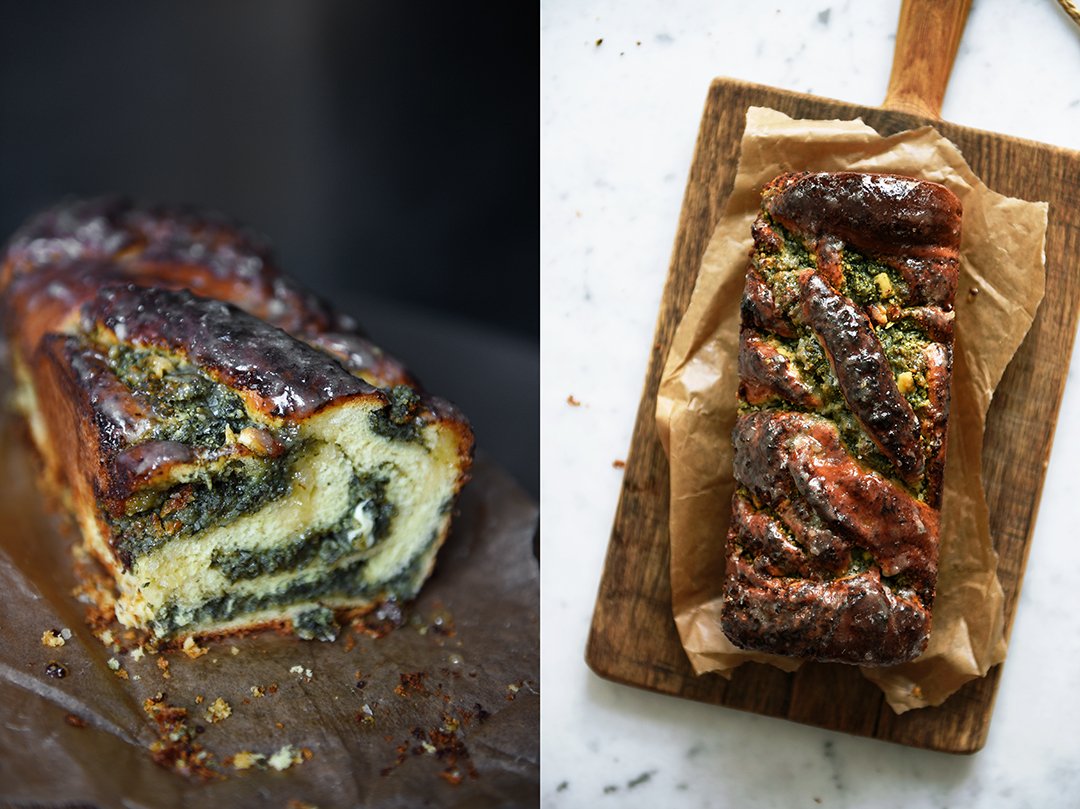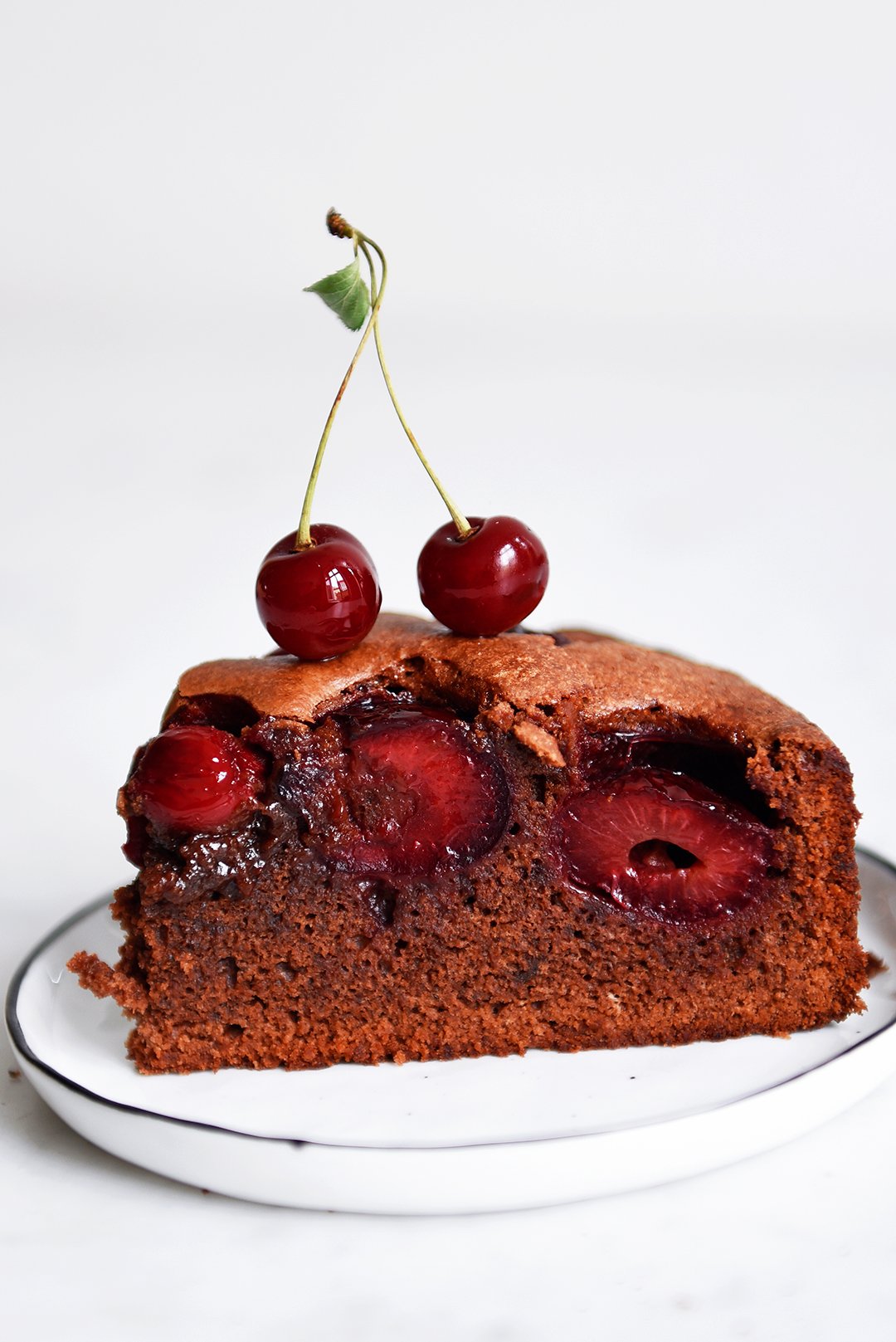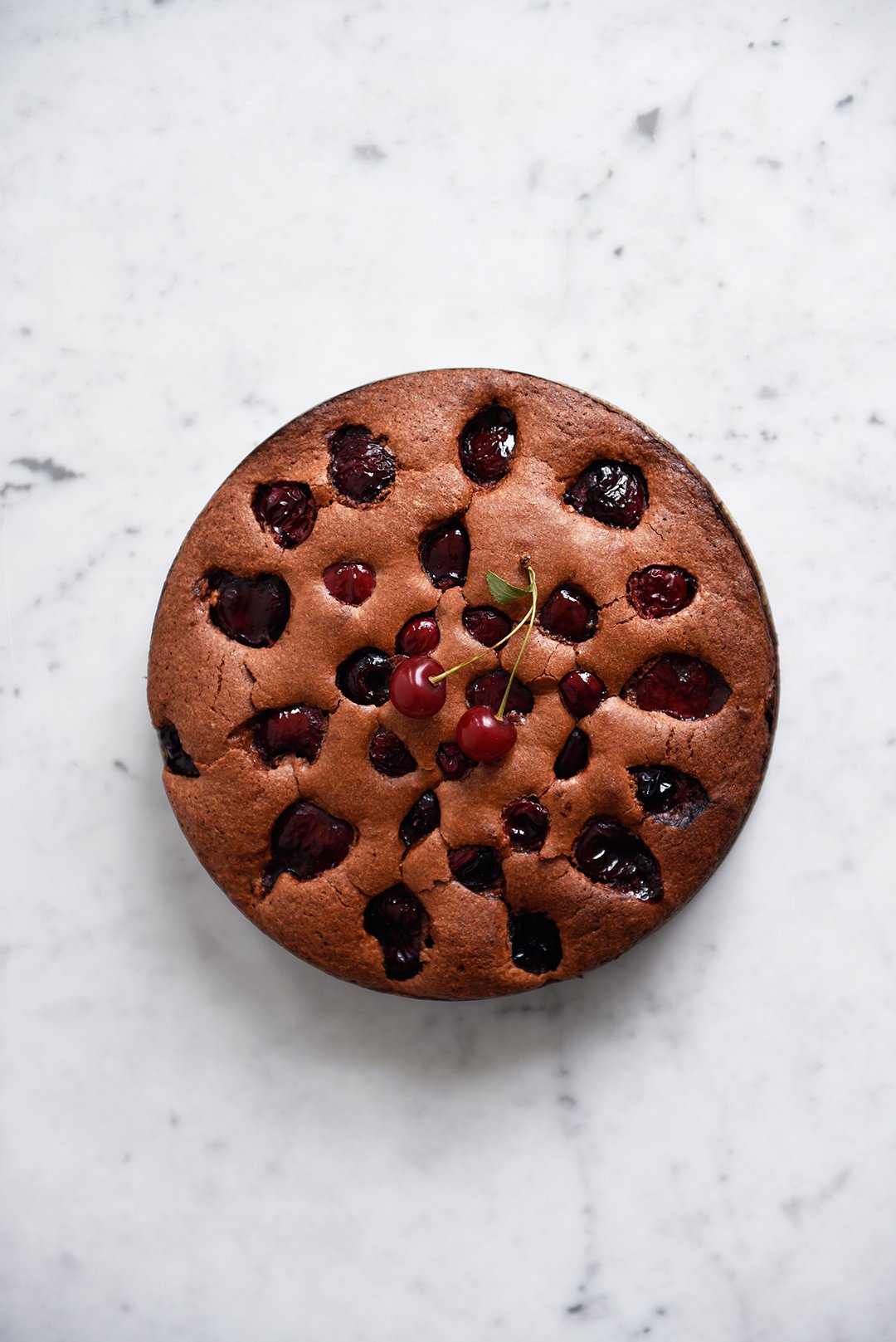LONDON
Food creates that safe, innocent space where we can meet without being a threat to each other; where we can be ourselves, embrace the fact that we are all unique through our unique stories, but when we exchange our stories - and the food connected to them - our paths converge and our lives intertwine.
To be able to share our stories, we must let go of our defenses, of our fear to be judged, condemned, or misunderstood by the ones who listen. We must accept our own vulnerability. The ground will feel wobbly, uncertain at times, but once we share our true story - and fully identify with that story - we transform; we get closer to our self and become stronger. When understanding is mutual, heartfelt on both sides, when we allow compassion, we have a real chance for change.
London was the last stop of my NOON book tour and the audience, our guests, made it easy for me to let go of my own defenses. It was an intimate evening at Hanna Geller’s (Building Feasts) beautiful, calm home. Helen Goh and I were in conversation and Hanna gently guided us through our lives, our books, our cooking and baking, and she made us feel safe to talk just as much about our confidence as about our insecurities. Sitting together with our guests in a circle, sharing food and champagne, and sharing our stories and thoughts about our lives and careers, but also sharing our vulnerability, brought all of us closer together.
Hanna opened more than just the doors to her home for the NOON book launch, without her help, trust, support, and friendship the evening wouldn’t have been possible. She prepared the food while I was running around London stock signing copies of my book, she bought champagne glasses when I noticed that I had forgotten to hire them. And the night before the event, I had the most peaceful dinner with her and three of her four boys. Sitting at her kitchen counter, a bowl of steaming soup in front of me, a dripping cheese sandwich in my hand, everyone chatting and laughing, made me feel so good, so calm, and ready for the London book launch.
And then, last Thursday night, we filled our glasses with Lallier Champagne’s glorious Grand Rosé Brut. Just like in Berlin, everyone fell in love with its fine fruity taste and delicate bubbles. Thanks to Aileen of Lallier UK, we even got a brief but very entertaining introduction to the champagne’s history and flavor profile. I can always enjoy a glass of champagne, any time, but it fit particularly well to the snacks from NOON that we - or rather Hanna - prepared and served to our guests: Peach Tart with Stilton (this is also the recipe that I’m sharing with you today, see below), Roasted Squash, Parsnip, and Grape Salad with Blue Cheese (click here for the recipe), and the Sauerkraut and Hummus on Sourdough Bread that already won the hearts of many NOON readers all over the world (here’s the recipe).
While I was in London, I got the chance to meet some book sellers at their independent bookstores to sign copies of NOON. There’s something magical about these places, the smell of books, the eyes of the customers concentrated and focussed while leafing through the pages of a book that, in that moment, becomes a world on its own. There’s a certain peace in these stores that soothes the mind and gives it some rest. That’s the magical power of a book.
Here’s a list of the London bookstores where you can find signed copies of NOON:
Books for Cooks (no signed copies but co-owner Eric Treuillé tests and serves dishes from the cookbooks at his Notting Hill bookstore / restaurant)
When you only have a few days in a city - for pleasure or business, it doesn’t really matter - when you’re on your feet constantly, it’s heavenly to come back to a hotel that feels as comfy as home but still so special that it excites and makes you smile every time you enter the loungy lobby.
The Hoxton Holborn managed to help keep my mood and energy level high and happy. Right in the center, the hotel sitting snug between Soho and Farringdon, I often didn’t even use the tube and just walked. My room was so quiet and cozy that I could have stayed for weeks (there’s something about British interiors, especially in bedrooms and bathrooms, that makes me forget about my usually quite minimalist approach to design and consider changing my entire Berlin flat from white walls to extravagantly patterned wallpapers).
Unfortunately, my schedule was tight and I didn’t get to indulge as wildly into lunches and dinners as I would have loved to, but here are some of the spots that I enjoyed while running around the city:
Quo Vadis, Smoked Eel Sandwich with a glass of crisp white wine, sitting outside on the bench (recommended by inspiring Gurdeep Loyal, author of Mother Tongue)
St. John’s Marylebone, Eccles Cake with Lancashire Cheese
Borough Market, Dorset oysters at Shellseekers (they also had the biggest oyster I’ve ever seen, 10 years old, but in the end I went for the smaller 3-year-old ones; they tasted fantastic, a little sweeter than my beloved French Fines de Claire)
Bishops Finger pub, traditional Fish & Chips
Ottolenghi Spitalfields (a tradition, for lunch)
The official NOON book tour came to an end and I want to thank YOU for following my journey that led to this book, and for your support of my work, of my recipes, and of this book that means so much to me. It’s at the same time scary and beautiful to see a book leave my kitchen and enter yours. So enjoy NOON, now it’s yours!
And I want to thank everyone who made the NOON book tour possible, in New York, in Berlin, and now in London:
Our curious guests, Hanna Geller and her son William, Helen Goh, the 3 ladies of Lallier UK: Aileen Rolfe, Rebekah Crabb, and Harriet Chandler, Champagne Lallier and Johannes Rohmer, Ingrid Meyer-Lohrmann and IML Kommunikation, everyone at The Hoxton Holborn, Eva Kaiser PR, Gianni Diliberto, Chronicle Books, and everyone at the Abrams&Chronicle Books UK headquarters.
So much love! Meike xxx
The photos taken at the NOON book launch in London are by Gianni Diliberto. The other pictures are by me.
Peach Tart with Stilton and Thyme
NOON: Simple Recipes for Scrumptious Midday Meals & More, Chronicle Books:
Bake your peach tart in the evening and take it with you to work the next day. At noon, go outside and sit down in a park, and when you munch on the first mouthful, close your eyes. Buttery pastry, chunky peaches, Stilton, and thyme, all in one bite, taste like a summer holiday memory turned into food. The sweet, fruity juices and salty cheese can almost compete with a blissful day at the beach.
NOTE: you can also replace the peaches with pears.
Serves 3 to 4
FOR THE PASTRY
2 cups (260 g) all-purpose flour
1 teaspoon fine sea salt
½ cup plus 1 tablespoon (130 g) unsalted butter, cold
1 large egg
FOR THE TOPPING
3 large white doughnut peaches, cut in half lengthwise
2 large yellow peaches, cut into quarters
2½ tablespoons olive oil
3 ounces (85 g) Stilton or Roquefort, crumbled
15 fresh small thyme sprigs, plus 1 tablespoon thyme leaves
Flaky sea salt
Coarsely ground pepper
For the pastry, combine the flour and salt in the bowl of a stand mixer fitted with the paddle attachment. Add the butter and use a knife to cut it into the flour until there are just small pieces left. Quickly rub the butter into the flour with your fingers until combined. Add the egg and mix on low just until the dough comes together. Form the dough into a thick disc, wrap it in plastic wrap, and freeze for 10 minutes.
Preheat the oven to 400°F (200°C).
On a work surface, place the dough between 2 sheets of plastic wrap and use a rolling pin to roll out into a disc, large enough to line the bottom and sides of a 10 to 12-inch (25.5 to 30 cm) quiche dish; a smaller quiche dish makes a thicker pastry base, which is nice for the peaches. Fit the dough into the quiche dish, pushing it into the dish, especially along the edges. Use a fork to prick the dough all over. Bake for about 15 minutes or until golden. If the dough bubbles up, push it down with a fork.
For the topping, arrange the peaches in circles on top of the prebaked pastry; for the middle of the tart, cut 2 yellow peach quarters in half again and arrange in a small circle. Drizzle with the olive oil, then sprinkle with the Stilton, thyme sprigs, and a little flaky sea salt. Bake for about 23 minutes or until the pastry is golden and crispy and the cheese is melted. Take the tart out of the oven, then immediately sprinkle with the thyme leaves and a little pepper. Let the tart cool for at least 15 minutes. Enjoy warm or cold.
BERLIN
Berlin was a party! We celebrated the German NOON at the stunning Hotel de Rome, with (lots of) champagne, with friends who came all the way from Lisbon, France, and Vienna, and with many good conversations. And we even sang at the end.
Celebrating a new book in my home city, Berlin, makes me feel both calm and very excited at the same time. I’m surrounded by my people, by my beloved city; and launching a book for the third time at Hotel de Rome, makes it feel even more like home.
So many kept offering me help, there was so much love and support that, although the launch was rather wild, it didn’t feel overwhelming for a second. Our event was set for two hours - we extended it slightly - but not even ten hours would have been enough to fit in all the conversations that I would have loved to have. About 80 guests (I lost track), the champagne kept pouring, the snacks from NOON were relished with sounds of pleasure (so much praise for the Hummus and Sauerkraut on Sourdough Bread from the book! Click here for the recipe), we didn’t even need any background music as the chatting and laughing filled the hotel’s Opera Court, a grand room in the former bank’s building (you can read more about the hotel’s history here).
Restaurateur Billy Wagner of Nobelhart & Schmutzig, no. 45 of the World’s 50 Best Restaurants, thankfully agreed to do the talk with me at our event. About two years ago, we had done a Meet in Your Kitchen feature and a podcast episode together. A few months ago, I bumped into him at an exhibition. After I had left, I was already on my bike on my way home, I thought “Billy, he’s the one for the Berlin NOON talk!.” So I quickly cycled back, asked him, still out of breath, if he’d be up for it and, luckily, he was.
When he asked me his questions in his calm Billy-way - some even unexpected, which I like - I stayed relaxed and inspired throughout the entire conversation. I think our exchange about food, noon, cookbooks, rituals, and recipes was as much fun for me as it was for our guests. Billy kept the string tight, without letting it tear - that’s a great gift to guide through a conversation.
To organize an event this big, you need partners, a team who you can trust and who trusts you too. The Hotel de Rome is not only one of Berlin’s most beautiful five-star hotels - and has the city’s most stunning roof terrace - it also has the best staff. Türkan Arikan, Director of Communications, has been a great supporter of my work since 2015 when we first met. It almost felt like love at first sight and even three books later, it hasn’t lost any of its magic.
I met Ingrid Meyer-Lohrmann, a natural networker with the biggest heart and passion for connecting people, around the same time as Türkan. Ingrid was the one who introduced me to Hotel de Rome eight years ago, and now, she brought Lallier Champagne into my life, whose delicious pink bubbles definitely lifted the crowd’s mood. Matthias Runge, the hotel’s Executive Chef, has been a fan of my recipes for years, we often chat about flavor combinations, so seeing him prepare the dishes for our event, made me feel very safe.
Today, I’m sharing one of the recipes from NOON that we also chose for the launch and that helps to slowly slip into the groove for autumn: Roasted Squash, Parsnip, and Grape Salad with Blue Cheese (recipe below).
The Berlin launch felt like a party - and I loved that. I’m quite happy that I don’t have to host a big event every week, however, when I think about it, the same rules that count for events also count for private gatherings. To be a good host, you need to feel good. You can only spread good vibes, when you feel them inside yourself. And to feel good, you need to surround yourself with the right people, you need to choose recipes that fit the occasion and to your schedule, and then it’s so much easier to stay relaxed and confident all night.
In the end, never forget, it’s your party. So accept imperfection and believe the ones around you when they offer you help. I’ve never accepted my imperfections more than I do now, I’ve never asked for help in such an honest way like I do now, I’ve never been so accepting with my own flaws. And I’ve never been so happy.
The next stops of my NOON book tour will be London on October 5th:
You can join me in conversation with Helen Goh, hosted by Hanna Geller at Building Feasts in a beautiful (secret) location (we will send you the address when you buy the ticket), with Lallier Champagne and snacks from NOON!
GET YOUR TICKET HERE and we’ll see you in London!
I want to thank everyone who made the Berlin launch of NOON possible - and so glamorous and glorious! Our guests, I loved seeing and hearing your laughters, seeing you dive deep into conversations, enjoying yourself and this night. There were just good vibes, thank you for that!
Thank you, you amazing people around me:
Türkan Arikan, General Manager Ulrich Schwer, Matthias Runge, and the entire team at Hotel de Rome, Billy Wagner, Ingrid Meyer-Lohrmann and everyone at IML Kommunikation, Champagne Lallier and Johannes Rohmer, Pia Werner and the best team at Prestel Verlag, Marcel Schwickerath, Tobias, Sira, Marta Greber for coming all the way from Lisbon (I’ll never forget that!), the four women / girl who inspired me to write NOON (Anne, her 4-year-old daughter, Gabi, and Laurel), all our guests - and Pat Appleton for singing for us before the lights went off!
Lots of love, Meike xxx
The photos taken at Hotel de Rome are by Marcel Schwickerath. The salad picture is by me.
Roasted Squash, Parsnip, and Grape Salad with Blue Cheese
from NOON: Einfache Mittagsgerichte für jeden Tag, Prestel Verlag (German)
NOON: Simple Recipes for Scrumptious Midday Meals & More, Chronicle Books (English)
Serves 2
FOR THE SALAD
12 ounces (340 g) seeded squash, preferably peeled butternut or Hokkaido with skin, cut into 1-inch (2.5 cm) wedges
6 ounces (170 g) seedless red grapes, on the vine
3 ounces (85 g) peeled parsnip, cut into wedges
¼ cup (60 ml) olive oil
Flaky sea salt
6 large radicchio leaves, torn into large pieces
8 small romaine lettuce leaves
1½ ounces (40 g) Roquefort or Stilton, crumbled (optional)
FOR THE DRESSING
3 tablespoons olive oil
2 tablespoons white balsamic vinegar
Fine sea salt
Finely ground pepper
Preheat the oven to 400°F (200°C).
For the salad, spread the squash, grapes, and parsnip on a large baking sheet, but keep them separate. Drizzle with the olive oil and gently toss to coat, again keeping the squash, grapes, and parsnip separate. Season with a little flaky sea salt and roast for 15 minutes, then gently flip the squash and parsnip over and continue roasting for 10 to 15 minutes or until the squash and parsnip are tender and the grapes start to soften. Remove from the oven and let everything cool on the baking sheet for 5 minutes.
For the dressing, whisk together the olive oil and vinegar in a small bowl and season to taste with fine sea salt and pepper.
Divide the radicchio and lettuce leaves between two large plates and layer the squash, parsnip, and grapes (on the vine or snipped) on top. Sprinkle with the Roquefort, drizzle with the dressing, and serve immediately.
To prepare the salad for transportation, let the squash, parsnip, and grapes (off the vine) cool completely, then pack in a container and spread the radicchio, lettuce leaves, and Roquefort on top. Keep the dressing separate in a jar and assemble just before lunch.
To 35 years of friendship, through thick and thin, thank you, Tobias:
NEW YORK
New York, you beautiful, crazy, challenging, magical city, you were good to me - and to NOON!
Being in New York, never feels normal! The city is vibrating, your body and mind are vibrating, and everything and everyone around you is moving, constantly. It feels like being on the edge of a cliff, where you can see more beauty, more life, where you can feel more alive, than in any safer spot. A week is packed with enough adventures and inspiration to fill a whole year. When you leave New York, you’re filled up with life, but at the same time, you feel like you need to sleep for days to return to your normal rhythm.
I’ve now returned to Berlin, the ground underneath my feed still a bit wobbly, my mind still a little overwhelmed, but what a trip! The launch of NOON in New York City, celebrated with a conversation with Hetty Lui McKinnon at Rizzoli Bookstore on Broadway, was the first stop of my book tour. I was nervous before I went on stage, it had been four years since I last spoke about my book (365 in 2019). I wasn’t sure if I had gotten rusty, if I’d feel shy about this book that is very personal and means so much to me. NOON was born at a difficult time in my life, a time of loss and change. And although this is not what this book is about, would I be able to talk about it? As this is what made me re-discover this time of the day.
There was no reason to worry, Hetty - and everyone else who came to Rizzoli to listen and celebrate with us - made me feel safe and comfortable. And the response I received was proof that we can share our struggles, how they challenge us and make us grow, how they can even inspire us. And by doing so, by sharing this very personal yet at the same time universal experience that we all face at some points in our lives, we can spread a feeling of encouragement, a feeling of trust in regaining safety and comfort. The path of getting there is never easy, but the people around us, our friends, but also strangers, and also our cooking and food, can make it so much easier.
Through noon - and through NOON - I found new rituals and recipes, and discovered a form of empowerment that goes beyond just enjoying - and sharing - recipes. Noon and NOON taught me to take better care of myself, to allow myself to focus on my own needs, at least once a day. Midday, when I sit down for lunch. Sharing this experience echos and resonates with the sentiment of so many people who I’ve met and talked to. Sharing recipes that can help make it easier to find a new rhythm, a rhythm which allows a healthier form of self care, is a truly beautiful and powerful side of this book, which I only really discovered now since the book is out.
Changing your routine can have such a powerful impact. And maybe, in the end, it doesn’t matter if this change happened by choice or was forced upon us, in the end, it’s just about our decision, what we choose to do with that change. It’s quite a stunning realization that our transformation and the direction it will take are still, despite all outer odds and struggles, in our own hands.
While I was in New York, I also got to sign copies of the book, which are now available at these bookstores in Manhattan and Brooklyn:
Kinokuniya, 6th Avenue
Barnes & Noble, Union Square
The next stops of my NOON book tour will be Berlin (by invitation only, as it would become too big an event otherwise) and London on October 5th:
You can join me in conversation with Helen Goh about women in food, hosted by Hanna Geller at Building Feasts in a beautiful (secret) location (you will get the address when you buy the ticket - feels like clubbing in the 90s…), with Lallier Champagne and snacks from NOON! GET YOUR TICKET HERE and I’ll see you in London!
Today, I’m sharing a recipe with you from NOON, which couldn’t fit any better to New York. It’s a sandwich, nourishing and simple, yet at the same time just as much fun as New York is: Take a thick slice of (sourdough) bread, generously spread hummus on top, and finish it off with a pile of squeezed (uncooked) sauerkraut. To save time, you can use store-bought hummus, but I find it tastes so much better with my homemade spiced hummus from the book (recipe below).
Before I’ll let you indulge in your sandwich, I’m sharing some of the places with you that I enjoyed this time in New York, while running around, signing books, meeting people, and being mesmerized by this magical city:
Fabrique Bakery (cardamom bun)
Getrude’s Brooklyn (burger & fries)
SEY Coffee Brooklyn
Radio Bakery (basically everything)
Jack’s Wife Freda (Noam’s Malva Pudding)
Da Andrea (homemade pasta, get a table outside!)
Finn’s Bagels
Roberta’s Brooklyn (pizza)
ilili (for our post-book launch dinner with friends)
I want to thank Hetty, for being an amazing, supportive friend and interview partner. If you don’t have her latest book yet, TENDERHEART, go grab a copy! And Holly La Due, my editor since book no.1, and friend since we first met, thank you for shaping NOON together with me, and for always making me feel home in New York. Thank you for your support, Lauren Salkeld, John, Michael, Kavita, Eric, Sara, Odette, Lukas, Laura, Judy, Rona, and everyone else who came to celebrate with us!
The pictures of the book launch at Rizzoli bookstore were taken by my friend Daniela who came all the way from Costa Rica just to celebrate NOON - and us. We’ve been friends for 30 years, we studied architecture together, and we met the last time 10 years ago, in Berlin. During our university years, we used to enjoy long nights with lots of good food and wine; not knowing where life would take us; not knowing that one day, thanks to a cookbook, we’d sit together at a restaurant in Chelsea, chatting for hours, embracing New York, our lives, and our friendship.
So, I’m picking up on the dedication I wrote in NOON: To friendship!
Sauerkraut and Hummus on Sourdough Bread
from NOON: Simple Recipes for Scrumptious Midday Meals & More, Chronicle Books
You can use leftover hummus for other recipes, such as Roasted Eggplant and Hummus on Dark Bread with an Herb-Fried Egg (which you can also find in NOON).
Makes 1 large sandwich
FOR THE HUMMUS
1¼ cups (250 g) drained and rinsed canned chickpeas
2⁄3 cup (150 g) light tahini
1⁄3 cup (75 ml) water
¼ cup (60 ml) freshly squeezed lemon juice
1 large clove garlic, crushed
2 whole cloves, finely crushed with a mortar and pestle
¾ teaspoon ground cinnamon
½ teaspoon fine sea salt
¼ teaspoon ground cumin
FOR THE SANDWICH
1 large slice thickly cut spelt or rye bread, ideally sourdough
2 to 3 tablespoons drained jarred or canned sauerkraut
For the hummus, purée the chickpeas, tahini, water, lemon juice, garlic, cloves, cinnamon, salt, and cumin in a food processor or blender until smooth. Season to taste with additional salt and transfer to a small bowl.
For the sandwich, generously spread 2 to 3 tablespoons of the hummus on the bread, pile the sauerkraut on top, and enjoy!
Tomato and Fig Caprese & the NOON Book Tour
No other season inspires me as much as late summer. The mesmerizing abundance of vegetables and fruit in August and September never ceases to wake up my appetite and makes me want to experiment with it in my kitchen. Seeing the colorful fresh produce spread out at the stalls at the weekly farmers market in my neighborhood feels like a holiday for the eyes and the taste buds. Tomatoes in various shapes, colors, and sizes, yellow and green zucchini, bent and plump, apricots, peaches, and figs, and little berries that burst in your mouth when you pop their skins with your teeth. Red and black currants, gooseberries, and raspberries, pair them with a bunch of fresh herbs and a quick vinaigrette and you have an exciting salad ready for lunch in less than five minutes.
The classic caprese, loved and adored every summer all over the world, is kind of the mother of all simple salads. You just need juicy tomatoes, creamy burrata (or stracciatella), torn basil leaves, olive oil, balsamic vinegar, sea salt, and pepper. Replacing the usual mozzarella with burrata or stracciatella, using olive oil that’s so good that you want to lick it off your fingers, and my sea salt from Gozo, are game changers in a simple caprese. One of the most important kitchen rules is so true: the less ingredients you use, the more you have to focus on the quality of each single one of them.
A good caprese is built on ripe tomatoes, picked at their peak, and that’s the tricky part. Even in August, even the prettiest tomatoes from your trusted farmer at the market can sometimes disappoint. And if they taste bland, they won’t make your dish shine either. To avoid this, I’ve come up with various experimental caprese recipes over the years, moving away from tradition and using all sorts of fruits and roots throughout the seasons; summer’s bounty of peaches, berries, and plums, or beet, persimmon, and orange in winter.
Until now, I always refused to pair tomato with another fruit, the combinations never really satisfied me. So at first, I was hesitant when I spotted purple figs lying on my kitchen counter and considered adding them to a classic caprese. But: the result was fantastic! The figs add concentrated sweetness without distracting from the tomato’s own qualities. They just make them taste a bit sweeter, somehow, they make them taste like very ripe summer tomatoes.
It’s a kitchen hack, kind of, that I wish I had figured out before I wrote my new book, NOON. Now the book is printed so I guess I have to use this hack for the next one. But before I jump into new adventures again, I’m ready to fully enjoy seeing NOON enter the world. On September 5th (September 19th for the German book), NOON will be on the shelves of bookstores all over the world (and on sale online) - and I will go on a little NOON book tour: New York, Berlin, and London!
Before I’ll let you enjoy your tomato and fig caprese (recipe below), I’m sharing the tour dates with you and the wonderful people who I’ll be in conversations with - and a quote from an (early) starred review for NOON:
“Move over, breakfast: lunch is about to become the most important meal of the day.”
―Library Journal
If you don’t want to wait until September, you can pre-order NOON here, or support local and pre-order from your neighborhood bookstore.
NOON BOOK TOUR
NEW YORK
• September 7th, 2023, 6pm: at Rizzoli Bookstore, with Hetty Lui McKinnon, RSVP here (not required, but seating is limited and will be first come, first served)
BERLIN
• September 19th, 2023: in conversation with Billy Wagner of Nobelhart & Schmutzig (by invitation only)
LONDON
• October 5th, 2023, 7pm: at Building Feasts, with Helen Goh, hosted by Hanna Geller, ticketed event (to book a ticket, click here or email Hanna at info@buildingfeasts.com)
Thank you, Lallier Champagne, for sponsoring the NOON Book Tour!
Tomato and Fig Caprese
Serves 1
3 medium, very ripe tomatoes (preferably in various colors), sliced
2 figs, cut in half lengthwise
4 ounces / 110g burratta (or stracciatella or mozzarella di bufala)
olive oil
balsamic vinegar
flaky sea salt
ground pepper
a small handful of red or green basil leaves
Spread the tomatoes on a large plate and arrange the figs and burrata on top. Drizzle with a little olive oil and vinegar, season with a little salt and pepper, and sprinkle with basil. Enjoy immediataley!
Summer Panzanella
I fell in love with panzanella when I was about five or six years old. We used to spend our summers in Tuscany, in a tiny old town close to Lucca. These holidays sparked my forever longing for the Mediterranean, for its pure and simple way of cooking, and for salads made with old bread. The taste of stale bread, soaking up the oily juices of a dark vinaigrette, tossed with deep red, ripe tomatoes and fleshy basil leaves became a memory so strong that it shaped my palate and my future cooking as an adult.
It was then that, without consciously noticing, I understood that a handful of good produce and products can create magic on a plate. It wasn’t luxurious, it was frugal, it wasn’t labor-intensive, it was very easy to prepare. And it was adventurous: I picked the tomatoes together with my Mama from the vegetable garden behind the house where we stayed. The garden, picking vegetables under the burning hot Italian sun, using old/ stale bread and not wasting it, preparing the dish together with my mother, bare-footed on clay tiles, setting the table with colorful, heavy Tuscan ceramics - all this became me, as a cook and as a person.
Now, you can find theses ceramics in my kitchen in Berlin, and although I don’t have a vegetable garden, my cooking is still very much produce-based and circling around comforting and frugal dishes (more and more even these days). And my love for panzanella is unbroken, as strong as ever.
So during our holidays in Tuscany, we ate the basic version with tomatoes and basil almost every day. Over the years, I’ve tried other recipes, with fish and seafood even, but I find that bread salads focussing on fresh vegetables excite me the most. I also like to add fruit sometimes. I even have three panzanella recipes in my book 365, with cherries and Stilton, one with berries and bacon (you can find the link below), and there will be a couple more in my new book NOON (not the one I’m sharing today).
Very often (when I’m not working on a cookbook), I don’t plan the recipe in advance but just look in my fridge and on the kitchen counter and then decide what kind of panzanella I’ll throw together. Just leftovers, staying frugal, and true to its core.
So when I had a loaf of sourdough bread lying around, slowly losing its sponginess (I never use completely stale bread for my panzanella, as you’d have to soak it in water first, which I don’t like), I knew what I would turn that into. Crisp leaves of radicchio and red Belgian endive - yellow endive works just as well but I love the drama that the red one adds - bring in a bitter note, green peas and ripe strawberries make it sweet and juicy. Stilton would have fit too (it always fits) but there was none in the fridge, so I went back to my panzanella roots: work with what you have right in front of you.
Here’s the recipe for my Berry and Bacon Panzanella with Rosemary.
MY NEW BOOK
NOON: Simple Recipes for Scrumptious Midday Meals and More
ON SALE SEPTEMBER 2023
YOU CAN PRE-ORDER NOON HERE
Support local: pre-order from your neighborhood bookstore
Summer Panzanella
Serves 1
For the salad
1 small handful fresh or frozen peas
3 large radicchio leaves, torn
1 red or yellow Belgian endive, leaves separated
8 ripe strawberries, hulled and cut in half
1 large, thick slice of white bread (ideally sourdough bread), cut into chunky cubes
For the dressing
3 tablespoons olive oil
1 tablespoon balsamic vinegar
1 tablespoon white balsamic vinegar
fine sea salt
ground pepper
For the salad, bring salted winter in a small saucepan to a boil and blanch the peas for 1 minute. Drain the peas, briefly rinse with cold water, and let them cool for 2 minutes then set aside.
For the dressing, whisk together the olive oil and both vinegars in a small bowl and season to taste with salt and pepper.
On a large plate or platter, layer the radicchio leaves, the whole Belgian endive leaves, strawberries, bread, and peas. Drizzle with the dressing and enjoy immediately (which I do) or let it soak for 15 minutes.
Asparagus, Beans & Burrata with Lemon
One of the most satisfying experiences for me as a cook is using the ingredients that I have right on hand in my kitchen and whatever fresh produce is in the fridge and on the counter and then spontaneously turning these finds into an utterly scrumptious dish. No planning, no overthinking, just playing around with what I have right in front of me. That’s pure joy, creativity, and improvisation, but also frugal efficiency. This is my favorite way of cooking at the moment, especially around noon.
With a dish in mind that I enjoyed in Rome a while back - burrata, olive oil, and a generous amount of lemon zest - I only had to add a few handfuls of asparagus, beans, and peas from my fridge, blanch them first (crisp and al dente, not soft!) to turn this Roman starter into a proper meal. A plate full of vegetables (or fruit even), crowned with creamy burrata and freshened up with lemon is quick to prepare and tempting for lunch and dinner. Although this dish would have perfectly fit into my soon (kind of) to be published 3rd book, this recipe won’t be in there. I just came up with it now, but it captures the vibe of my new book NOON better than any words can possibly do. So I’m sharing it with you here on the blog to show you what this book is about and why it was and still is such joy to work on it (I’m currently finishing the German translation).
NOON is about simple recipes that are fun to prepare and to eat. It’s about food that makes our mind, soul, and body happy; food that is nourishing and comforting and that gives us energy for the rest of the day. However, while it pleases the body, there’s no reason why our lunchtime shouldn’t be just as exciting as our dinner.
“As someone who eschews breakfast and counts down the hours to lunch, NOON is right up my proverbial alley. Peters’s recipes showcase the power of food to excite, to create a mood, or to transform a situation as much as to nourish the body. The joy of a midday feast is something within our reach with this beautiful book.”
―Helen Goh, co-author of Sweet
When I started writing NOON in January 2022, I noticed that midday is the time of the day when I focus on my own needs rather than thinking about what I’d love to cook for and share with others. This makes lunch, the preparation but also indulging in it, the ultimate form of self-care. It’s a break that gives us time for ourselves and our own needs. Every day. That’s a great gift.
The 115 recipes in the book circle very much around vegetables but there are also meat and seafood dishes. What they all have in common is that they are colorful, with layers of flavors and texture, sometimes they surprise with an unusual combination, or with tips and tricks to make our midday break tastier yet not fussier. The recipes in NOON help put a spotlight onto a meal that is often neglected in our busy schedules.
And we have a cover! I’m in love with it and with the recipe that we chose for it: Ada’s pink Polish Chłodnik Soup.
NOON will be out on September 5th in English (published by Chronicle Books) and on September 20th in German (published by Prestel, luckily, with the same title). If you’re as excited about it as I am, it would be great and very helpful if you pre-order, you can find the links here or pre-order worldwide at your local bookstore. These days, with shifts and changes in the publishing world, book pre-orders have become essential for authors. So your help and support has a great impact on the book and which course its journey will take, even before it’s been published.
“Meike Peters’s NOON is a delicious contemplation of how food can bring pleasure and comfort any time of the day. Her vibrant vegetable- and fruit-packed recipes are colorful, enticing, crave-worthy, and completely doable at lunchtime. Peters’s book serves as a reminder that we should all aim to bring balance to our busy days and savor the small moments around this oft-forgotten meal.”
―Hetty Lui McKinnon, food writer and cookbook author
In September / October I will be on a NOON book tour (you can find updates about the tour here). In New York you can join me for a talk with Hetty McKinnon at Rizzoli Bookstore and in London I’ll have a ticketed event at Hanna Geller’s Building Feasts with a conversation with Helen Goh (tickets will be available soon). Before I’ll let you enjoy today’s recipe of Asparagus, Beans, and Burrata with Lemon, I will share a little more about NOON with you. I already wrote about it in a previous post (you can read it here), but this book came with a lesson:
When I had the unexpected idea - or rather the complete vision for NOON within a few days - I had no publishing deal yet and the early feedback to my idea was rather hesitant. I was told that people want cookbooks for dinner, not for lunch. But somehow my instinct strongly told me to stubbornly move on with it and not change a thing. So I started cooking and taking pictures and did nothing but this for about two months. Only a week before I was done shooting the recipes, I got a little nervous and started talking to publishers again.
Long story short: all of a sudden I kept getting offers but most luckily, my editor of my first two books, Holly La Due, picked up on the idea. Now editorial director at Princeton Architectural Press, whose cookbook department had just become a part of Chronicle Books, Holly pitched NOON to Chronicle for the fall of 2023 (usually this would be far too tight but I was impatient and wanted it out as soon as possible). Serendipitously, Chronicle jumped on the idea of a lunch book and, as another book had just dropped out of their program, NOON took its place, scheduled for the fall of 2023.
When I got the message from Holly on March 26th 2022, two months after I had first shared my idea with her, I had no idea that from then on, everything would smoothly fall into place. Sometimes we really have to sit back and wait and do nothing - or just cook recipes and take pictures of them anyway - and everything will come together exactly how it should. It’s so easy to say though once we know how the story turned out and so hard to do while we have nothing but our gut feeling.
Thank you for following my book journey for the 3rd time!
Meike xxx
NOON: Simple Recipes for Scrumptious Midday Meals and More
YOU CAN PRE-ORDER NOON HERE
Support local: pre-order from your neighborhood bookstore
Asparagus, Beans and Burrata with Lemon
The vegetables don’t need to be warm so you can prepare them in advance. You can even keep them in then fridge overnight and assemble right before you want to enjoy your lunch.
Feel free to adapt this recipe to the seasons, thinking of juicy fruit and bitter radicchio or raw fennel in summer or early autumn.
Serves 1
2 white or green asparagus stalks, trimmed
1 small handful green beans
1 small handful flat beans
1 small handful fresh or frozen peas
110g / 4 ounces burrata or mozzarella di bufala
olive oil
freshly grated lemon zest
freshly squeezed lemon juice (about 1/2 large lemon)
flaky sea salt
black pepper
ciabatta or baguette, for serving
Peel the white asparagus; green asparagus only needs to be trimmed.
Bring a large pot of salted water to a boil and blanch the white asparagus for about 7 minutes or until al dente (green asparagus needs about 3 minutes). Leave the pot on the heat and, using a slotted ladle, transfer the asparagus to a colander then briefly rinse with cold water and drain; cut each asparagus into 3 pieces and set aside.
Add the green beans and flat beans to the pot with the boiling water and blanch for 4 to 6 minutes or until al dente. Leave the pot on the heat and, using a slotted ladle, transfer the beans to a colander then briefly rinse with cold water and drain; cut the beans in half, or into smaller pieces if you prefer, and set aside.
Add the peas to the pot with the boiling water and blanch for 1 minute then drain and briefly rinse with cold water.
Arrange the asparagus, beans, and peas on a large plate. Place the burrata on top of the vegetables then drizzle the vegetables and burrata with olive oil and lemon juice (be generous with the lemon juice). Generously sprinkle with lemon zest, season to taste with salt and pepper, and enjoy immediately with thick slices of ciabatta or baguette to dip into the oily juices.
Hamantashen with Lemon-Parsley Ricotta
Hamantashen are little pastry pockets, not more than a small bite, usually sweet and filled with poppy seeds, jam, or dried fruit. I turned them into a savory treat with a very lemony ricotta filling refined with lots of chopped parsley. It's a traditional Ashkenazi pastry, baked and shared during the Jewish holiday of Purim, starting this year on the evening of March 16th and ending 24 hours later. So why am I baking them? And why now?
My friend, the Berlin-based American baker Laurel Kratochvila of Fine Bagels spontaneously started Hamantashen for Ukraine, a show of worldwide bakery solidarity for the people of Ukraine. Profits of the sales are being donated to the Polish Humanitarian Action to help and support Ukrainian refugees at the Polish border. Laurel and her bakery friends will bake and sell hamantashen between now and March 17th, the 14th day of the Hebrew month of Adar. To find out where you can buy the charity pastries click here for the ever expanding list of participating bakeries all over the world.
Purim is celebrated to remember the saving of the Jewish people - thanks to queen Esther - from Haman, a vizier of the First Persian Empire who wanted to kill all Jews in the empire. Traditionally, food, drinks, and gifts are shared on this holiday, hamantashen are enjoyed together in the community, donations are given to the poor, and children and adults alike dress up in costumes. Maybe most importantly, these days there's often a reflection on modern day Hamans in the world. That's where this fundraiser comes in.
Laurel shared her recipe for sweet hamantashen with poppy seeds with me and I'll share my first attempt to bake hamantashen with you. Not sweet but packed with lemon-parsley ricotta.
Thank you, Laurel!
Hamantashen with Lemon-Parsley Ricotta
Makes 22 hamantashen
For the pastry
285g / 2 1/4 cups all-purpose flour
1 teaspoon fine sea salt
120g / 1/2 cup plus 1 teaspoon unsalted butter, cold
1 large egg
For the filling
125g / 4.5 ounces fresh ricotta, drained
1 large egg
30g / 1 ounce Parmesan, finely grated
1 small bunch fresh flat-leaf parsley, leaves only, finely chopped
1 scant tablespoon freshly grated lemon zest
1/4 to 1/2 teaspoon fine sea salt
Coarsely ground pepper
For the pastry, combine the flour and salt in the bowl of a stand mixer fitted with the paddle attachment. Add the butter and use a knife to cut it into the flour until there are just small pieces left. Quickly rub the butter into the flour with your fingers until combined. Add the egg and briefly mix with the paddle until crumbly. Form the dough into a thick disc, wrap it in plastic wrap, and chill in the fridge for 1 hour.
Preheat the oven to 180°C / 350°F (preferably convection setting). Line a baking sheet with parchment paper.
For the filling, whisk together the ricotta, egg, Parmesan, parsley, lemon zest, 1/4 teaspoon salt, and a generous amount of pepper in a medium bowl. Season to taste with additional salt.
On a work surface, place the dough between 2 sheets of plastic wrap and use a rolling pin to roll out until it’s about 3mm / 1/8 inch thick. Using a 7cm / 3 inch round cookie cutter, cut out circles, re-rolling any pastry scraps. Place 1 teaspoon of the filling in the middle of each circle. To shape, fold 3 sides inward to make a triangle, either overlapping or pinching where the edges meet. Transfer to a large platter and chill in the fridge for 10 minutes.
Transfer the hamantashen to the prepared baking sheet and bake for about 18 minutes or until the pastry is golden and just baked through. Let them cool for a few minutes and enjoy!
______________________________
Hamantashen with Poppy Seeds
by Laurel Kratochvila / Fine Bagels
Makes 40 hamantashen
For the pastry
440g / 3 1/3 cups all-purpose flour
240g / 1 cup plus 1 teaspoon unsalted butter, cold, cut into cubes
130g / 1 cup plus 1 tablespoon finely ground almonds
120g / 1 cup confectioners sugar
1/4 teaspoon fine sea salt
2 large egg, beaten
1 teaspoon vanilla extract
For the filling
150g / 1 1/2 cups ground poppy seeds
75g / 1/3 cup plus 1 tablespoon granulated sugar
210ml / 3/4 cup plus 3 tablespoons whole milk
2 teaspoons unsalted butter
1/2 lemon, juice only
2 tablespoons honey
For the pastry, in the bowl of a stand mixer fitted with the paddle attachment, mix the flour and butter on low speed until sandy in texture, no bits of butter remaining. Add the ground almonds and confectioners sugar and mix until well combined. Add the salt, eggs, and vanilla and mix on low until the dough has just come together and no dry bits remain. Press the dough into a thick disc, wrap it in plastic wrap, and chill in the fridge for 2 hours or up to 48 hours.
For the filling, in a heavy, medium saucepan, bring the poppy seeds, sugar, milk, butter, and lemon juice to a gentle boil over medium heat. Reduce the heat to low and simmer until thickened. Remove from the heat, stir in the honey, and let cool completely before using. Covered airtight, you can refrigerate it for up to 1 week.
Preheat the oven to 170°C / 340°F. Line a baking sheet with parchment paper.
To use the chilled pastry, you must break it: Fold it in half and roll it out once. It will crack. Fold the dough back up and roll out a second time. Now it's ready.
On a work surface, place the dough between 2 sheets of plastic wrap and use a rolling pin to roll out until it’s about 3mm / 1/8 inch thick. Using a 7cm / 3 inch round cookie cutter, cut out circles, re-rolling any pastry scraps. Place 1 teaspoon of the filling in the middle of each circle. To shape, fold 3 sides inward to make a triangle, either overlapping or pinching where the edges meet. Transfer to a large platter and chill in the fridge for 20 minutes.
Transfer the hamantashen to the prepared baking sheet and bake for about 15 minutes or until the pastry is golden and just baked through. Let them cool for a few minutes and enjoy!
Meet in Your Kitchen | Kristiane's Kaiserschmarrn, Pars and Pralinés
This post is part of my Meet in My Kitchen podcast: How did we get to where we are in life & what does food have to do with it
"I thought I wasn’t allowed to do something that was different from what I had learned. I felt trapped in the traditional framework of the patisserie. I was very nervous to dive into a new scene where I felt I didn’t belong to." - Kristiane Kegelmann
Whenever we create something we use our senses. No matter if it's about the arts or crafts, we see, we feel, we smell, and when it comes to food, we also use our taste. Kristiane Kegelmann loves working with the whole sensory spectrum, in her art and in the food she creates - and especially when they both merge.
During her early years as a pastry chef in Vienna, at the traditional Demel confectionery founded in 1786, Kristiane often pushed the boundaries of her craft. Although the budgets for customized cakes, torten, and gateaux were often almost bottomless, the freedom, the expectation of how a sweet creation should look like was limited. In size larger than herself, the costs sometimes reaching the price of a small car, yet her creativity was forced to stay within a certain range, the rigid range of the classic patisserie, of its craft and creations, defined over hundreds of years.
There was no tolerance when her aesthetic feeling, and her curiosity, left the frilly cream toppings and sugary ruffles and roses behind. Kristiane likes cubistic shapes reminding of the concrete architecture of the 60s and 70s, of brutalism, Le Corbusier and Gottfried Böhm, or the angular shapes of Daniel Libeskind's buildings. Her approach is far from sweet, cute, and superficially pleasing. Her aesthetic is definitely challenging for the stubborn pastry traditionalist.
It was only through the arts that she felt able to free herself, to go beyond her own expectations in her craft. Working with an Austrian sculptor, experimenting with architectural forms and structures, combining edible and non-organic material both in her art and in her pastries and chocolates, and in the end leaving Vienna to move to Berlin, were the necessary steps to become the artist and pâtissière she wanted to be.
"Chocolate allowed me to fill a shape with a surprise. I felt, seeing that this is what I’m good at, I’m allowed to turn it into art." - Kristiane Kegelmann
Growing up in Munich in a family where food in general, but each ingredient in particular, was given a lot of attention, a huge effort was made to strive for quality and track the origin of the products that ended up in her mother's kitchen. Kristiane knew about buckwheat - and wasn't particularly fond of it - when the other kids were still munching on soft wheat bread sandwiches with flappy cheese. Her sense for flavors, for quality, started to become more and more refined even before she became aware of it.
Arriving Berlin in 2015, all of a sudden Kristiane had all the freedom, and the space, to create art and food according to her own ideas. Some of her works are edible, like her chocolates and pralinés, some aren't, which turned into a new conflict: where are the two disciplines interwoven, where shouldn't they, where does one start and the other one end? It's an ongoing process and the price you pay for creative freedom.
"In our traditional food, we used to be much closer to the original produce than we are today. It’s a process of simplification, of industrialization." - Kristiane Kegelmann
At least at her pars pralinés shop, you can eat everything the pastry chef puts in front of you - and that is spectacular. Kristiane puts the same attention into her sweet creations' fillings as she puts into their shapes and (natural) coloring. Once you bite into the delicate chocolate shell, you might be surprised by a fragile crunchy dill flower, or pear combined with sesame - which is a fantastic combination. Hops and lavender also go very well together, and a classic hazelnut praliné impresses with the intense, pure taste of hazelnuts that come from Kristiane's home region, from Bavaria.
We would have loved to share a praliné recipe with you but unfortunately, the preparation is too complex, so instead we went for a very comforting Austrian breakfast/ brunch/ teatime/ dessert classic: kaiserschmarrn - a torn pancake - with hazelnuts and apple purée.
The podcast episode with Kristiane Kegelmann is in German. You can listen to the Meet in My Kitchen podcast on all common podcast platforms; there are English and German episodes. You can find all the blog posts about these podcast episodes including my guests’ recipes here on the blog under Meet in Your Kitchen.
Listen to the podcast episode with Kristiane on:
Spotify / Apple / Deezer / Google / Amazon / Podimo
On Instagram you can follow the podcast @meetinmykitchenpodcast!
Kaiserschmarrn with Hazelnuts and Apple Purée
by Kristiane Kegelmann / pars
Kristiane uses her own pure hazelnut spread (Nussmus) for serving, which you can buy online from her shop, but you can of course replace it with any other quality hazelnut spread (although hers is particularly delicious!).
She refines the apple purée with cherry blossom sugar (fresh cherry flowers mixed with sugar and stored in a jar, it's divine!) but you can also use regular sugar.
Serves 4
For the cherry blossom sugar (optional)
1kg / 5 cups granulated sugar
1 handful fresh cherry blossoms
Combine the sugar and cherry blossoms, rubbing the sugar and blossoms with your hands to intensify the flavor, and store in a large jar.
For the apple purée
50g / 1/4 cup cherry blossom sugar (or granulated sugar)
120ml / 1/2 cup apple juice
4 medium, sour, firm apples, cored and cut into small pieces (don't peel the apples)
In a large pan, caramelize the sugar over medium heat then add the apple juice and stir until the caramel dissolves. Add the apples and cook until soft then sweeten with sugar to taste. Using a blender or a blender stick, purée the apples until smooth. If you prefer the apple purée a bit thicker, transfer it to the pan and cook, stirring constantly, until it reaches the desired texture.
For the kaiserschmarrn
1 ounce / 25g whole hazelnuts with skin
4 large eggs
A pinch of salt
30g / 2 generous tablespoons granulated sugar
350ml / 1 1/2 cups whole milk
160g / 1 1/4 cups all-purpose flour
Unsalted butter, to cook the kaiserschmarrn
About 4 tablespoons hazelnut spread, whipped until soft, for serving
1-2 tablespoons confectioners' sugar, sifted, for serving
In a medium pan, roast the hazelnuts, stirring constantly, over medium heat for about 2 minutes or until fragrant; let them cool for a few minutes. Using your hands, rub the skin off the hazelnuts then chop them roughly and set aside.
In the large bowl of a stand mixer, fitted with the whisk attachment, whisk the egg whites and salt for a few minutes until stiff then transfer to a large bowl and whisk the egg yolks and sugar for a few minutes until light yellow and creamy. Using a wooden spoon, gently fold 1/3 of the milk into the egg yolk mixture, followed by 1/3 of the flour. Repeat with the remaining milk and flour, folding until combined, then gently fold the egg white into the batter just until combined.
In a large pan, heat a generous tablespoon of butter over medium-high heat, add half the batter, reduce the heat to medium, and cook for a few minutes or until the bottom of the pancake is golden. Cut the pancake into 4 pieces, add a little more butter to the pan, then flip each piece and cook until the bottom is golden. Using 2 forks or spatulas, tear the pancake into chunky pieces. Sprinkle with a little sugar, add a bit more butter if necessary, and cook the torn pancake, stirring, for a few more minutes or until golden brown then transfer to a large platter, cover, and cook the remaining batter in the same way.
Divide the kaiserschmarrn between 4 plates, sprinkle with the hazelnuts, drizzle with the hazelnut spread, and dust with confectioners' sugar. Add a dollop of the apple purée and serve immediately. Enjoy!
Meet In Your Kitchen | Rhinoçéros Bar, Jazz and Béné's Shrimp Cocktail
This post is part of my Meet in My Kitchen podcast: How did we get to where we are in life & what does food have to do with it
"Music is love, food is fun." - Bénédict Berna
From French rap music via Berlin's club scene right into jazz: Bénédict Berna's musical journey reflects the chapters in his life. Each musical genre is woven into his work projects, musical fragments becoming the tune of his life.
As a music producer in France, it was the beat and the political message of rap pulling him into the studio. This, and the fact that there was no place to go to as a teenager, made him organize concerts and parties at the age of 16. He admits that it wasn't an altruistic move, he wanted to play in bands but the other kids wouldn't let him. So at his parties and concerts, Béné would add himself on the lineup - and place himself at the drum machine - and the other kids had to give in.
He was hooked, he loved the energy bursting out of these events. Creating a place, a period of time, that makes other people simply happy became his passion and profession.
"Berlin was like a huge kindergarten. There was space, air to breathe, you didn’t have to fight for your place."- Bénédict Berna
Born in Valence and growing up in Donzère, a small and not too exciting town in the Rhone valley between Lyon, Montpellier, and Marseille, Béné got used to moving around, networking, and organizing concerts wherever the crowd was hungry for it. His appetite also grew yet he felt the creative limitations of the smaller towns and cities. Paris wasn't an option for him. He says it's too snob and rigid, all places have been taken and occupied a long time ago. But Berlin was the exact opposite to that.
In 2003 things were still rather wild in Germany's capital, especially in the party world. So when Béné arrived it didn't take too long for him to find his way straight into the clubs, soon taking care of the set lists, bands, and DJs of Club Maria and Club Chez Jacki. The clubs and bars were the pumping heart of a city that didn't know any limits or regulations. It was total freedom - and innocence - at least for a little while.
"I don’t want to become an icon, I don’t want to be an institution. I want people to have a good time."- Bénédict Berna
Berlin changed and grew up, at least a little bit, but change isn't necessarily a bad thing. Béné left the clubs behind and became the manager of a wine bar, Brut on Torstraße. It was one of the earlier places where finally wine, cheese, and bread all tasted fantastic. Something that shouldn't surprise but back then it did because the general quality level in the city was just so bad. At Brut, you were never really sure who was a guest and who worked there. It was one big family.
All those years and experiences shaped the formula for Béné's own bar that he opened in 2017 together with his wife, Martina. So it's not a surprise that Rhinoçéros is a bar that does everything right. French wine and cheese, crunchy baguette, Japanese whiskey, the atmosphere warm and intimate, it feels a bit like home, just more special.
All this would already be enough to win my heart but Béné's love for jazz, vinyl, and vintage hi-fi sound systems - and for organizing events - made him turn towards a Japanese phenomenon: the Tokyo Jazz Kissa. It's basically a bar (or coffee shop) where people listen to vinyls while drinking tea - or whiskey, or wine. So at Rhinoçéros, they have special nights, curated listening sessions, where no one talks but sits still in front of 1976 wooden Bowers & Wilkins speakers, kind of like at a concert, to peacefully listen to the whole length of legendary jazz recordings. Béné says that he himself is surprised at times by the intimacy that these nights create. But that's the power of great music, food, and wine - and great hosts.
When I asked Béné which recipe he'd like to share with us, he suggested a Shrimp Cocktail. First I was surprised then I indulged in nostalgia. So thanks to this dinner party classic, we'll have a proper 80s revival in the kitchen (Béné says it's actually from the 60s). Béné's version is super quick to prepare, perfectly balanced, and, thanks to tangerines giving it a hint of acidity, it's even refreshing. And it goes extremely well with oysters and champagne for lunch, that's what we did - just don't expect you'll get anything done after this so save it for the weekend.
The podcast episode with Bénédict Berna is in German. You can listen to the Meet in My Kitchen podcast on all common podcast platforms; there are English and German episodes. You can find all the blog posts about these podcast episodes including my guests’ recipes here on the blog under Meet in Your Kitchen.
Listen to the podcast episode with Béné on:
Spotify / Apple / Deezer / Google / Amazon / Podimo
On Instagram you can follow the podcast @meetinmykitchenpodcast!
Shrimp Cocktail
by Bénédict Berna
Serves 4
5 tablespoons mayonnaise
2 tablespoons ketchup
2 teaspoons cognac
4-5 drops Tabasco
Freshly grated orange zest, to taste
450g / 1 pound medium shrimps or prawns, cooked and peeled, cold
2 large Belgian endives, very thinly sliced crosswise
2 tangerines, peeled (skin and white pith removed) and cut into segments
In a large bowl, whisk together the mayonnaise, ketchup, cognac, Tabasco, and a pinch (or more) of orange zest. Add the shrimps and toss to combine.
Divide the Belgian endive, shrimps, and tangerines among 4 bowls (or wide champagne glasses) and serve immediately.
Update: this recipe will also be in my NOON cookbook!
Meet In Your Kitchen | Alfredo Sironi's Pizza with Cima di Rapa and Salsiccia
This post is part of my Meet in My Kitchen podcast: How did we get to where we are in life & what does food have to do with it
"Food means a lot, not everything, but a lot. I enjoy cooking more than eating." - Alfredo Sironi
There are two things Alfredo Sironi does all the time: chatting and eating while constantly moving around. When I sat with him outside his Sironi La Pizza restaurant in Berlin's Goltz Kiez, an endless flow of children, neighbors, staff, and guests stopped by to talk to the baker, always having his full attention. When we were at his Sironi il Pane di Milano bakery, at Kreuzberg's Markthalle Neun, he grabbed the pepper grinder from one of the stalls next to him, exchanging it for a piece of pizza and a quick chat with the chef. He nibbles bites of warm salsiccia from a tray while passing by and allows himself a couple minutes to indulge in the pizza bianca that we just baked together, but he won't sit still. Only quick moments of pleasure, before the man moves on to the next venture.
Alfredo says he's a better cook than eater. He blames his childhood. When you basically grow up right in a family restaurant you're always on the run, always looking out for problems that need to be solved and people who need to be taken care of. You have a quick nibble in between chats but you barely sit down to eat. It runs through his family, he says.
"Everything we describe as tradition is fake. There weren’t potatoes in Germany, there weren’t tomatoes in Italy. Noodles, pasta come from China. It’s a cultural process, every day rewritten over and over again." - Alfredo Sironi
Growing up on a farm in Lombardy - between Milan and Como, close to northern Italy's buzzing industrial center yet at the same time, you're surrounded by lush green fields, paddocks, and horses - his life was about his parent's restaurant, his family and friends, and the restaurant's regular guests. Women always played an important role in his world. Although his father started the business, and he's also the most passionate cook in the family, it was Alfredo's mother who kept the motor running smoothly. Due to the region's economic success, the women in northern Italy already ran thriving businesses in the 50s. The cliché of the mother, cooking and staying at home in the kitchen, wasn't Alfredo's reality.
The Sironi family comes from Piedmont, Lombardy, Veneto, and Emilia-Romagna so the family's home cooking mirrors the best of what the four regions bring to the table. Bread and pasta is a staple, always homemade and part of every day's lunch and dinner. Everyone knows how to make it, it's in their blood. And exactly this would become one of Alfredo's greatest assets.
"You can’t prepare yourself for your failure but you have to be prepared for your success. When you start a business, you only focus on avoiding that it crashes. You hope that customers will come, that you can pay your bills, and that it will all work out. But in reality, everything can be totally different, that you are successful. And then the bakery was too small, I hadn’t considered this option in the beginning." - Alfredo Sironi
Until Alfredo moved to Berlin at the age of thirty, he never questioned his cosmos circling around the food and the people that were simply there all his life. It could have been so easy for him to just stay there, to take over the family business at one point, to live this beautiful life in this beautiful place with all the people he loves - but he was hungry for something else. So when Alfredo came up north to move to Germany's capital, he used his memories of the people and the food in Italy, the memories of his daily life, to found his own bakery. Although he studied history in Milan and already saw himself following an academic career, things changed.
In 2010, Berlin's food scene was buzzing and hungry for the new. Carbs are Alfredo's passion. Every day, bread was freshly baked and pasta freshly rolled at his family's restaurant and he helped out whenever a hand was needed. For him, good bread isn't science, it's knowledge and experience. He knew Berlin didn't have anything like the Milan-style bread he grew up with and felt the city would love it yet he was also aware of the risks.
In the end, there was nothing to worry about. It only took a few months for the Berliners to fall in love with the baker and his goods. Right from the start, you could always find Signor Sironi on the annual Berlin's Best Bread lists. His sourdough loaves are praised, his sheet-pan pizza is the reason for ongoing pilgrimages of the carb loving crowds to his bakery in Kreuzberg and to his new pizzeria where the pizza is round. Alfredo Sironi knows his dough, maybe it's as simple as that.
Alfredo shared the recipe for his Pizza Bianca with Cima di Rapa and Salsiccia with me. It's a recipe that I love so much that when I first ate it a few years ago, I came up with my own take on it for the blog. It proves that reducing the toppings for pizza often leads to the best results.
The podcast episode with Alfredo Sironi is in German. You can listen to the Meet in My Kitchen podcast on all common podcast platforms; there are English and German episodes. You can find all the blog posts about these podcast episodes including my guests’ recipes here on the blog under Meet in Your Kitchen.
Listen to the podcast episode with Alfredo on:
Spotify / Apple / Deezer / Google / Amazon / Podimo
On Instagram you can follow the podcast @meetinmykitchenpodcast!
Pizza Bianca with Cima di Rapa and Salsiccia
by Alfredo Sironi
Makes 2 to 3 pizza sheets (using 30 x 40cm / 12 x 16“ baking sheets; if you make 3 sheets the pizza base will be thinner and crunchier, 2 sheets will lead to a thicker, softer base)
For the dough
700ml / 3 cups water, lukewarm, plus more as needed
10g / 1/3 ounce fresh yeast, crumbled
1kg / 7 2/3 cups high gluten wheat flour (German flour type 1050)
20g / 1 tablespoon barley malt syrup (or rice syrup, or molasses)
20g / 4 teaspoons fine sea salt
For the topping
4 - 6 salsiccie (or any other coarse sausage), skin removed, sausage torn into bite size pieces
800g - 1.2kg / 1 3/4 pounds - 2 2/3 pounds cime di rapa, blanched or sautéed (you can also use drained jarred cime di rapa or replace it with broccoli)
500 - 750g / 1 - 1 2/3 pounds drained mozzarella, cut into french fries-shapes
Olive oil
Freshly ground black pepper
In the large bowl of a stand mixer, fitted with the hook attachment, whisk together the water and yeast and let it sit for a minute. Add the flour, syrup, and salt and knead well for about 5 minutes or until smooth; add more water if the dough is too firm. Cover the bowl and let the dough sit for 10 minutes (the ideal ambient temperature is 26-30°C / 80-86°F; you can use the oven or place the bowl on a heater).
After 10 minutes, leaving the dough in the bowl, grab the dough from underneath and fold it on top of itself then turn the bowl by 90° and repeat folding and turning the bowl for 4-5 times. Let the dough sit for 15 minutes then repeat the same procedure once again. Cover the bowl with plastic wrap, or put it in a rubbish bag and close it; you can also use a container with a tight fitting lid. Keep the dough in the fridge for 18-24 hours.
After 18-24 hours, divide the dough in 2 or 3 portions, roll out each portion so that it’s roughly the size of your baking sheet then oil 2-3 baking sheets and arrange the prepared dough on top and cover with kitchen towels. In a warm place, let the dough rise until it roughly doubles in size; depending on the ambient temperature, this will take 30-60 minutes.
Preheat the oven to the highest temperature setting (at least 250°C / 480°F).
Divide the salsiccia, cime di rapa, and mozzarella among the prepared baking sheets and bake for about 10-13 minutes or until golden brown and crunchy. Drizzle with a little olive oil, sprinkle with some pepper, and enjoy immediately!
Meet In Your Your Kitchen | Husarenkrapferl - Stefanie Hering's Christmas Family Cookies
This post is part of my Meet in My Kitchen podcast: How did we get to where we are in life & what does food have to do with it
"Innovation - but always based on tradition. Never neglect tradition." - Stefanie Hering
There's something very calm and focussed about this woman. Stefanie Hering is the opposite of agitated. Things feel possible, manageable, even in times of disruption she doesn't forget that the potential to create joy and beauty always lies in her hands, literally.
Stefanie is the founder of Hering Berlin, a traditional Berlin based ceramic manufacturer who changed the way we experience porcelain tableware. Lenny Kravitz, Nicole Kidman, Oprah Winfrey, and the chefs of more than 250 Michelin starred restaurants fall for her bold and uncompromising design. Tom Aikens, Heinz Winkler, Thomas Keller, Daniel Boulud, they all trust the designer's vision to present their culinary creations, allowing her to create a frame for their food that's anything but shy yet doesn't distract from the chefs' work.
"We were at the fair in Chicago and there were Charlie Trotter and Thomas Keller talking, saying It’s bloody expensive but damn good." - Stefanie Hering
The first plate from Hering's manufactory that I held in my hands many years ago gave me a sense of a designer who had traveled into the future and came back with an approach to design that dared to question the prevalent, established ideas of porcelain. It was a plate of the Cielo collection, the rim perforated with a pattern of small holes that are drilled into the unglazed biscuit (or bisque) porcelain by hand.
It takes 80 steps to make this plate. So, 80 times, this plate can break or crack, but also, 80 times, the craftsperson gets the chance to approach perfection in a plate that seems so fragile, so delicate, but that is so robust. When I anxiously asked Stefanie how to clean it, she answered "Just put it in the dishwasher." She's pragmatic and never forgets that good design should work but also create and accumulate fun and satisfaction in your kitchen.
Hering's success came sudden, almost too sudden. When Bergdorf Goodman ordered their products for their NYC department store, when MoMA put a picture of one of Stefanie's objects on their annual catalogue, she became famous and noticed that she would soon reach the limits of her manufactory's oven capacities. The time had come to expand and grow, which she managed to do several times in her career, which also included setbacks. But somehow Stefanie always manages to connect with that deep trust in herself and her work that she was already aware of when she was young.
Stefanie is her hardest critic, she wants to excite and surprise her customers with her creations, she wants to impress them with her high standards of hand-crafting, but most importantly, when she started her career, she said to herself "I'll stopp doing this job as soon as it bores me and I don't enjoy it anymore. That's 30 years ago and it never bored me a single day."
"Food is love. It’s an elixir. It’s something I could never live without." - Stefanie Hering
It's tempting to romanticize a career like Stefanie's. Working with a craft that is so rewarding in the process of creating and also in the final products that become a part of many people's everyday life all over the world, yet Stefanie doesn't hide the tough times and painful decisions. The more successful a company becomes, the higher the risk, the more people are affected by your decisions. You do need to stay calm within yourself to deal with the pressure, the uncertainties, the fact that the final responsibility will always be on your plate.
Stefanie shared one of her Christmas family cookie recipes with me, the Husarenkrapferl that she's been baking for her children for years, can now fill your pretty cookie jars. These are Austrian-style thumbprint cookies, however, Stefanie doesn't use her thumb but the stick of a wooden spoon and she fills the cookies twice, before and after baking them.
The podcast episode with Stefanie Hering is in German. You can listen to the Meet in My Kitchen podcast on all common podcast platforms; there are English and German episodes. You can find all the blog posts about these podcast episodes including my guests’ recipes here on the blog under Meet in Your Kitchen.
Listen to the podcast episode with Stefanie on:
Spotify / Apple / Deezer / Google / Amazon / Podimo
On Instagram you can follow the podcast @meetinmykitchenpodcast!
Husarenkrapferl
by Stefanie Hering
Mind that the dough needs to cool in the fridge for at least 1 hour.
Makes about 40 cookies
140g / 1 cup plus 1 tablespoon all-purpose flour
70g / 1/2 cup plus 1 tablespoon ground hazelnuts (or almonds)
70g / 1/3 cup granulated sugar
1/4 teaspoon ground cinnamon
A pinch of salt
140g / 1/2 cup plus 1 tablespoon unsalted butter, at room temperature, cut into small pieces
2 large egg yolks
150g / 5 ounces black currant jelly (or any other red jam or jelly)
Confectioners' sugar, for dusting the cookies
In a large bowl, combine the flour, ground hazelnuts, sugar, cinnamon, and salt. Add the butter and egg yolks and, using a knife, chop the butter and egg yolks to combine them with the flour mixture until crumbly. Quickly crumble the dough with your fingers and squeeze and form it into a ball and then into a thick log. Wrap the dough in plastic wrap and put it in the fridge for at least 1 hour.
Preheat the oven to 175°C / 350°F and line 2 baking sheets with parchment paper.
In a saucepan, briefly warm up the jelly over medium heat, whisking constantly, until liquid; this will make it easier to fill the cookies.
Cut slices of dough off the log and, using your hands, roll each piece into a ball, around the size of a small walnut. Spread the balls of dough on the prepared baking sheets, leaving enough space between them as they will expand during baking. Using the stick of a wooden spoon, make a small hole in the middle of each cookie.
Using a teaspoon or an icing bag with a small tip, fill the cookies with the jelly then bake for 15-18 minutes or until the cookies are golden and tender; mind that they don't get dark. Let the cookies cool on the baking sheet for a few minutes then transfer to a large plate or cooling rack. Dust them with confectioners' sugar and fill up the holes with a little more jelly. Let them cool completely then enjoy them or gently layer them in a cookie box or jar.
Meet In Your Kitchen | Cynthia Barcomi's Pecan Pie with Chocolate and Cranberries
This post is part of my Meet in My Kitchen podcast: How did we get to where we are in life & what does food have to do with it
“I do feel that with time I have learned the necessity to calculate my risk. In the beginning I was uninterested in calculating risk, I wasn’t even necessarily interested in spending the time of thinking How risky is this. I was much more focussed on what I wanted to do.” – Cynthia Barcomi
Before I moved to Berlin I used to have a little ritual, every time I came here I made it a point to visit Cynthia Barcomi's Deli at Hackescher Markt. I was in love with this place, obsessed with her chocolate cherry muffins, with her tuna sandwich made with the juiciest potato bread, and the world's best New York cheesecake. Whenever I set on the black and white leather benches in the tall lofty room of her Deli, Cynthia managed to make me feel home and taken care of but at the same time hungry and excited for everything that was new to me in this big city.
There was a lot that this American lady taught me - without ever meeting her: my first carrot cake was hers and the frosting of that cake seemed like a miracle for a German girl in the nineties, almost impossible that something tasting so good is only made of cream cheese, lemon, butter, and sugar. Four simple ingredients creating sweet magic. No one masters the genius simplicity of comforting American-style baking like she does, at least in my world. She approaches her recipes like everything else in her life: with curiosity, discipline, passion, and stubborn persistence. Cynthia only stops working on a recipe - be it for her café, for one of her nine books, or for her TV shows - when she's 100% sure that she nailed it. She never compromises.
"There was definitely a time when I was like I have to do this and this, more and more, and now I kind of feel like it is really important for me to stay focussed. And it is really important for me to protect this part of myself, which feels incredibly inspired and curious and creative and all these different things, where I know if I get too bogged down by the many other things that are going on in the world or in my life that I cannot access that."– Cynthia Barcomi
Cynthia came to Berlin in the nineties, tumbling out of a rather protected childhood in Seattle, Washington State, and a few wild years in New York City, studying philosophy, theatre and drama at Columbia University and becoming a dancer at the same time. Those were the eighties and Cynthia lived the Flashdance-life. Although it can't really get much better than that Cynthia felt pulled to Europe, to Pina Bausch, Paris, Florence, and at one point to Berlin.
Always moving, she can't stand still. With two kids, she started looking for a more steady life in the food world (maybe the only thing she ever miscalculated), so she decided to roast her own coffee beans and open her first café in Kreuzberg. Today this wouldn't be such an adventurous career move, but back in 1994, this was a risky endeavor. There were no American-style cafés, people didn't really care much about American cakes, pies, and cookies, there was simply no demand for it. Germans drank their old-fashioned filter coffee in questionable quality, and were happy with it, and enjoyed their German cakes for their Kaffee und Kuchen. So now Cynthia popped up in the city, ready to conquer and change it all - and she succeeded.
"I think it’s really important that you do stay true to yourself and that you spend less time comparing yourself and your work to other people, which I think is going down a rabbit hole that will suck all the energy out of you. And I really do encourage especially women to kind of not have quite so much shit in their head and just do it."– Cynthia Barcomi
Three years after starting her first café, she opened her Deli, which is the reason why I moved to the area where I live now. I had to be close to that place. Almost 30 years ago, Cynthia changed they way people eat in the capital. Less competition may make it sound easier compared to today but this also meant that the risk was much higher. She had to pioneer a market that was so unfamiliar with her vision that even the banks told her "Look lady, if this were a really good idea, we'd already have it." Her answer was "What are you talking about. Society lives from new ideas. We wouldn't have washing machines, we wouldn't have cars, we'd be lighting fire, we'd be cavemen. I mean come on. Jesus!" So she just put a plate of her cookies on the guy's desk and at one point she got the loan.
Sometimes in life you have to swim against the current, ignoring the anxious voices around you. It worked out in Cynthia's case but it wasn't always a smooth journey. Last year she had to close her Deli to save her business. A decision so painful that it still hurts her to talk about it. A chapter came to an end, after writing a beautiful story that will always be a part of Berlin, but Cynthia wouldn't be the person who she is if she didn't get back on her feet to write another story - to be continued.
Cynthia shared the ultimate Christmas or New Year's Eve dessert with me: Pecan Pie with Chocolate and Dried Cranberries.
The podcast episode with Cynthia Barcomi is in English. You can listen to the Meet in My Kitchen podcast on all common podcast platforms; there are English and German episodes. You can find all the blog posts about these podcast episodes including my guests’ recipes here on the blog under Meet in Your Kitchen.
Listen to the podcast episode with Cynthia on:
Spotify / Apple / Deezer / Google / Amazon / Podimo
On Instagram you can follow the podcast @meetinmykitchenpodcast!
Pecan Pie with Chocolate and Dried Cranberries
by Cynthia Barcomi
Makes one 23cm / 9" - pie
For the crust
125g / 1/2 cup cold unsalted butter
25g / 1 1/2 tablespoons vegetable shortening
180g / 1 1/4 cups all-purpose flour
25g / 3 1/2 tablespoons cornstarch or wholegrain flour
1 teaspoon granulated sugar
1/2 teaspoon salt
75ml / 1/4 cup plus 1 tablespoon ice cold water
For the filling
100g / 1/2 cup muscovado sugar
3 large eggs
200ml / 3/4 cup plus 2 tablespoons maple syrup
1/4 teaspoon salt
1 tablespoon vanilla extract
25g / 1 1/2 tablespoons unsalted butter, melted
100g / 3 1/2 ounces dark chocolate, coarsely chopped
100g / 3 1/2 ounces dried cranberries or dried cherries, lightly floured
200g / 7 ounces pecans, left whole
For a light and flaky crust, cut the butter and the shortening into small pieces and chill in the fridge while you prepare the rest of the ingredients.
In a large bowl, combine the flour, starch, sugar, and salt. Blend in the cold butter and shortening with your fingertips or a pastry blender until the mixture resembles coarse meal. Add cold water and stir with a fork until a dough just forms. Transfer the dough onto a lightly floured work surface and quickly knead the dough into a circle. Wrap the dough in parchment and chill for about 2 hours (the dough will keep in the fridge for several days and in the freezer for several months).
Preheat the oven to 200°C / 400°F (convection setting). Have a 23cm / 9"-pie or tart form at your side. No need to butter it.
On a lightly floured work surface, roll out the dough to about 3mm / 1/8" thick. Work with a light dusting of flour on your rolling pin and on your work surface. Do not use too much flour or the crust will become hard and dry. Place the rolled-out dough into the pie dish and gently press into the sides. Trim the edges to an about 5mm / 1/4" overhang. With your fingertips, crimp the edges. Chill while you make the filling.
Make the filling. In a large bowl, whisk the brown sugar with the eggs, then stir in the syrup. Add the salt, vanilla extract, and melted butter and stir to combine.
Place the chopped chocolate onto the bottom of the pie dough, followed by the dried fruit, and the pecans. Carefully pour the egg mixture over the pecans. Bake for 10 minutes at 200°C / 400°F, then reduce the heat to 190°C / 375°F and bake for another 10 minutes. If it seems to be getting brown too quickly, cover the pie with parchment. Reduce the heat once again to 180°C / 350°F and bake for another 14–16 minutes until golden. Leave to cool on a rack for several hours before serving.
Meet In Your Kitchen | Krautkopf's Roasted Kale, Apples and Potatoes
This post is part of my Meet in My Kitchen podcast: How did we get to where we are in life & what does food have to do with it
"It's really the story of simplicity. You can create great taste with just a few really good ingredients. You won’t need much." - Susann Probst
When I hopped onto the empty platform after a 2.5 hour train ride I found myself in front of an old red brick building with broken windows and a faded sign painted over the door. I smiled as I thought of the last sentence I had written to Susann Probst and Yannic Schon of Krautkopf"If you won't manage to pick me up in time, don't worry, I'll walk around in the village." There was no village.
The first Meet in My Kitchen Podcast On Tour took me right into the picturesque countryside of Mecklenburg Vorpommern (Mecklenburg-Western Pomerania) in the north-east of Germany. Golden hills draw their rolling lines into the landscape right where the cloudy sky begins, old trees frame the endless alleys, and villages are rare. This is the place that a young couple chose as their new home, after 10 years in Berlin building up one of Germany's most successful food blogs, publishing a cookbook, and releasing a recipe app.
An old post-war Siedlerhaus (settlers house) rustically built in 1948 out of leftover bricks and beams, compiling of a barn, a couple rooms, and a vast amount of land made Susann and Yannic fall in love with a region that couldn't be more of a contrast to buzzing life in Berlin. However, exactly that - and the creative potential of the two old buildings and the huge garden - were the reason why they both felt ready for a new chapter in their life.
"You see what is in season just because that’s how you planted it. There was all this creativity happening, you went outside and looked into your harvesting basket or in general, you looked at the plants and what was going on there." - Yannic Schon
The Krautkopf cosmos is the inspiring symbiosis of two minds, well attuned, who express themselves through photography, food, design, and now also gardening. Susann and Yannic found a new playing field for their creative energies initiated through the big move in 2020.
The house's interior brings together warm hues, all shades of earthy colors, it plays harmonically with darkness and light, and it treasures all the old features. The dining room feels like a cozy cave, the kitchen, which used to be the barn, still has the old uneven brick flooring, the little lattice windows letting in beams of light. It wouldn't really surprise you if you saw a sheep munching on hay next to you. It's all very rustic but then at the same time it doesn't have the dusty layer of the past covering up the fact that it's 2021. It's minimalist and modern without neglecting the past, here, the presence lovingly embraces the past.
Susann and Yannic always keep all creative decisions in their own hands, be it a blog, a book, a sofa, or the new field of gardening. They read and learned everything they could possibly find about seeds and seedlings, flowers and orchard meadows, bees and bushes. The couple created a garden that combines all the romantic ideas of living in the countryside with the modern desire of a sustainable life with nature and not against it. The huge vegetable garden offers every ingredient a cook could ask for. Tomatoes, zucchini, squash, peppers, peas, beans, and potatoes - all popping when their season has come. There's really everything right at hand in front of the kitchen door that a cook could ask for - and it all looks so perfect and pretty.
When Susann and Yannic worked on their new book, Erde, Salz und Glut (soil, salt and heat; only in German) they just had to walk into their garden to create all the colorful recipes circling around vegetables that fill their book's pages. The concept for the book came up during a trip to Scotland. Living in a tent and reducing ingredients, tools, and techniques to a minimum for their travel cooking, the ingredients basically only needed salt and heat. When they moved to their new house shortly after the trip and when gardening and harvesting became such a big part of their everyday life, they added 'soil' to the book's title.
The recipe they shared with me is from their new book. It's a celebration of their garden and of their favorite season, of autumn, its flavors and its colors: Roasted Kale, Potatoes and Apple.
The podcast episode with Susann and Yannic is in German. You can listen to the Meet in My Kitchen podcast on all common podcast platforms; there are English and German episodes. You can find all the blog posts about these podcast episodes including my guests’ recipes here on the blog under Meet in Your Kitchen.
Listen to the podcast episode with Susann and Yannic on:
Spotify / Apple / Deezer / Google / Amazon / Podimo
On Instagram you can follow the podcast @meetinmykitchenpodcast!
Roasted Kale, Potatoes and Apple
by Susann Probst and Yannic Schon (from Erde, Salz & Glut)
Serves 2
700g / 1 1/2 pounds small waxy potatoes (with skin)
2 tablespoons vegetable oil
1 medium red onion, peeled
2 medium baking apples
100g / 3 1/2 ounces kale
1 handful walnut kernels
Salt
2 tablespoons walnut oil
1 tablespoon mustard
70ml / 1/4 cup plus 1 teaspoon apple juice
4 medium sprigs tarragon
Preheat the oven to 180°C / 355°F.
Cut the potatoes into 4 wedges each. Drizzle 1 tablespoon of the vegetable oil on a baking sheet, add the potatoes, toss them in the oil and spread them out. Roast the potatoes, on the middle rack, for 10 minutes.
While the potatoes are roasting, cut the onion into slim wedges, cut each apple into 8 wedges then cut out and remove the core. Trim the kale leaves and tear large leaves into smaller pieces. Chop the walnuts roughly.
Add the onion, apples, and kale to the potatoes, add 1 tablespoon of vegetable oil, mix with your hands, and season to taste with salt then bake for another 15 minutes or until the potatoes are golden and just cooked through. Add the walnuts and roast for 1 more minute.
In a small bowl, whisk together the walnut oil, mustard, and apple juice and season to taste with salt. Remove the tarragon leaves from the sprigs then drizzle the dressing over the roasted vegetables and sprinkle with the tarragon. Serve immediately.
Meet In Your Kitchen | Kiduk Reus' Bonanza - The Perfect Coffee
This post is part of my Meet in My Kitchen podcast: How did we get to where we are in life & what does food have to do with it
"There was no movement there. We were the movement." - Kiduk Reus
When a friend took me to Bonanza Coffee on Berlin's buzzing Oderberger Strasse back in 2006, I felt disturbed and suspicious about the whole thing. This had nothing to do with my beloved old-fashioned Italian-style espresso places where I'd usually have a cup of the dark, thick, bitter drink, a bite of flaky sfogliatella, while Italian opera was soothing my mind, playing in the background. It took me years to understand this new kind of coffee, to taste, to smell, and appreciate the whole complex flavor and aroma profile; to accept that an old tradition was taken in the hands of a bunch of young people to experiment and to create something different with the good old coffee bean that's been a part of our culinary heritage since at least the 15th century.
Young Kiduk Reus, one of the founders of Bonanza, was one of those kids - curious, brave, and fearless, and ready for a new chapter in his life. After studying design at the Willem de Kooning Academy in Rotterdam and at the Rietveld Academy of Arts in Amsterdam, after successfully working in the advertising industry, he felt that Berlin was calling his name in 2004. He packed his bags, the vague idea of starting a speciality coffee shop at the back of his mind. That was the beginning of a time that would later become known as the worldwide Third Wave Coffee Movement.
"I did it all myself. I fixed it. It wasn’t like the machines were actually working. I had figured out how to get them running and put modern equipment into it so it ran even better. And honestly, that even also took off. That actually saved our business in the end because what happened one day, it became a trend this thing with the cast-iron machines. And then I had a whole side business on that in the evening, which financed the whole Bonanza thing. I must have helped over 250 roasteries worldwide getting their equipment. It was huge." - Kiduk Reus
Born in Seoul, South Korea, adopted at the age of 4 by an American mother and a Dutch father, Kiduk grew up in the Netherlands in a town famous for cheese, in Gouda. Food played an important role. He remembers being a picky child knowing exactly what he wanted to eat and what he didn't. His palate was already refined, a skill that would come in handy later in his life. In the following years, Kiduk learned what would become a mantra in his life: I need this, it needs to be better, I improve it. And then, miraculously (or not), other people pick up on it.
Understanding that he has to be the motor to bring movement to his ideas, he always had the soul of an entrepreneur. Not waiting for others to come up with something great or to improve something existing, he jumped in first to create what he needed to move on and fulfill his mission. So when he started the first Bonanza coffee shop together with his partner he knew he wanted to roast his own beans as soon as possible to simply reach and keep the quality that he had in mind.
Coincidentally, Kiduk noticed that some old cast-iron equipment - stored in an old airplane hangar by a friend of his and that he had access to - was the best possible equipment for roasting coffee beans. So he jumped on the occasion and spontaneously started a business that would in the end finance Bonanza for a long time. He bought the old parts and machines, added new parts to make them work even better, and became the Berlin man to supply roasting machines to all the big names in the speciality coffee roasting business worldwide. Blue Bottle, Seven Seeds, and about another 250 coffee roasters went to Kiduk Reus' workshop and got their vintage equipment, customized by Kiduk himself and his growing team of mechanics.
Kiduk says he listens to his mind more than to his feeling. His intuition is definitely absolutely reliable. Many of his decisions seem random at first but then turn into something great. The street where his first shop is on, on Oderberger Strasse, was called Street of Death by house owners and estate agents as none of the businesses lasted long. This street changed a couple years after Kiduk arrived. Leading to Mauerpark - a park that would become famous and turn into a weekly festival scene attracting 30,000 people on a Sunday, all passing by Kiduk's coffee shop - this street would become one of the most buzzing spots in the city. In hindsight, he couldn't have chosen a better location.
"I get also pushback from my staff because they are again more like It should be like wine, it should be the terroir, it should be the way we’re roasting it, you should be tasting the processing and the varietal! And I’m like But this is so boring, we’ve been doing that all the time, can we not do this!But no, that is not a serious drink! and then I look at the cashier and I’m like Aha, you didn’t sell any of it! No, we recommend them away from that drink, and I’m like Ok." - Kiduk Reus
When you pay so much attention to each single bean, when you know the farmers, when you set the quality bar so high, you want your customers to taste the whole range of flavors packed into that little bean by nature. Bad beans strongly roasted taste bitter, which covers up bad taste, but you don't want that to happen with good beans.
And now coffee geeks like Scott Tedder from Leeds (pictured below during a coffee tasting to prep for a coffee competition), Bonanza's head roaster and green bean buyer for years, come in to define the perfect roasting process that each bean will go through so that I can actually enjoy the complete complex flavor profile. This means that I have to - or rather want to - question my rigid ideas of how an espresso should taste. I want to give people like Scott a chance to show me something I haven't experienced before and to allow my taste to develop. And I must admit, it did change. The coffee beans that I buy now aren't as dark, aren't roasted as strong anymore. I'm slowly discovering the profiles of good coffee beans.
Kiduk and I might always be a little more experimental and willing to compromise than Scott when it comes to creating new drinks including espresso or hand-brewed coffee, but that's fine. A baker will always tell you to eat the warm bread just with butter, a farmer will recommend to enjoy the soil-studded carrot on its own, the wine maker wants you to stand in between the vines to feel the terroir when you take the first sip. It's an appreciation for nature and its miraculous creations, for the pure flavor. Maybe there's also a little pride involved - which isn't a bad thing - that they all manage to make nature's produce shine without distracting from the inner qualities.
Kiduk showed me how to hand-brew the perfect coffee with affordable equipment (you can find the recipe below). You can work with the most basic equipment you have in your kitchen but it's definitely worth investing a) in a digital gram scale and b) in good coffee beans from a coffee roaster who understands what you're looking for in taste and who will also grind the beans for you. However, go for small quantities as ground beans will lose their aroma quicker. You will slowly discover flavors in a hand-brewed coffee that you never tasted before and that's quite an experience. It turns making and drinking coffee into a ritual, like making a cup of special tea.
The podcast episode with Kiduk Reus of Bonanza Coffee is in English. You can listen to the Meet in My Kitchen podcast on all common podcast platforms; there are English and German episodes. You can find all the blog posts about these podcast episodes including my guests’ recipes here on the blog under Meet in Your Kitchen.
Listen to the podcast episode with Kiduk on:
Spotify / Apple / Deezer / Google / Amazon / Podimo
On Instagram you can follow the podcast @meetinmykitchenpodcast!
The Perfect Hand-Brewed Coffee
by Kiduk Reus / Bonanza
Makes 2 small cups, or 1 large cup
Equipment
1 coffee paper filter (such as Melita, Hario or Kalita)
Coffee dripper / filter (such as Melita, Hario or Kalita)
Glass hand drip coffee pot (or any other heat resistant glass pot)
Digital gram scale (Kiduk uses an Acaia scale)
Kettle with spout (or pour the boiling water into a tea pot with a spout)
Ingredients
220g water (at 95°C / 203°F)
16g coffee, medium grind (most speciality coffee shops will grind your coffee beans if you don't have a coffee grinder at home; the baristi at Bonanza will happily grind the beans for you if you happen to be in Berlin)
Type of coffee* used by Kiduk (which is also Scott Tedder's competition coffee)
Country: Costa Rica
Producer: William Mora
Varietal: Geisha
Processing method: natural / anaerobic (anaerobic coffee is fermented / processed in an environment that lacks oxygen)
* Ask your local speciality coffee shop for recommendations for coffee beans suitable for hand-brewing.
Place the paper filter in the coffee dripper, put the dripper on top of the heat resistant glass pot then place the pot on top of the scale.
Fill roughly 240ml / 1 cup of water into your kettle and bring to a boil. Let the water cool in the kettle for a minute until the temperature drops down to roughly 95°C / 203°F.
Add the ground coffee to the paper filter. Tare the scale so that it's on zero then wet the coffee with a little of the hot water. Wait a few seconds then pour 110g of water on top of the coffee in the paper filter, pouring circular, and wait a minute. Pour the other 110g of water on top, this time straight in the middle. Don't pour the water in at once, let it drip through the coffee gradually and evenly and make sure that the ground coffee doesn't swim in water. The brewing time (or water to coffee contact time) should be around 2:20 minutes.
Pour the coffee into 2 cups and enjoy immediately.
Meet In Your Kitchen | Daniel Schreiber's Sourdough Waffles with Plum-Apple Jam
This post is part of my Meet in My Kitchen podcast: How did we get to where we are in life & what does food have to do with it
"Through food we connect with the world’s gift and also with the gift of the knowledge of other generations." - Daniel Schreiber
Daniel Schreiber writes books that touch a sensitive spot. He writes about his own experiences yet these are experiences that we all share in one way or the other. In his last three books - 'Nüchtern' (Sober), 'Zuhause' (Home), and 'Allein' (Alone) - he touches the fears we know but learned to sail around, he writes about his own life but reminds us of our own.
Every word he chooses says the truth, very direct, very blunt, you can feel that, and by this, in a way that is hard to describe, he creates a fragile beauty. It's the beauty of togetherness, that we are all in this together, that we're not alone, we're not the only one struggling, and that we can share our struggles and be open about them. It sounds almost too sweet but despite the pain that is present in his books, there is so much warmth. Like in real life.
It's like your favorite tea cup, it's cracked, it's chipped, you glued it back together, but when you feel its uneven surface drinking your tea in the morning, you don't think of the pain you felt when it broke. Each crack makes it even more familiar, makes it even more a part of yourself, your story, and who you are. You learn to love these cracks. Daniel manages to transport this feeling in his books. Each crack we have makes us the person who we are. It's a long and beautiful story of life, love, and learning, and yes, sometimes it also hurts.
"When I came to New York it was quite a depressive period for me but something happened at that time in connection with food that helped me a lot. I started cooking through the Larousse Gastronomique and practically cooked every evening. I went shopping to the market or supermarket every day to try out new recipes. That gave me a lot of strength." - Daniel Schreiber
And what does food have to do with it? Daniel's eyes start sparkling when he's talking about his mother's garden in a tiny village in Mecklenburg-Vorpommern (Mecklenburg-Western Pomerania) where he grew up. When he talks about picking fruit and vegetables and filling a bucket up to the rim with the harvest to take home to his kitchen in Berlin every time he visits his parents. His mother's cooking and recipes - some of which she keeps secret until today - laid the foundation for Daniel's love for cooking. A love that taught him that there's light even in the darkest of times - and he can choose to switch it on.
Food and literature were held up high in his family's house and became his companions on his own journey. Studying literature in Berlin and New York City put the young man in touch with buzzing metropolitan life and helped him shape his identity as a young man. His original academic dreams faded and instead he worked for newspapers and magazines. He wrote a celebrated Susan Sontag biography followed by three books, weaving his own experiences into a scientific, psychological, and philosophical context.
"Most of us have problems to say what we really want to say. Society and our families don’t educate us to really find an authentic relationship with ourselves. We have to fulfill certain roles, certain expectations, that we ourselves and society force upon us, economical and social expectations. And these internalized expectations and roles are in our way most of the time." - Daniel Schreiber
No matter how rocky his life got at times, no matter how far he drifted away, Daniel always searched for and found the way to the kitchen and with this, a way back to himself. Working as a private chef, cooking and catering for families and events in Manhattan and the Hamptons, strengthened his confidence as a cook and sparked his curiosity. Cooking through a vast collection of books, experimenting with recipes, turned Daniel into a person who knows the tastiest recipes for almost every dish you can think of.
His sourdough bread and waffles reach perfection in taste and texture, the homemade jam collection on his kitchen shelves can easily compete with a professional jam manufactory. Whatever he sets his mind on becomes his passion. His terrace looks like a dense green jungle speckled with colorful blossoms in all shapes and sizes - and he can tell you the name of every single plant there is in his green kingdom. He turns piles of wool into the favorite scarves, quilts, and sweaters of family and friends. And he puts words and letters together in ways that I want to read his books even when they force me to face my own fears.
Daniel shared two recipes with me that are perfect for an autumn brunch or cozy teatime: Sourdough waffles, crisp on the outside and spongy inside, crowned by dollops of crème fraîche and crimson colored jam made of dark plums and firm apples infused with star-anise and vanilla.
The podcast episode with Daniel Schreiber is in German. You can listen to the Meet in My Kitchen podcast on all common podcast platforms; there are English and German episodes. You can find all the blog posts about these podcast episodes including my guests’ recipes here on the blog under Meet in Your Kitchen.
Listen to the podcast episode with Daniel on:
Spotify / Apple / Deezer / Google / Amazon / Podimo
On Instagram you can follow the podcast @meetinmykitchenpodcast!
Sourdough Waffles with Plum-Apple Jamand Crème Fraîche
by Daniel Schreiber *
* The waffle recipe is adapted from a New York Times recipe and the jam recipe is adapted from a recipe by Christine Ferber.
For the plum-apple jam
Mind that the jam needs to sit overnight before you finish cooking it the next day.
Makes 6-7 small jars
680g / 1 1/2 pounds dark plums (Zwetschgen, Italian Prune Plums), cut in half and pitted (weight without pits: 500g / 18 ounces)
750g / 1 2/3 pounds firm, sour apples (Granny Smith, Golden Delicious, Idared), peeled, quartered, cored, cut crosswise into very thin slices (final weight: 500g / 18 ounces)
800g / 1 3/4 pounds granulated sugar
2 star-anise
1 vanilla pod, split in half
2 medium lemons, juice only
7 small jars with their lids, sterilized
The day before you want to cook the jam, combine all the ingredients in a tall, large pot and let it sit for 1 hour. Over high heat, stirring gently, bring the jam to a boil. When the jam starts bubbling and rising, immediately remove the pot from the heat, cover with a lid, and let it sit overnight.
The next day, place a saucer in the freezer. Remove the lid from the pot and bring the jam to a boil over high heat, stirring gently. Cook the jam for 10-15 minutes or until it thickens and reaches its setting point. To see if the jam reached its setting point either use a sugar thermometer, the temperature should be 105°C / 220°F, or place a small spoonful of jam on the chilled saucer that you kept in the freezer, wait 20-30 seconds then push the jam with your finger. The jam should wrinkle up. Remove and discard the vanilla pod and star-anise. Using a ladle, fill the jam into the sterilized jars, close them tightly with their lids, and store in a dark place.
For the sourdough waffles
For this waffle recipes, you make use of the sourdough starter that you usually discard every day when you refresh your sourdough starter. Just make sure that you take 240g / 1 cup sourdough starter aside before (!) you refresh your starter. Mind that you need to prepare the batter the night before you want to bake your waffles and finish it the next day.
Serves 2-4
240g / 1 cup sourdough starter that hasn't been refreshed (fed)
220g / 1 cup buttermilk
120g / 1 cup all-purpose flour (German flour type 550)
1 tablespoon light brown sugar or granulated sugar
1 vanilla pod, split and scraped, or 1/2 teaspoon vanilla extract
1 large egg
60ml / 1/4 cup olive oil
1/2 teaspoon fine salt
1 teaspoon baking soda
The night before you want to bake the waffles, whisk together the sourdough starter, buttermilk, flour, sugar, and vanilla seeds in a large bowl until smooth. Cover with plastic wrap and let it sit at room temperature overnight.
The next day, when you're ready to bake the waffles, preheat a waffle iron (ideally a square Belgian waffle iron). Add the egg, olive oil, salt, and baking soda to the sourdough mixture and whisk to combine.
Pour a ladle of the batter into the hot waffle iron and bake until golden brown and crisp. Transfer the waffle to a cooling rack and let cool for a few minutes. Continue baking more waffles with the remaining batter.
For serving
Crème fraîche
Place a dollop of crème fraîche and a dollop of jam on a warm waffle and serve immediately.
Meet In Your Kitchen | Cookies & Co's Ricotta Lemon Cake with Yuzu Cream
This post is part of my Meet in My Kitchen podcast: How did we get to where we are in life & what does food have to do with it
“Food is existence. It’s therapy. In our case, food is a way of expression. It’s a reflection of our personalities and our believes. Food in general is pure pleasure.” – Mira and Ori
She loves baking, he loves coffee. She grew up in the Soviet Union before it became Russia, he grew up under the hot sun of Israel. She calls herself a lazy perfectionist - she's anything but lazy - and dances around with her two little kids while preparing filigree cakes for the bakery, tired but happy. He tells you about the most painful moment in his life and how it became one of the most beautiful moments of his life. Mira Koretsky and Ori Kidron of Cookies & Co are two opposite poles, two planets orbiting and dancing around each other. There's so much energy, so much trust. They are one of the most positive couples I've ever met and together they are riding life's turbulent waves as they come.
Cookies & Co is one of Berlin's highly praised cafés / bakeries. The two owners never compromise to please everybody. Instead, they attentively take care that their place keeps its unique soul. A lot comes from Mira's style of baking, which - despite its perfect look and taste - never loses its charm. She's a professional baker with the soul of a flexibel home baker. Unpredictable influences cause that not every pastry looks the same. Taste and texture vary slightly according to the seasons or changing weather conditions, which means that every cookie, every cake, and croissant is unique. This is not a baking factory, it's the opposite. All pastries are made by Mira and her assisting pastry chef, Lior - who is at least as passionate about baking as he is about Beyoncé. The two bakers share the same quality standards and values and also curiosity to dive into unexplored baking adventures.
"Once you move your body, you’re moving forward. That’s the circle of life. As long as there is movement something is happening." - Mira
Maybe it's because Mira grew up in a political system that didn't allow culinary abundance but had a strong baking tradition, her recipes simply work and impress even if she left out the firework. However, let her start her firework and you will see the most colorful sweet feast. Fascinated by Japan's modern baking culture, she tops her perfectly moist Ricotta Lemon Pound Cake with a flowery-sour Yuzu Cream (recipe below). Her Black Forest Cake is refined with miso and the bakery's popular Compost Cookies stay true to their name: take a thick and chewy cookie and add chunky pretzels, chocolate, and potato chips to it. It sounds funky but it's so good!
One of the masterpieces from the Cookies & Co bakery, it's like the movie star that everybody wants to take a picture of, is their glorious, beautifully laminated Croissant with Yuzu Filling and flamboyant purple Italian Meringue. It's a diva, you're almost too shy to cut it. It's dramatic, it's loud but it keeps its promise: it looks like something that will excite you and it definitely does. And then the husband comes in, serving you a cappuccino or espresso that is just right. Ori is the barista in the family, obsessed with good coffee, and also taking care of the guests while his wife is getting creative in the kitchen. Sometimes Ori has to slow Mira down otherwise the guests would never see their beloved Cookies & Co classics on the menu again. If she could, Mira would change the menu every day. Luckily, he stops her so that we can enjoy her creations more than once.
"And you’re thinking to yourself, how do I deal with this now, how do I go on, how do I make the most out of this, how do I optimize myself 'cause this requires so much more out of me, out of us as people, as parents, actually being there for someone who needs you so desperately. And you don’t even know in what sense, what is going to be required of you. Then all of a sudden came a song by Sade. It’s called Long Hard Road and the chorus says There’s a long hard road ahead but a voice inside me said it's gonna be alright. It was just exactly what I needed at that point. And I just started crying right there in the street and as emotional as all of this was, I remember telling myself this is one of the most beautiful moments I have ever had in my life." - Ori
There are many bakeries offering perfect pastries all over the world but the ones we stick to, we keep going back to, are the ones that touch us, the ones that have a soul. Mira and Ori do almost everything on their own, keeping the quality level they once defined for themselves without compromises. Even if their energy is running low, they keep the motor running constantly. They are young parents, their youngest daughter was born with trisomy 21. The situation challenged them but they decided to face it with the same stubborn energy and positivity that they, individually and as a couple, activate every day to deal with all facets of life. They are honest, they know the gifts they got. They don't look for the easiest way but they always find a beautiful way to enjoy life as it is: an endless circle of ups and downs. And in Mira's and Ori's case it's a dance.
Mira shared the recipe for her Ricotta Lemon Pound Cake with Yuzu Cream with me. You can either bake the cake in a loaf tin and serve it with dollops of the fruity cream or go for the pâtissier-style serving and bake the cake in a deep baking dish, cut out circles, and pipe the cream delicately on top. Just like they do at the Cookies & Co bakery.
The podcast episode with Mira and Ori is in English. You can listen to the Meet in My Kitchen podcast on all common podcast platforms; there are English and German episodes. You can find all the blog posts about these podcast episodes including my guests’ recipes here on the blog under Meet in Your Kitchen.
Listen to the podcast episode with Mira and Ori on:
Spotify / Apple / Deezer / Google / Amazon / Podimo
On Instagram you can follow the podcast @meetinmykitchenpodcast!
Ricotta Lemon Pound Cake with Yuzu Cream
by Mira Koretsky / Cookies & Co
It's best to prepare the yuzu cream the night before you serve the cake.
For the yuzu cream
2g / 2/3 teaspoon powdered gelatin
1 tablespoon cold water
80g / 3 ounces white chocolate
120ml / 1/2 cup heavy cream (divided into 2 x 60ml / 1/4 cup)
70ml / 1/4 cup plus 1 teaspoon yuzu juice
For the pound cake
You can either bake the cake in a 26 x 12cm / 10 x 5" loaf tin or for the pâtissier-style serving, cutting the cake into circles or squares, use a baking dish of roughly double the size.
170g / 3/4 cup unsalted butter, at room temperature
350g / 1 3/4 cups granulated sugar (or 300g / 1 1/2 cups sugar if you prefer it less sweet)
3 large eggs, at room temperature
360g / 13 ounces ricotta, at room temperature
1 tablespoon freshly squeezed lemon juice
200g / 1 2/3 cups all-purpose flour
2 teaspoons baking powder
1 teaspoon salt
For the yuzu cream, stir the gelatin into the water in a small bowl and let sit for 5 minutes. In a small saucepan, melt the white chocolate in 60ml / 1/4 cup of heavy cream over medium heat, whisking constantly; remove the pan from the heat. Add the cream mixture to a blender (or leave it in the saucepan and use a whisk), add the remaining 60ml / 1/4 cup of heavy cream, the yuzu juice, and the gelatin-water mixture and blend, or whisk, until smooth; cover and let sit overnight.
The next day, preheat the oven to 160°C / 325°F. Butter and line a 26 x 12cm / 10 x 5" loaf tin with parchment paper, or a baking dish of roughly double the size.
In the bowl of a stand mixer, fitted with the paddle attachment, beat the butter and sugar until light and fluffy. Add the eggs, one at a time, incorporating each egg before adding the next one, and continue beating for a few minutes until creamy and light yellow. Mix in the ricotta and lemon juice then add the flour, baking powder, and salt and mix until smooth and shiny. Transfer the dough to the prepared loaf tin or baking dish and bake for around 40-50 minutes, checking after 30 minutes, or until the cake is golden; if you insert a skewer in the middle of the cake it should come out clean. Let the cake cool completely.
For serving, whisk the yuzu cream to fluff it up. You can either cut the cake into slices and serve the yuzu cream separately or cut the cake baked in a baking dish into circles (using a round cookie cutter) or squares and, using a piping bag, pipe the yuzu cream on top.
Enjoy!
Meet In Your Kitchen | Domberger Brot-Werk's Secret to German Bread
This post is part of my Meet in My Kitchen podcast: How did we get to where we are in life & what does food have to do with it
“Food is kind of everything. It’s a source of conflicts, of love. It connects, it’s sharing, it differentiates. It’s absolutely underrated in Germany.” - Florian Domberger
The first time I visited Florian Domberger's bakery, Domberger Brot-Werk, in Berlin's Moabit neighborhood I tried (almost) everything I saw on the wooden shelves: pretzels, croissants, fragrant loaves of crusty German rye and spice bread and traditional buns, such as Vinschgerl, Schrippen, Seelen, and Schusterjungs. All made with sourdough, all made with love. I was hooked. So I sat outside on a bench in front of the bakery in the golden late morning sunlight, all that baked deliciousness spread out in front of me, and every bite reminded me of how bread used to taste in my childhood.
Florian and his team master more than just savory traditional German baking, their sweets are also a generous gift to your palate and hips. His Butterkuchen (a yeasted sheet cake topped with lots of butter and sugar) and his Zimtschnecken (cinnamon rolls) are both the best I ever had in my life. So what is the secret behind this bakery? Florian says it's just "flour, water, salt, time - and love!", and I agree, he and his bakers truly understand the core of what their craft is about.
The craft of a baker demands a lot of fascination - and love - for the ingredients, for the flour, the process, the desire to approach perfection and improve each move every day. A baker needs the humble understanding of the importance of time, working and watching your dough slowly and attentively, you can't rush sourdough bread. And that's the tricky point where commercial bakeries lost the craft and with this loss they turned the taste of good bread into a faded memory. Commercial yeast and ready-made bread mixes replaced the elaborate simplicity of "flour, water, salt, and time" and paved the way for an industrialization that is conflicting when it comes to food that achieves its taste and quality from a slow process. An undertaking that could only fail and threaten the tradition and variety that once Germany became famous for.
Twenty years ago, driving through my home country, I could stop at almost any bakery in any town, village, and city. Those were still individual bakeries who had their family name written outside on the shop's sign and inseparably connected to their name was the responsibility, and the pride, to only deliver quality to their customers. And that's where Florian decided to go back to. He put his name on the sign. After a successful international career in shipping and logistics, after leaving his family's business and telling his father he's not going to follow in his footsteps, he learned the craft of the baker with the goal to open his own bakery. Five years ago, his wife, Vanessa, and their two daughters followed their husband and father to Berlin and together they built up one of Berlin's most acclaimed bakeries.
One of Florian's most popular breads - and the recipe that he shared with me (see below) - is his Beutebrot. A white sourdough bread made with wheat and a little spelt flour, with a firm crust and an open almost moist crumb (the double-picture at the bottom of this post showing the loaf cut in half is the bread that I baked in my kitchen, which worked out perfectly). If you happen to have an active sourdough starter in your kitchen you can enjoy Florian's Beutebrot in less than 24 hours and feel the sweet satisfaction of a real bread baker.
The podcast episode with Florian Domberger is in German. You can listen to the Meet in My Kitchen podcast on all common podcast platforms; there are English and German episodes. You can find all the blog posts about these podcast episodes including my guests' recipes here on the blog under Meet in Your Kitchen.
Listen to the podcast episode with Florian on:
Spotify / Apple / Deezer / Google / Amazon / Podimo
On Instagram you can follow the podcast @meetinmykitchenpodcast!
Beutebrot / Wheat and Spelt Sourdough Bread
by Florian Domberger / Brot-Werk
You will need a cast iron cocotte (Dutch oven) with a lid to bake the bread and a very sharp razor blade (bread lame / scoring knife) to score the loaves before baking - and of course, you will need an active sourdough starter.
Makes 2 loaves of sourdough bread
900g / 7 cups unbleached wheat flour (type 550)
100g / ¾ cup whole spelt flour
750ml / 3 cups plus 2 tablespoons lukewarm water
100g / 3 ½ ounces active sourdough starter *
25g / 5 teaspoons fine sea salt
* Your sourdough starter is active when you refresh it and it doubles its volume within roughly 4-5 hours. For this recipe, use the refreshed sourdough starter as soon as it has risen to its peak, before deflating. To test the activity of your starter, you can add a spoonful of it to a glass of water: it should float, it should not sink, then it's ready to be added to the dough. On my Instagram you see how I grew a sourdough starter from scratch, it's in the Highlight Story 'Sourdough', click here.
This is my bread baking schedule: On Day 1, I refresh my sourdough starter in the late morning/ around noon, I start mixing the dough at around 5 pm then, after folding and shaping the dough, I leave it in the fridge overnight and remove it from the fridge the next day at around 8:30am. On Day 2 at around 10am, I preheat the oven and bake one loaf after the other in a round cast iron cocotte (Dutch oven) with a lid.At the bakery, Florian shapes the loaves on Day 2, however I find that my schedule works easier for a home baker.
Day 1
In a medium bowl, combine the wheat flour and the spelt flour. In a large bowl, whisk together the water and sourdough starter. Add the flour mixture and, using your hands, mix for about 3 minutes until well combined; it will be a little sticky. Cover with a kitchen towel and let it rest at room temperature for about 40 minutes.
Sprinkle the salt on top of the dough and, using your fingers, push and rub the salt into the dough. Fold the dough on top of itself a few times then cover with a kitchen towel and let it rest at room temperature (about 21°C / 70°F in my kitchen) for 30 minutes.
Now the bulk fermentation starts, which will take about 3-4 hours: Every 30 minutes, wet your hands with a little water and , grabbing underneath the dough on one side, lift the dough and fold it on top of itself then turn the bowl by 90° and repeat folding the dough the same way on top of itself; turn the bowl by 90° and repeat folding the dough two more times so that the dough has been folded on top of itself from all 4 sides. Cover the bowl, let the dough rest at room temperature for 30 minutes then repeat folding the dough the same way (each time from all 4 sides) every 30 minutes. After 3-4 hours the dough will feel softer and smoother, more cohesive and less stretchy, and it will have risen by roughly 30%. This process will fasten when the room temperature is higher and take longer when the room is colder.
After the bulk fermentation, gently pour or scrape the dough out of the bowl and onto a work surface, dust the dough's top with a little flour then flip the dough and gently cut the dough into 2 pieces. Take one piece of dough, fold it onto itself so that the top and the bottom surface is dusted with flour. Using a bench knife or your hands, gently pull and turn the dough, giving it a round shape and building surface tension (you can find tutorials about shaping sourdough loaves online). The top should be round, smooth, and very taut. Shape the second piece of dough the same way then let both pieces rest for about 10 minutes.
Line 2 bread baskets or bowls (about 20cm / 8" diameter) with kitchen towels and dust the towels with flour. For the final shaping, dust one piece of dough with a little flour and, using a bench knife, flip the dough. Gently stretch and pull the side of the dough that's lying closest to you a little up and fold it over the middle of the dough. Pull the right side of the dough up and fold it to the left generously over the middle of the dough then pull the left side up and fold it to the right generously over the middle of the dough. Now pull the side furthest away from you up and fold the dough onto itself towards you then lay your hands, shaped like a dome, on top of the dough and pull and rotate the dough, while the seams stay at the bottom, towards you. This builds surface tension and creates a taut, round top. Using a bench knife, lift the dough then transfer and flip it into the prepared basket; the seam should be at the top and the round surface at the bottom. Repeat the same way with the second piece of dough. Wrap both baskets with the loaves in large freezer or rubbish bags and transfer to the refrigerator. Leave the dough to rise in the fridge overnight (for about 11-12 hours).
Day 2
After 11-12 hours, remove both baskets from the fridge, leaving them in the bags at room temperature. After 2 hours, place a cocotte (Dutch oven) closed with its lid on the bottom rack of the oven and preheat the oven to the highest setting (at least 250°C / 475°F) for about 30 minutes. The cocotte should be very hot. Remove one basket from the bag. Line a large wooden board with parchment paper, place it on top of the basket, and flip the basket so that the loaf lies on the parchment paper. Quickly score the top of the loaf with the razor blade (you can find tutorials about scoring sourdough loaves and different scoring patterns online) then immediately, and very carefully (!), remove the hot cocotte from the oven, placing it onto a trivet. Be cautious and mind that the cocotte is very hot and can cause severe injuries! Immediately remove the lid from the cocotte then transfer the loaf (on the parchment paper) to the hot cocotte and quickly but carefully place the loaf (on the parchment paper) in the cocotte. Close with the lid, place the cocotte on the rack in the oven then reduce the heat to 230°C / 450°F and bake for 20 minutes. Remove the lid and bake open for another 20-25 minutes until golden brown. Transfer the bread to a cooling rack. Let the bread cool for at least 20-30 minutes before you cut it.
To bake the second loaf, raise the oven temperature to the highest setting again (at least 250°C / 475°F), place the cocotte closed with its lid in the oven, and heat for 10-15 minutes. Then repeat the steps described above but mind to reduce the heat to 230°C / 450°F when you transfer the scored second loaf into the oven (a step I often forget).
The bread tastes best in the first 3 days. It also freezes well, you just defrost the frozen loaf, sprinkle the defrosted (or partly defrosted) loaf generously with water then bake it at 200°C / 400°F for about 10-20 minutes.
Meet In Your Kitchen | Berlin's Best Bagel Baker
This post is part of my Meet in My Kitchen podcast: How did we get to where we are in life & what does food have to do with it
“Food is making other people love me, it’s very manipulative. That’s how I use food!”- Laurel Kratochvila
For months, a friend who knows how much I love to talk, question, and discuss has been bugging me to start a podcast. So thanks to my friend Anne's persistence, here's my new baby: the Meet in My Kitchen podcast!
For this new series, I invite guests to my kitchen in Berlin, people whose journey in life I find inspiring, to find out how they got to where they are in life, to learn about the struggles they had to overcome, how the highs and lows shaped them - and what food has to do with it. My guests are chefs and home cooks, farmers, bakers, and artists, they are all curious adventurers who share a deep zest for food and life. I also visit each guest in her or his kitchen, or restaurant, or bakery, where they share a recipe with me, which you can find in my blog's Meet in Your Kitchen series.
You can listen to the Meet in My Kitchen podcast on all common podcast platforms, there will be English and German episodes.
Many years ago, I discovered a small book shop in my Berlin neighborhood, specializing in English literature. It was a quiet, dark space with wooden floors and vintage furniture, and a little counter filled with the loveliest loaf cakes. I came back almost every week, mainly for the sweets, and soon found out that the shop was run by an American/ Czech couple: Laurel from Boston, responsible for baking, and her husband Roman Kratochvila from Prague, taking care of the books.
They left my neighborhood too soon, creating a void that could never be filled, but they re-opened a much brighter and bigger spot just as charming. This became the famous Shakespeare and Sons / Fine Bagels on Berlin's lively Warschauer Strasse, praised and loved for Jewish baking classics - and good books. Laurel's bagels, challah knots, and rugelach are known across town and get me to hop on my bicycle regularly to enjoy her sweet and savory treats.
I'm intrigued by Laurel's passion and dedication, and her irresistible smile that wipes away all sorrows. She started as a home baker and then deepened her knowledge and education in French bakeries, but she still has this relaxed aura of 'a friend who's just baking in her kitchen.' Laurel treats her dough like a baby, she knows it well, watches and works it precisely, until it unfolds its true beauty.
For this podcast episode, Laurel shared her recipe for Brick Lane bagels with me (named after London's famous Brick Lane Beigel bakery). She calls it a mix of a New York and a Montreal bagel. Quick to prepare, a little chewy, and perfect for a luscious sandwich filled with salt beef, mustard, and gherkins, you can now satisfy your bagel cravings in your own kitchen any time.
The podcast episode with Laurel Kratochvila is in English. You can listen to the Meet in My Kitchen podcast on all common podcast platforms; there are English and German episodes. You can find all the blog posts about my podcast episodes including my guests' recipes here on the blog under Meet in Your Kitchen.
Listen to the podcast episode with Laurel on:
Spotify / Apple / Deezer/ Podimo
On Instagram you can follow the podcast @meetinmykitchenpodcast!
Laurel’s Brick Lane Bagels
Makes 12 bagels
1 kg / 7 2/3 cups bread flour or all purpose flour (type 550 in Germany, T55 in France)
50 g / 1/4 cup white sugar
1 envelope (7 g / 1/4 ounce) fast-acting yeast or 18 g / 2/3 ounce fresh yeast
10 g / 2 teaspoons fine sea salt
420 ml / 1 3/4 cups lukewarm water
1 large egg
15 ml / 1 tablespoon vegetable oil
sugar for boiling the bagels
sesame and / or poppy seeds for the topping
For the sandwich
salt beef, very thinly sliced
mustard
gherkins, sliced
Preheat the oven to 230°C / 450°F (or the highest temperature setting of your oven). Line 2 baking sheets with parchment paper.
In a large bowl, whisk together the flour, sugar, yeast, and salt then, in a medium bowl, whisk together the water, egg, and vegetable oil, and add to the flour mixture. Mix into a shaggy mass by hand or with a wooden spoon. Then knead by hand for 10 minutes or until the dough is smooth. Avoid adding more flour as you knead it. Form the dough into a ball and set into a lightly oiled bowl. Cover with plastic wrap or a damp cloth and let rise for 30 minutes in a warm environment. Meanwhile, set a large pot of water on the stove to boil.
Divide the dough into 12 pieces and roll them into tight balls, cover with plastic wrap. After ten minutes, press a hole through the middle of each ball of dough with your thumb or elbow (see pictures below). Stretch out the bagel a bit and place on a lightly floured work surface.
Add a couple spoonfuls of sugar to the boiling water. In batches (2-3 bagels at a time), boil the bagels for 30 seconds to 1 minute, flipping them once. Don’t overdo it! Using a slotted spoon or spatula, remove the bagels from the water and transfer to the prepared baking sheets. Top with seeds of your choice. Bake the bagels for about 10 minutes or until golden.
To make the sandwich, cut a bagel in half, stuff it generously with thinly sliced salt beef, drizzle with mustard, top it off with a few slices of gherkins, and close the bagel with its top.
Enjoy!
Pumpkin Seed and White Chocolate Babka
Sundays are for sugar rushes
I'll be honest, my oven has been off most of the time in the past few months. There was a humble apple pie, a few quiche variations and the obligatory cookies in December to fill the jars - and to fill my apartment with that buttery smell - but apart from that I've been a lazy baker. Yet to compensate for the lean supply of baked goods from my own kitchen - and still satisfy my voracious sweet desires - I dove into a new old passion: regular visits to my trusted Berlin bakers.
My favorite bakeries in the city offer all I would need to never ever have to turn on my oven again (not to say that would ever happen!). Flaky pastries for the mornings, experimental cookie creations from Cookies & Co for my espresso break, and for the afternoons, there's a café/ bakery I've visited for almost 16 years, SowohlAlsAuch Kaffeehaus. They have a decadent hazelnut mascarpone torte, which often crowns my Sunday coffee table. And then there's Café Boulangerie, with their chocolate covered Bundt cake it is a favorite place to go to when I meet my girls for walks in the neighborhood.
Almost any time I'm up for a longer trip across the city just to nibble on Laurel's bagels, Challah knots and rugelach from Fine Bagels, or have my traditional Pfannkuchen (filled doughnuts without a hole, called Berliner where I come from) at New Years and carnival from KaDeWe.
And for sudden cravings, around the corner from my home is a small bakery particularly talented at yeast baked goods like Puddingbrezel (vanilla custard pretzel), tender brioche buns, sticky poppy seed twists and a relatively new discovery: a glorious pumpkin seed twist. I had never before thought of using squash seeds for sweet baking. For pesto, or crunchy salad toppings, yes, but it never occurred to me that it would make sense to mix it, for example, with white chocolate chunks and use that for a babka filling. So I just did that, loved it and here's (finally!) a new recipe on the blog.
It's a wintery variation of my blueberry lemon cheese babka and my poppy seed babka and it fits particularly well to gloomy Sundays in February, when the heart needs some sweetness to fill the gap until spring. And anyway, Sundays are for sugar rushes - doesn't matter if homemade or from your favorite neighborhood bakery.
Pumpkin Seed and White Chocolate Babka
Mind that the babka has to rise twice, the first time overnight (for about 8 hours) in the fridge.
Makes 1 loaf cake.
For the dough
275g / 2 cups plus 2 tablespoons all-purpose flour
50g / 1/4 cup granulated sugar
1 1/2 teaspoons fast-acting yeast
1/4 teaspoon fine sea salt
60ml / 1/4 cup whole milk, lukewarm
1 large egg
1 large egg yolk
75g / 1/3 cup butter, at room temperature, cut into cubes
sunflower oil, to grease the bowl
For the filling
240ml / 1 cup whole milk
50g / 1/4 cup granulated sugar
1 teaspoon cinnamon
150g / 5 ounces pumpkin seeds, finely ground in a food processor
110g / 4 ounces white chocolate, roughly chopped
For the glaze
45ml / 3 tablespoons water
50g / 1/4 cup granulated sugar
Day 1 – in the evening:
For the dough, in the large bowl of a stand mixer fitted with the dough hook attachment, whisk together the flour, sugar, yeast and salt.
In a medium bowl, whisk together the milk, egg and egg yolk and add together with the butter to the flour mixture. Mix with the hook for about 8 minutes then continue kneading and punching the dough with your hands for a few minutes until you have a soft and silky ball of dough. Transfer the dough to a clean, oiled bowl, cover with plastic wrap and leave it in the fridge overnight, or for about 8-10 hours (don't be alarmed, the dough will only rise a little).
Day 2 – in the morning:
Take the dough out of the fridge and let it sit in the bowl at room temperature for about 1-2 hours (this time I even let it sit for 4 hours and the babka rose beautifully).
For the filling, in a medium saucepan, bring the milk, sugar, cinnamon and ground pumpkin seeds to a boil and cook, whisking constantly, over medium-high heat (bubbling) for 5 minutes or until the mixture is spreadable. Let the filling cool completely (I put the pot in the snow on the balcony, whisking occasionally).
Butter an 23 x 10cm / 9 x 4″ loaf pan and line the bottom with a piece of parchment paper.
Punch the dough down, take it out of the bowl and knead for 30 seconds. Roll the dough with a rolling pin into a 40 x 28cm / 16 x 11″ rectangle. Spread the pumpkin seed filling on top, leaving a 2cm / 3/4″ border then sprinkle with the white chocolate. Starting from one long side, roll the dough up into a log (8th picture, below). Use your fingers to squeeze the overlapping dough then flip the roll over so that the seam is at the bottom. Using a sharp knife, cut the roll in half lengthwise (3rd picture, top). The cut sides facing up, place both pieces next to each other then quickly lift one half over the other, repeating to form a twist (4th picture, top). Using the blade of a large knife, gently lift the babka and transfer quickly to the prepared pan. Cover with a tea towel and let it rise in a warm place (I kept the bowl on the heater) for about 60-90 minutes or until puffy.
Preheat the oven to 190°C / 375°F (conventional setting).
For the glaze, in a small saucepan, bring the water and sugar to a boil and cook for 2 minutes or until syrupy then take the pan off the heat and set aside.
Bake the babka for 35-40 minutes or until golden brown and spongy, covering the top of the babka with tin foil after 30 minutes if it gets dark. After 35 minutes, check with a skewer, it should come out almost clean. Take the babka out of the oven and immediately brush the top with the syrup. Let it cool for 10-15 minutes then remove from the pan. Enjoy the babka warm or cold.
Cherry Chocolate Cake
I desperately craved chocolate and cherries - sometimes it's so easy to come up with a new recipe! I used my favorite chocolate cake recipe from my 365 book - recipe no. 189 crowned by a marbled raspberry whipped cream - and topped it off with Turkish sweet cherries and German sour cherries. The cake is made with melted bittersweet chocolate, which I much prefer over cakes made with cocoa powder and water. I find the taste more complex when using proper chocolate. The egg whites are beaten stiff, which gives the cake enough oomph to rise. However, I wasn't sure if the cherries would be too heavy and drag it down so I added a little baking powder. I decreased the amount of sugar to balance the fruit's natural sweetness and was more than pleased with the result. It's a very comforting cake, hassle-free and easy to love.
As I watched the humming mixer slowly swirl the melted chocolate into the batter, I noticed a pattern. Every time July rolls around, I develop a new cherry-chocolate recipe. It's not really a surprise, the fruit's sweet juices and the depth of bittersweet chocolate is a genius combination. Yet seeing it become - unintentionally - a blog tradition struck me. There's a Cherry Chocolate Meringue Pie in the archives, recipes for Black Forest Pancakes, Cherry Chocolate Marble Bundt Cake and a Cherry Chocolate Tart. All posted in July and August. And every year I ask myself "is this combination summery enough? Is this what you really want to nibble on on a hot afternoon?." The answer is a resounding yes! and the reason is just as simple: our mind tells us exactly what we need. When we crave a certain ingredient or combination and when we notice this craving, it's usually the best thing you can possibly put into your mouth. A chocolate and cherry cake answers the pleading cravings of every chocolate and summer fruit lover and is just as perfect for breakfast and brunch as for afternoon tea or dessert after dinner.
Cherry Chocolate Cake
140g / 5 ounces bittersweet chocolate
150g / 2/3 cup unsalted butter
1/4 teaspoon ground cinnamon
1/4 teaspoon ground cardamom
4 large eggs, separated
1/8 tsp fine sea salt
150g / 3/4 cup granulated sugar
130g / 1 cup all-purpose flour (or white spelt flour type 630)
1/4 teaspoon baking powder
140g / 5 ounces pitted sweet cherries (weight without pits!)
60g / 2 ounces pitted sour cherries (weight without pits!)
Preheat the oven to 180°C / 350°F (preferably convection setting). Butter an 20 cm / 8-inch springform pan.
For the cake, melt the chocolate, butter, cinnamon, and cardamom in a small saucepan over low heat, whisking until smooth; let cool for a few minutes.
In the bowl of a stand mixer fitted with the whisk attachment, whisk the egg whites and salt for a few minutes or until stiff, transfer to a large bowl, and set aside.
In the same bowl of the stand mixer fitted with the whisk attachment, whisk the egg yolks and sugar for 2 minutes or until thick and creamy. Add the chocolate mixture and mix for 1 minute or until well combined. Combine the flour and baking powder, add to the butter-chocolate mixture, and mix until well combined then fold the egg whites into the batter (it will be a bit sticky and takes some time, be patient). Spread the batter evenly in the prepared pan and arrange the cherries on top, pushing them just a little into the batter (see picture below). Bake for about 45 minutes (slightly longer if using a conventional oven) or until golden brown and spongy. If you insert a skewer in the center of the cake, it should come out almost clean. Let the cake cool for 10 minutes then take it out of the pan.

